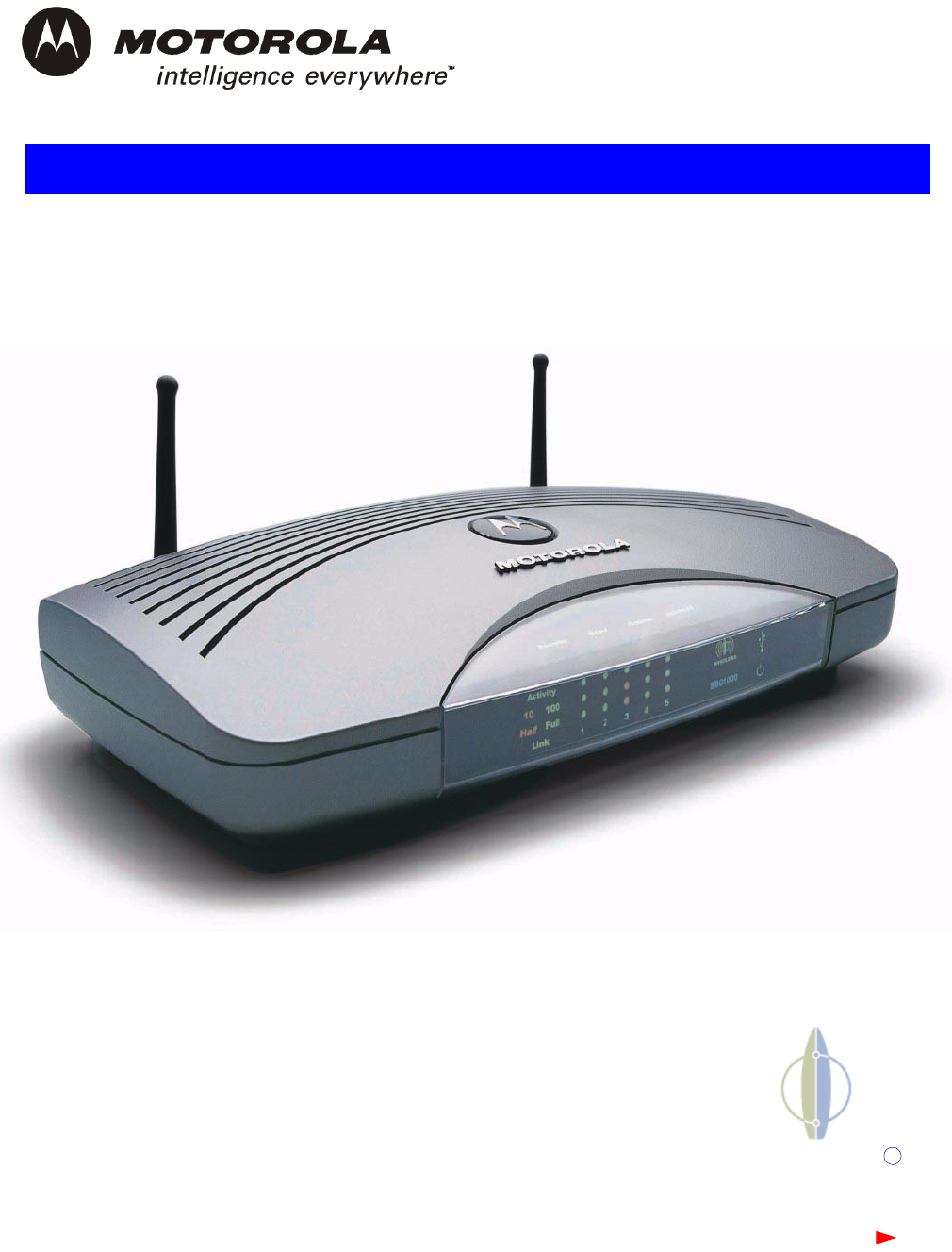ARRIS SBG1000-1 Cable Modem Gateway User Manual Master
ARRIS Group, Inc. Cable Modem Gateway Master
ARRIS >
Contents
- 1. Manual1
- 2. Manual2
Manual1

ii SBG1000 Wireless Cable Modem Gateway User Guide
Home
X
E
xitPrint
Overview Installation Troubleshooting Contact FAQ Specifications Glossary License
Configuration: Basic Gateway TCP/IP Wireless Print Server USB
WARNING: TO PREVENT FIRE OR SHOCK HAZARD, DO NOT EXPOSE THIS PRODUCT TO RAIN OR
MOISTURE. THE UNIT MUST NOT BE EXPOSED TO DRIPPING OR SPLASHING. DO NOT PLACE OBJECTS
FILLED WITH LIQUIDS, SUCH AS VASES, ON THE UNIT.
CAUTION: TO PREVENT ELECTRICAL SHOCK, THIS EQUIPMENT REQUIRES A GROUNDING
CONDUCTOR IN THE LINE CORD. THE LINE CORD PROVIDED WITH THE EQUIPMENT IS ACCEPTABLE
FOR USE WITH NEMA STYLE 5-15R AC RECEPTACLE SUPPLYING NOMINAL 120 VOLTS. DO NOT
CONNECT THE PLUG INTO AN EXTENSION CORD, RECEPTACLE, OR OTHER OUTLET UNLESS THE
PLUG CAN BE FULLY INSERTED WITH NO PART OF THE BLADES EXPOSED.
CAUTION: TO ENSURE REGULATORY AND SAFETY COMPLIANCE, USE ONLY THE PROVIDED POWER
AND INTERFACE CABLES.
CAUTION: DO NOT OPEN THE UNIT. DO NOT PERFORM ANY SERVICING OTHER THAN THAT CONTAINED
IN THE INSTALLATION AND TROUBLESHOOTING INSTRUCTIONS. REFER ALL SERVICING TO QUALIFIED
SERVICE PERSONNEL.
CAUTION: CHANGES AND MODIFICATIONS NOT EXPRESSLY APPROVED BY MOTOROLA FOR
COMPLIANCE COULD VOID USER’S AUTHORITY TO OPERATE THE EQUIPMENT.
CAUTION: Exposure to Radio Frequency Radiation. To comply with the FCC RF exposure compliance
requirements, the separation distance between the antenna and any person’s body (including hands, wrists, feet
and ankles) must be at least 20 cm (8 inches).
This device complies with part 15 of the FCC Rules. Operation is subject to the following two conditions: (1) This
device may not cause harmful interference, and (2) this device must accept any interference received, including
interference that may cause undesired operation.
Note: This equipment has been tested and found to comply with the limits for a Class B digital device, pursuant to
part 15 of the FCC Rules. These limits are designed to provide reasonable protection against harmful interference
in a residential installation. This equipment generates, uses and can radiate radio frequency energy and, if not
installed and used in accordance with the instructions, may cause harmful interference to radio communications.
However, there is no guarantee that interference will not occur in a particular installation. If this equipment does
cause harmful interference to radio or television reception, which can be determined by turning the equipment off
and on, the user is encouraged to try to correct the interference by one or more of the following measures:
•Reorient or relocate the receiving antenna.
•Increase the separation between the equipment and receiver.
•Connect the equipment into an outlet on a circuit different from that to which the receiver is connected.
•Consult the dealer or an experienced radio/TV technician for help.
This device must be installed and used in strict accordance with the manufacturer’s instructions as described in
the user documentation that comes with the product.
Postpone cable modem installation until there is no risk of thunderstorm or lightning activity in the area.
Do not overload outlets or extension cords, as this can result in a risk of fire or electric shock. Overloaded AC
outlets, extension cords, frayed power cords, damaged or cracked wire insulation, and broken plugs are
dangerous. They may result in a shock or fire hazard.
Route power supply cords so that they are not likely to be walked on or pinched by items placed upon or against
them. Pay particular attention to cords where they are attached to plugs and convenience receptacles, and
examine the point where they exit from the product.
Place this equipment in a location that is close enough to an electrical outlet to accommodate the length of the
power cord.

iii SBG1000 Wireless Cable Modem Gateway User Guide
Home
X
E
xitPrint
Overview Installation Troubleshooting Contact FAQ Specifications Glossary License
Configuration: Basic Gateway TCP/IP Wireless Print Server USB
Place this equipment on a stable surface.
Be sure that the outside cable system is grounded, so as to provide some protection against voltage surges and
built-up static charges. Article 820-20 of the NEC (Section 54, Part I of the Canadian Electrical Code) provides
guidelines for proper grounding and, in particular, specifies the CATV cable ground shall be connected in the
grounding system of the building, as close to the point of cable entry as practical.
When using this device, basic safety precautions should always be followed to reduce the risk of fire, electric
shock and injury to persons, including the following:
•Read all of the instructions {listed here and/or in the user manual} before you operate this equipment. Give
particular attention to all safety precautions. Retain the instructions for future reference.
•Comply with all warning and caution statements in the instructions. Observe all warning and caution symbols
that are affixed to this equipment.
•Comply with all instructions that accompany this equipment.
•Avoid using this product during an electrical storm. There may be a risk of electric shock from lightning. For
added protection for this product during a lightning storm, or when it is left unattended and unused for long
periods of time, unplug it from the wall outlet, and disconnect the cable system. This will prevent damage to
the product due to lightning and power surges.
•Avoid damaging the cable modem with static by touching the coaxial cable when it is attached to the earth
grounded coaxial cable TV wall outlet.
•Always first touch the coaxial cable connector on the cable modem when disconnecting or re-connecting USB
or Ethernet cable from the cable modem or the user’s PC.
•Operate this product only from the type of power source indicated on the product’s marking label. If you are
not sure of the type of power supplied to your home, consult your dealer or local power company.
•Upon completion of any service or repairs to this products, ask the service technician to perform safety
checks to determine that the product is in safe operating condition.
It is recommended that the customer install an AC surge protector in the AC outlet to which this device is
connected. This is to avoid damaging the equipment by local lightning strikes and other electrical surges.
Different types of cord sets may be used for connections to the main supply circuit. Use only a main line cord that
complies with all applicable product safety requirements of the country of use.
Installation of this product must be in accordance with national wiring codes.
Place unit to allow for easy access when disconnecting the power cord/adapter of the device from the AC wall
outlet.
Wipe the unit with a clean, dry cloth. Never use cleaning fluid or similar chemicals. Do not spray cleaners directly
on the unit or use forced air to remove dust.
This product was qualified under test conditions that included the use of the supplied cables between system
components. To be in compliance with regulations, the user must use these cables and install them properly.
Connect the unit to a grounding type AC wall outlet (100-240 V AC) using the standard power cord/adapter as
supplied with the unit.
Do not cover the device, or block the airflow to the device with any other objects. Keep the device away from
excessive heat and humidity and keep the device free from vibration and dust.
Installation must at all times conform to local regulations.

iv SBG1000 Wireless Cable Modem Gateway User Guide
Home
X
E
xitPrint
Overview Installation Troubleshooting Contact FAQ Specifications Glossary License
Configuration: Basic Gateway TCP/IP Wireless Print Server USB
This product is provided with a separate Regulatory, Safety, Software License, and Warranty Information card. If
one is not provided with this product, please ask your service provider or point-of-purchase representative, as the
case may be.
•THIS PRODUCT IS IN COMPLIANCE WITH ONE OR MORE OF THE STANDARDS LISTED ON THE
REGULATORY, SAFETY, SOFTWARE LICENSE, AND WARRANTY INFORMATION CARD. NOT ALL
STANDARDS APPLY TO ALL MODELS.
•NO WARRANTIES OF ANY KIND ARE PROVIDED BY MOTOROLA WITH RESPECT TO THIS PRODUCT,
EXCEPT AS STATED ON THE REGULATORY, SAFETY, SOFTWARE LICENSE, AND WARRANTY
INFORMATION CARD. MOTOROLA’S WARRANTIES DO NOT APPLY TO PRODUCT THAT HAS BEEN
REFURBISHED OR REISSUED BY YOUR SERVICE PROVIDER.
This device complies with part 15 of the FCC Rules. Operation is subject to the following two conditions: (1) This
device may not cause harmful interference, and (2) this device must accept any interference received, including
interference that may cause undesired operation.
Note: This equipment has been tested and found to comply with the limits for a Class B digital device, pursuant to
part 15 of the FCC Rules. These limits are designed to provide reasonable protection against harmful interference
in a residential installation. This equipment generates, uses and can radiate radio frequency energy and, if not
installed and used in accordance with the instructions, may cause harmful interference to radio communications.
However, there is no guarantee that interference will not occur in a particular installation. If this equipment does
cause harmful interference to radio or television reception, which can be determined by turning the equipment off
and on, the user is encouraged to try to correct the interference by one or more of the following measures:
--Reorient or relocate the receiving antenna.
--Increase the separation between the equipment and the receiver.
--Connect the equipment into an outlet on a circuit different from that to which the receiver is connected.
--Consult the dealer or an experienced radio/TV technician for help.
Copyright © 2002 by Motorola, Inc.
All rights reserved. No part of this publication may be reproduced in any form or by any means or used to make any derivative work (such as
translation, transformation or adaptation) without written permission from Motorola, Inc.
Motorola reserves the right to revise this publication and to make changes in content from time to time without obligation on the part of Motorola
to provide notification of such revision or change. Motorola provides this guide without warranty of any kind, either implied or expressed,
including, but not limited to, the implied warranties of merchantability and fitness for a particular purpose. Motorola may make improvements or
changes in the product(s) described in this manual at any time.
MOTOROLA and the Stylized M Logo are registered in the US Patent & Trademark Office. Microsoft and Windows are registered trademarks and
Windows Me and Windows XP are trademarks of
Microsoft Corporation. Microsoft Windows screen shots are used by permission of Microsoft
Corporation.
Macintosh and AppleTalk are registered
trademarks
of Apple Computer, Inc. Iomega is a registered trademark of Iomega
Corporation. Linux is a registered trademark of Linus Torvalds. Acrobat Reader is a registered trademark of Adobe Systems, Inc. Netscape and
Navigator are registered trademarks of
Netscape Communications Corporation
. UNIX is a registered trademark of the Open Group in the United
States and other countries. All other
product or service names are the property of their respective owners. © Motorola, Inc. 2002.

vSBG1000 Wireless Cable Modem Gateway User Guide
Home
X
E
xitPrint
Overview Installation Troubleshooting Contact FAQ Specifications Glossary License
Configuration: Basic Gateway TCP/IP Wireless Print Server USB
Contents
Overview . . . . . . . . . . . . . . . . . . . . . . . . . . . 1
Powerful Features in a Single Unit . . . . . . . . . . . . . . . . . 2
Easy Setup . . . . . . . . . . . . . . . . . . . . . . . . . . . . . . . . . . . 2
Sample LAN . . . . . . . . . . . . . . . . . . . . . . . . . . . . . . . . . . 3
Optional Accessories . . . . . . . . . . . . . . . . . . . . . . . . . . . 4
Front Panel . . . . . . . . . . . . . . . . . . . . . . . . . . . . . . . . . . 6
Rear Panel . . . . . . . . . . . . . . . . . . . . . . . . . . . . . . . . . . . 8
Label on the Bottom of the Unit . . . . . . . . . . . . . . . . . . . 9
Wiring the SBG1000 LAN . . . . . . . . . . . . . . . . . . . . . . . 9
Wired Ethernet LAN . . . . . . . . . . . . . . . . . . . . . . . . . 10
USB Connection . . . . . . . . . . . . . . . . . . . . . . . . . . . . 12
HPNA LAN . . . . . . . . . . . . . . . . . . . . . . . . . . . . . . . . 13
IEEE 802.11b Wireless LAN . . . . . . . . . . . . . . . . . . 14
Security . . . . . . . . . . . . . . . . . . . . . . . . . . . . . . . . . . . . 15
Firewall . . . . . . . . . . . . . . . . . . . . . . . . . . . . . . . . . . . 15
DMZ . . . . . . . . . . . . . . . . . . . . . . . . . . . . . . . . . . . . . 16
Wireless Security . . . . . . . . . . . . . . . . . . . . . . . . . . . 16
Virtual Private Networks . . . . . . . . . . . . . . . . . . . . . . . . 16
Print Server . . . . . . . . . . . . . . . . . . . . . . . . . . . . . . . . . 17
Related Documentation . . . . . . . . . . . . . . . . . . . . . . . . 17
Installation. . . . . . . . . . . . . . . . . . . . . . . . . 19
Before You Begin . . . . . . . . . . . . . . . . . . . . . . . . . . . . . 19
Precautions . . . . . . . . . . . . . . . . . . . . . . . . . . . . . . . . . 20
Signing Up for Service . . . . . . . . . . . . . . . . . . . . . . . . . 21
Computer System Requirements . . . . . . . . . . . . . . . . . 21
Connecting the SBG1000 to the Cable System . . . . . . 22
Cabling the Ethernet or HPNA LAN . . . . . . . . . . . . . . . 23
Obtaining an IP address in Windows 98, Windows 98
SE, or Windows Me . . . . . . . . . . . . . . . . . . . . . 23
Obtaining an IP address in Windows 2000 or
Windows XP . . . . . . . . . . . . . . . . . . . . . . . . . . . 23
Obtaining an IP address on Macintosh or UNIX Systems
23
Connecting a PC to the USB Port . . . . . . . . . . . . . . . . 24
Setting Up the Wireless LAN . . . . . . . . . . . . . . . . . . . . 24
Connecting the Printer . . . . . . . . . . . . . . . . . . . . . . . . . 24
Wall Mounting the Wireless Gateway . . . . . . . . . . . . . 25
Wall Mounting Template . . . . . . . . . . . . . . . . . . . . . 27
Installing the Optional External Diversity Antenna . . . . 28
Configuring the SBG1000 . . . . . . . . . . . . 31
Starting the SBG1000 Setup Program . . . . . . . . . . . . . 32
Changing the Default Password . . . . . . . . . . . . . . . . . 34
Getting Help . . . . . . . . . . . . . . . . . . . . . . . . . . . . . . . . . 35
Setting the Firewall Policy . . . . . . . . . . . . . . . . . . . . . . 36
Firewall Pages in the SBG1000 Setup Program . . . . . 37
Firewall > POLICY — basic Page . . . . . . . . . . . . . . 38
Firewall > POLICY — advanced Page . . . . . . . . . . 39
Firewall > ALERT — basic Page . . . . . . . . . . . . . . . 40
Firewall > ALERT — email Page . . . . . . . . . . . . . . . 41
Firewall > LOGS Page . . . . . . . . . . . . . . . . . . . . . . 42
Configuring the Gateway . . . . . . . . . . . . . 43
Gateway > STATUS Page . . . . . . . . . . . . . . . . . . . . . 44
Gateway > WAN Page . . . . . . . . . . . . . . . . . . . . . . . . 45
Gateway > LAN — nat config Page . . . . . . . . . . . . . . 47
Gateway > LAN — dhcp server config Page . . . . . . . . 48
Gateway > LAN — dhcp reservations Page . . . . . . . . 49
Gateway > ALG — basic Page . . . . . . . . . . . . . . . . . . 50
Gateway > ALG — advanced Page . . . . . . . . . . . . . . 50
Gateway > LOG Page . . . . . . . . . . . . . . . . . . . . . . . . . 51
Configuring TCP/IP. . . . . . . . . . . . . . . . . . 53
Configuring TCP/IP in Windows 95, Windows 98, or
Windows Me . . . . . . . . . . . . . . . . . . . . . . . . . . . . . . . . 54
Configuring TCP/IP in Windows 2000 . . . . . . . . . . . . . 56
Configuring TCP/IP in Windows XP . . . . . . . . . . . . . . 60
Verifying the IP Address in Windows 95, Windows 98,
or Windows Me . . . . . . . . . . . . . . . . . . . . . . . . . . . . . . 64
Verifying the IP Address in Windows 2000 or Windows XP
65
Setting Up the Wireless LAN . . . . . . . . . . 67
Configuring a Unique Wireless Network Name . . . . . . 68
Configuring Basic Wireless LAN Security . . . . . . . . . . 69
Configuring Wireless Clients . . . . . . . . . . . . . . . . . . . . 70
Wireless Pages in the SBG1000 Setup Program . . . . 70
Wireless > STATUS Page . . . . . . . . . . . . . . . . . . . . 71
Wireless > NETWORK Page . . . . . . . . . . . . . . . . . . 72
Wireless > SECURITY — basic Page . . . . . . . . . . . 73
Wireless > SECURITY — advanced Page . . . . . . . 74
Wireless > STATISTICS page . . . . . . . . . . . . . . . . . 75
Configuring the Print Server . . . . . . . . . . 77
Configuring the SBG1000 Print Server . . . . . . . . . . . . 77
Printer > CONFIGURATION — Microsoft smb Page 78
Printer > CONFIGURATION — Apple Page . . . . . . 79
Printer > CONFIGURATION — lpr Page . . . . . . . . . 80
Adding a Printer in Windows 98 or Windows Me . . . . 80
Adding a Printer in Windows 2000 . . . . . . . . . . . . . . . 86

vi SBG1000 Wireless Cable Modem Gateway User Guide
Home
X
E
xitPrint
Overview Installation Troubleshooting Contact FAQ Specifications Glossary License
Configuration: Basic Gateway TCP/IP Wireless Print Server USB
Setting Up a USB Driver. . . . . . . . . . . . . . 95
Setting Up a USB Driver in Windows 98 . . . . . . . . . . .96
Setting Up a USB Driver in Windows 2000 . . . . . . . .100
Setting Up a USB Driver in Windows Me . . . . . . . . . .103
Setting Up a USB Driver in Windows XP . . . . . . . . . .104
Removing the USB Driver from Windows 98
or Windows Me . . . . . . . . . . . . . . . . . . . . . . . . . . . . . .105
Removing the USB Driver from Windows 2000 . . . . .108
Removing the USB Driver from Windows XP . . . . . . .111
Troubleshooting . . . . . . . . . . . . . . . . . . . 117
Front-Panel Lights and Error Conditions . . . . . . . . . .117
Contact Us. . . . . . . . . . . . . . . . . . . . . . . . 119
Frequently-Asked Questions. . . . . . . . . 121
Specifications . . . . . . . . . . . . . . . . . . . . . 123
General Specifications . . . . . . . . . . . . . . . . . . . . . . . .123
Cable Modem Specifications . . . . . . . . . . . . . . . . . . . 124
Glossary. . . . . . . . . . . . . . . . . . . . . . . . . . 125
Software License . . . . . . . . . . . . . . . . . . 143
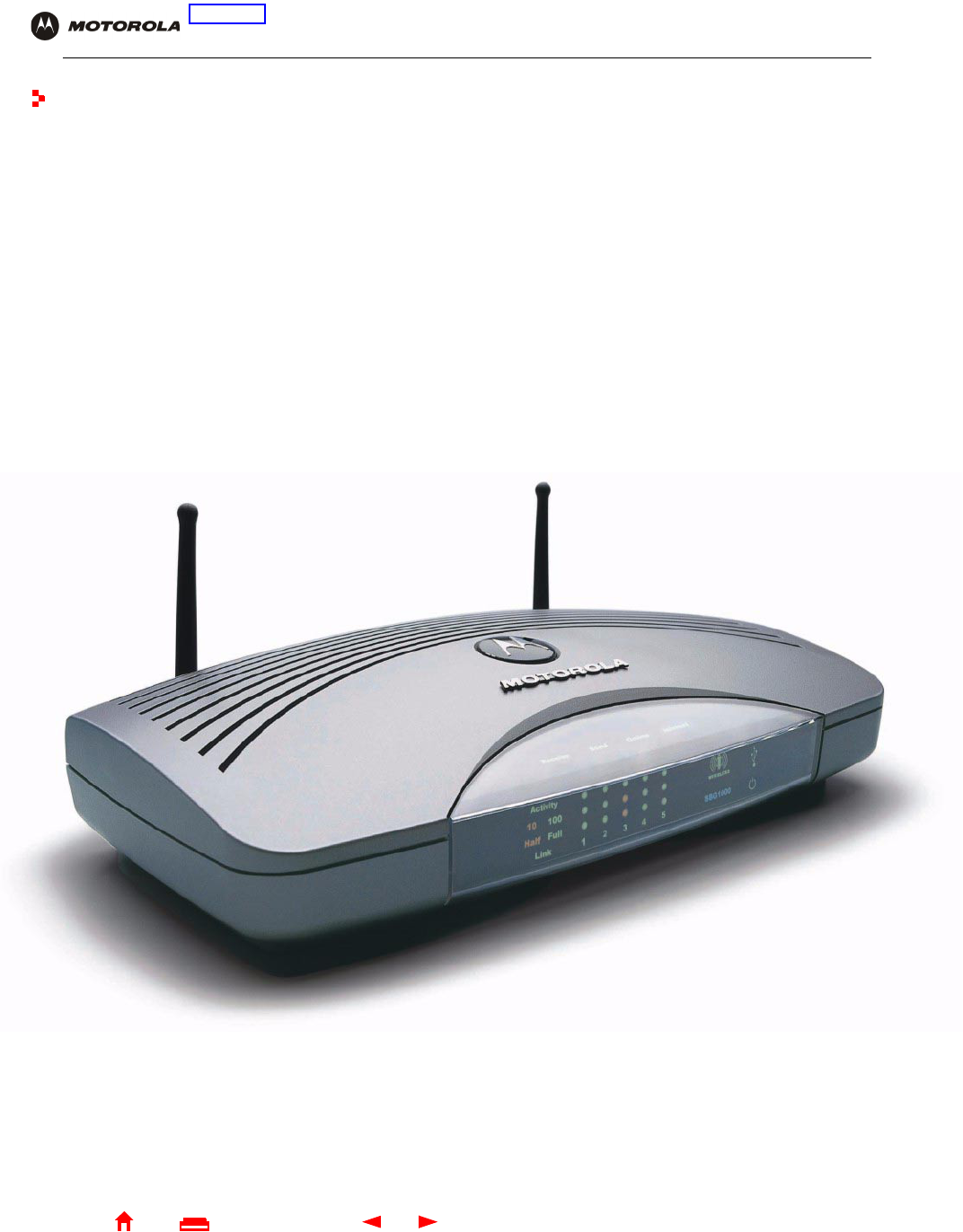
1SBG1000 Wireless Cable Modem Gateway User Guide
Home
X
E
xitPrint
Overview Installation Troubleshooting Contact FAQ Specifications Glossary License
Configuration: Basic Gateway TCP/IP Wireless Print Server USB
Overview
Thank you for purchasing the Motorola® SBG1000 Wireless Cable Modem Gateway. The SBG1000 combines a
SURFboard™ cable modem, IEEE 802.11b wireless access point, router with five-port 10/100Base-T switch, print
server, and an advanced firewall into one compact product. It is the perfect networking solution for the home,
home office, or small business/enterprise. You can create a custom network to share a single broadband
connection, files, printers, and other peripherals like scanners, with or without wires.
The SBG1000:
•Eliminates the need for five separate products, enabling you to maximize the potential of your existing
resources
•Offers enhanced network security for wired and wireless users
•Enables operators to add future value-added services
The features and physical appearance of your SBG1000 may differ slightly from the picture.
This product is subject to change. Not all features described in this User Guide are available on all SBG1000
models. For the most recent documentation, visit the Product Documentation page on www.motorola.com/
broadband.

2SBG1000 Wireless Cable Modem Gateway User Guide
Home
X
E
xitPrint
Overview Installation Troubleshooting Contact FAQ Specifications Glossary License
Configuration: Basic Gateway TCP/IP Wireless Print Server USB
Powerful Features in a Single Unit
The Motorola SBG1000 Wireless Cable Modem Gateway combines high-speed Internet access, networking, and
computer security for a home or small-office local area network (LAN). It provides:
•An integrated high-speed SURFboard cable modem for continuous broadband access to the Internet and
other online services, with much faster data transfer than traditional dial-up or ISDN modems.
•A router with a five-port 10/100Base-T Ethernet switch, supporting:
— Half- or full-duplex connections
— Five dual-purpose switch/uplink ports
— Auto-MDIX
•An IEEE 802.11b Wi-Fi certified wireless access point to enable laptop users to remain connected while
moving around the home or small office or to connect desktop computers without installing network wiring.
Depending on distance, wireless connection speeds can match that of Ethernet at 11 Mbps.
•An HPNA connection to connect computers to the LAN over existing telephone wiring — this provides the
advantage of using your existing phone lines for network wiring with up to 10 Mbps throughput.
•A USB connection for a single PC.
•A single broadband connection for up to 253 computers to surf the web; all computers on the Ethernet,
wireless, HPNA LAN, and USB communicate as if they were connected to the same physical network.
•A built-in DHCP server to easily configure a combined wired and/or wireless Class C private LAN.
•An advanced firewall, supporting:
—stateful-inspection
— Intrusion detection
—DMZ
— Denial-of-service attack prevention
— Network Address Translation (NAT)
•Virtual private network (VPN) pass-through operation supporting IPSec, PPTP, or L2TP to securely connect
remote computers over the Internet.
•A print server to enable Windows®, Macintosh®, UNIX®, and Linux® computers to share one or more printers.
Easy Setup
It is much easier to configure a LAN using the Motorola SBG1000 Wireless Cable Modem Gateway than it is using
typical networking equipment:
•The Installation Assistant application on the Motorola SBG1000 Wireless Cable Modem Gateway CD-ROM
enables easy connection to the cable network.
•For basic operation, most default settings require no modification.
•The Setup Program provides a graphical user interface (GUI) for easy configuration of necessary wireless,
Ethernet, router, DHCP, and security settings. For a list of important issues, see “Configuring the SBG1000”
on page 31.
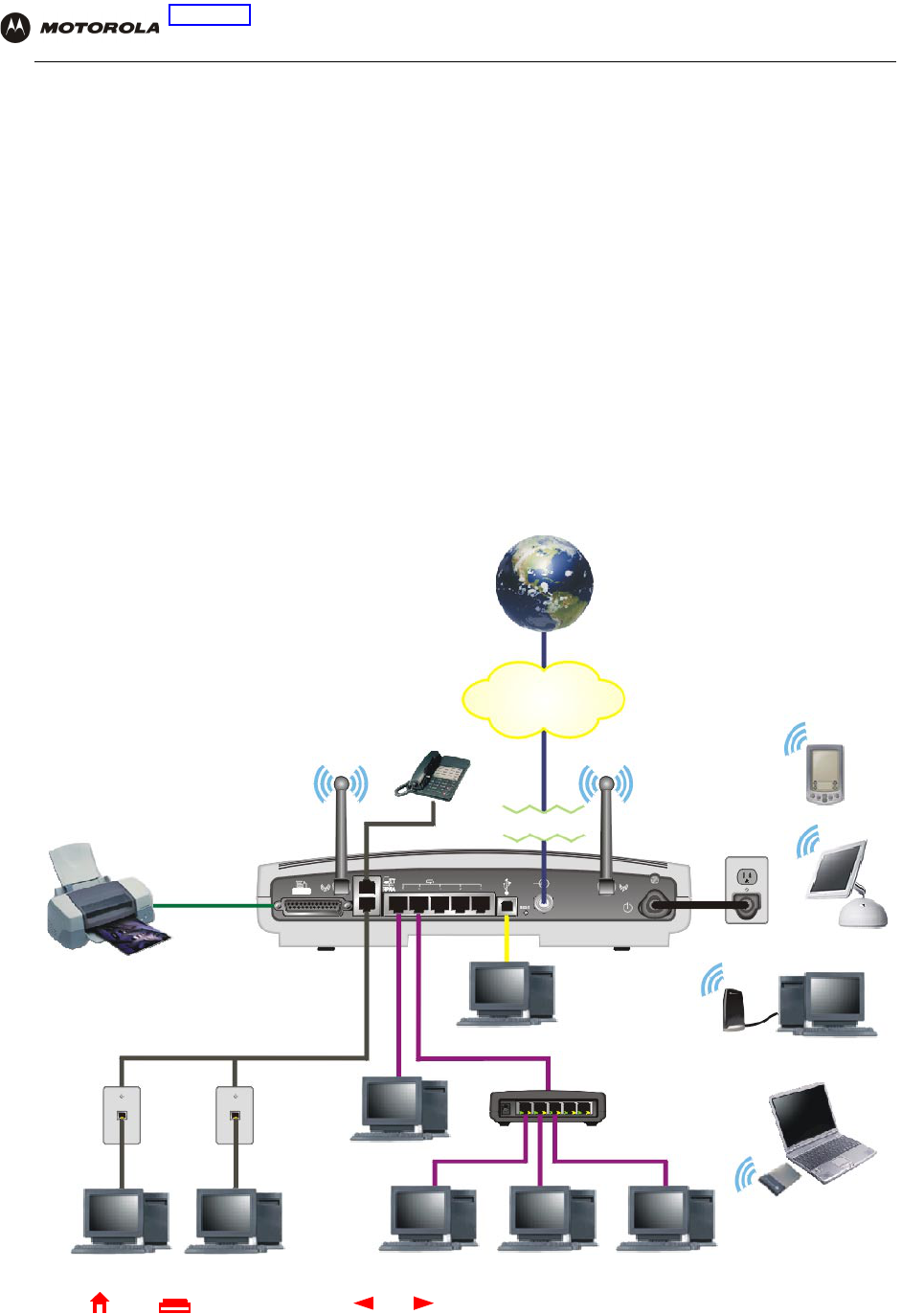
3SBG1000 Wireless Cable Modem Gateway User Guide
Home
X
E
xitPrint
Overview Installation Troubleshooting Contact FAQ Specifications Glossary License
Configuration: Basic Gateway TCP/IP Wireless Print Server USB
Sample LAN
The sample LAN shown in the figure contains the following devices, all protected by the SBG1000 firewall:
•A printer connected to the print server through the parallel connection
•A PDA connected through the wireless IEEE 802.11b connection
•One desktop Macintosh on a wireless connection
•One desktop PC on a wireless connection using a Motorola USB Adapter
•A laptop PC on a wireless connection connected using a Motorola PC Card
•One computer connected directly to Ethernet port one
•Three computers connected to Ethernet port two using a hub or switch
•Two computers connected over telephone wiring through HPNA
•One PC connected to the USB port
Sample SBG1000 hybrid network
Internet
High-speed HFC
cable network
IEEE 802.11b
wireless
HPNA
Parallel
Firewall
Ethernet
Hub or switch
SBG1000
USB to Ethernet
Wireless Adapter
PCC11B
Wireless Card
USB
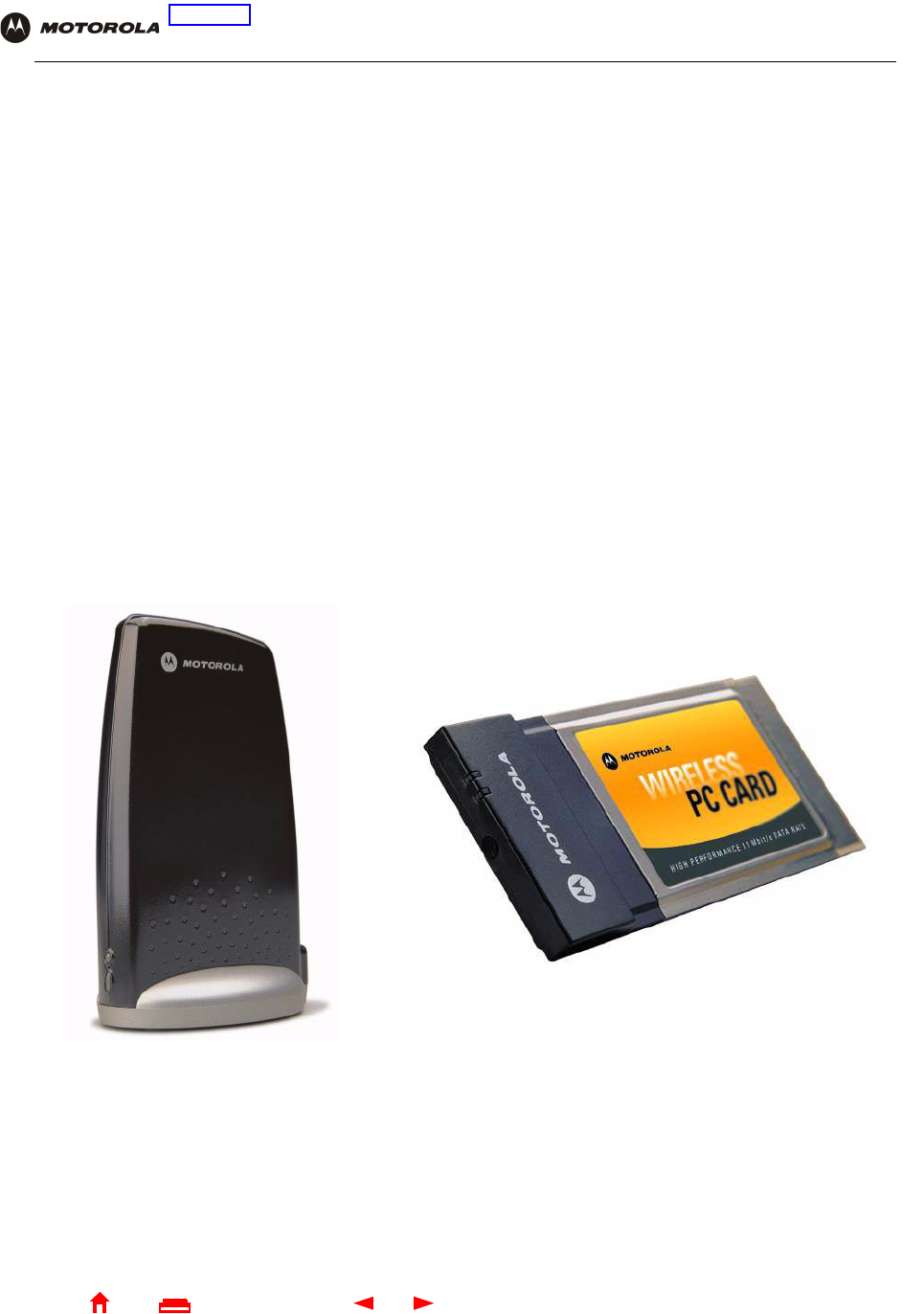
4SBG1000 Wireless Cable Modem Gateway User Guide
Home
X
E
xitPrint
Overview Installation Troubleshooting Contact FAQ Specifications Glossary License
Configuration: Basic Gateway TCP/IP Wireless Print Server USB
Optional Accessories
Accessories available for the Motorola SBG1000 Wireless Cable Modem Gateway include wireless adapters and
an external high-gain diversity antenna.
You can use the Motorola PCC11b wireless card or the USB11b wireless adapter, which comply with the
IEEE 802.11b wireless standard, to connect a PC to the wireless LAN:
Motorola USB11b Wireless Adapter (left) and PCC11b Wireless Card
For installation instructions, see the documentation provided with each product.
USB11b Wireless
Adapter Connects a desktop, laptop, printer, or other peripheral device to the wireless LAN. It has a
built-in antenna and a two meter (six feet) long cable that connects to the PC USB port.
Its light indicates:
•Off — Not connected to a USB port or not receiving power from the PC
•Yellow — Not installed or initializing
•Green — Installed and operational
•Flashing Green — Receiving data from another wireless LAN device
•Flashing Yellow — Transmitting data to another wireless LAN device
PCC11Bb Wireless Card A credit-card sized adapter that connects a laptop to the wireless LAN. You can roam in, or
around, the home or small office and remain connected. It fits in a PCMCIA Type II
standard slot on the laptop supporting 3.3 Volt PC card. The PCC11b has also has a
built-in antenna.
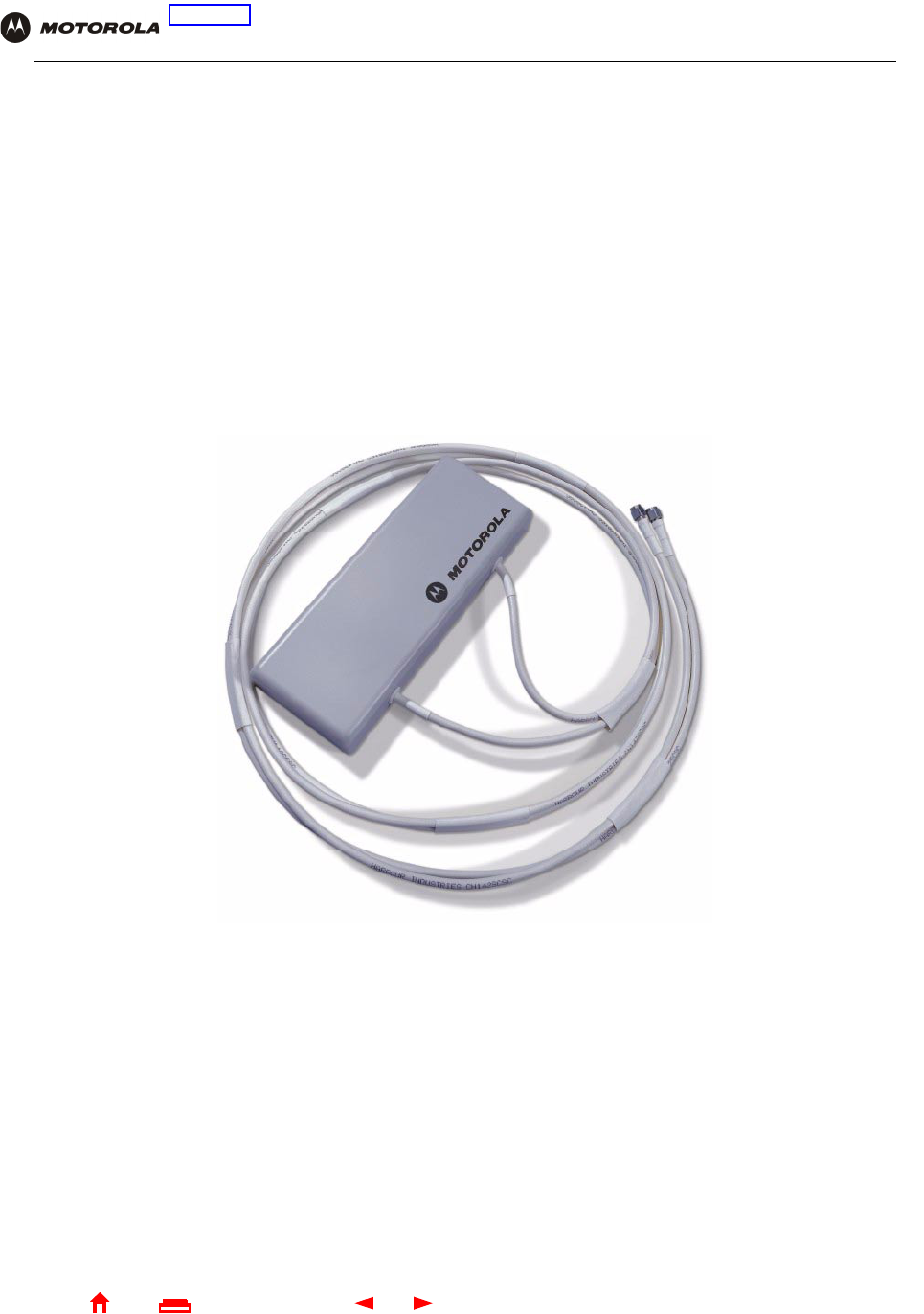
5SBG1000 Wireless Cable Modem Gateway User Guide
Home
X
E
xitPrint
Overview Installation Troubleshooting Contact FAQ Specifications Glossary License
Configuration: Basic Gateway TCP/IP Wireless Print Server USB
The Motorola External Diversity Antenna connects to the Motorola SBG1000 Wireless Cable Modem Gateway,
providing higher gain to increase wireless LAN performance and coverage, even in obstructed locations. The
External Diversity Antenna specifications are:
For information about connecting the external antenna, see “Installing the Optional External Diversity Antenna” on
page 28.
Motorola External Diversity Antenna
Frequency 2400 to 2500 MHz
Gain 5 dBi peak gain, nominal
Pattern Type Directional, vertically polarized
Connection Reverse-polarity TNC male, RG-142 cable
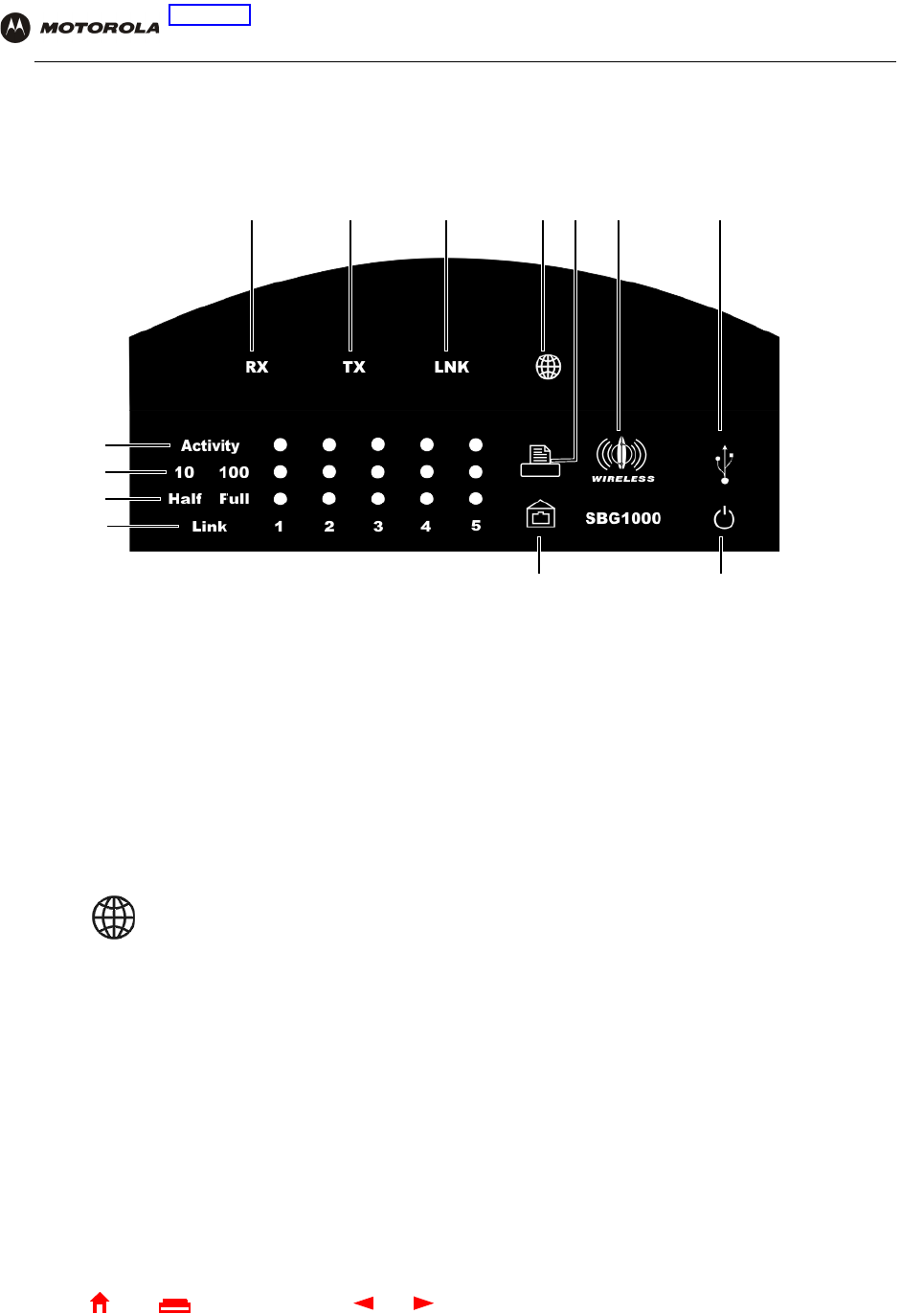
6SBG1000 Wireless Cable Modem Gateway User Guide
Home
X
E
xitPrint
Overview Installation Troubleshooting Contact FAQ Specifications Glossary License
Configuration: Basic Gateway TCP/IP Wireless Print Server USB
Front Panel
The front panel provides indicator lights. The model number on your SBG may be different than in some
illustrations and screen images.
Front-panel top section lights
Key Light Flashing On
1 RX (Receive) Scanning for a receive (downstream) channel
connection The downstream channel is connected
2 TX (Transmit) Scanning for a send (upstream) channel
connection
The upstream channel is connected
3 LNK (Link) Scanning for a network connection The startup process is complete and the
SBG1000 is online
4Transmitting or receiving data There is no solid on state
1234
10
7
12
56
13
11
8
9
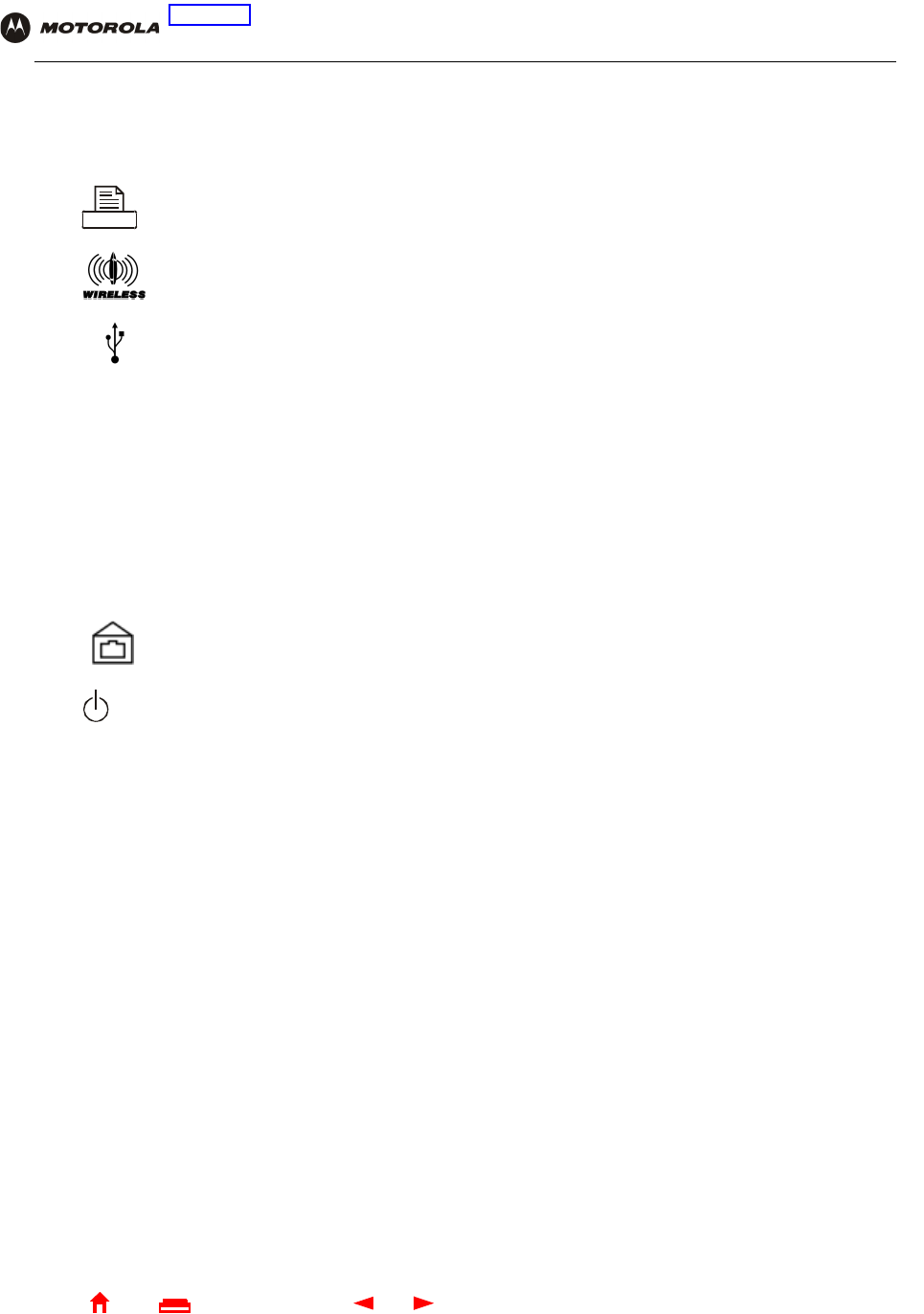
7SBG1000 Wireless Cable Modem Gateway User Guide
Home
X
E
xitPrint
Overview Installation Troubleshooting Contact FAQ Specifications Glossary License
Configuration: Basic Gateway TCP/IP Wireless Print Server USB
Front-panel bottom section lights
Key Light Flashing On
5Data transfer to printer Printer is connected
6Wireless activity Wireless feature is functioning normally
7USB activity There is a proper USB connection
8 Activity Ethernet activity on the port
910 100 none Indicates the LAN connection speed:
•Amber for a 10Base-T connection
•Green for a 100Base-T connection
10 Half Full none Indicates the LAN port duplex mode
•Amber for half duplex
•Green for full duplex
11 Link 1 to 5 No flashing mode There is a proper Ethernet connection to the port
12 Data transfer over phone line using HPNA There is no solid on state
13 Power No flashing mode The SBG1000 power supply is working properly
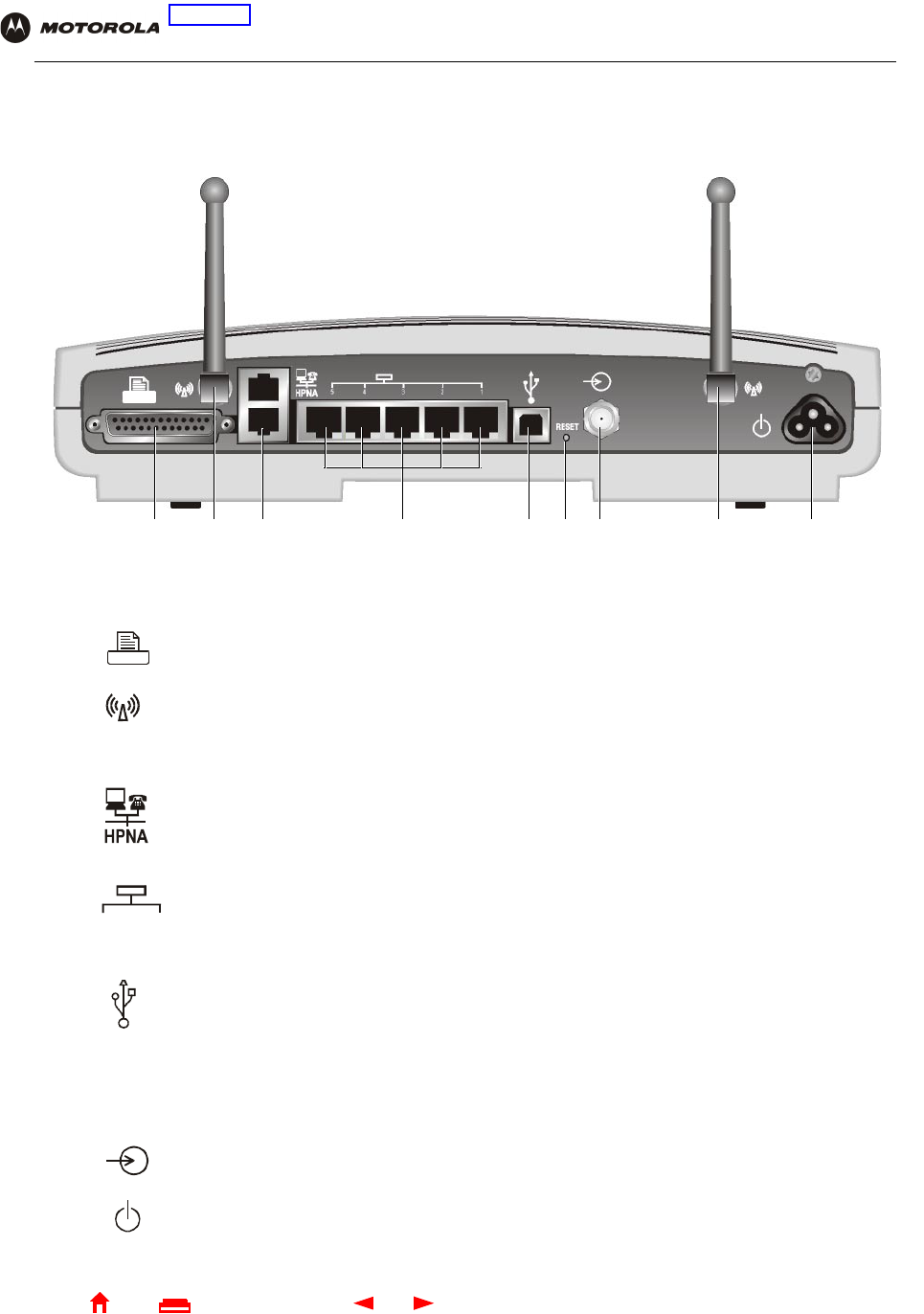
8SBG1000 Wireless Cable Modem Gateway User Guide
Home
X
E
xitPrint
Overview Installation Troubleshooting Contact FAQ Specifications Glossary License
Configuration: Basic Gateway TCP/IP Wireless Print Server USB
Rear Panel
The rear panel provides cabling connectors, status lights, and the power receptacle:
Key Item Description
1The printer port provides a connection for one printer.
2The Motorola SBG1000 Wireless Cable Modem Gateway includes two antennas. The optional
Motorola External Diversity Antenna provides higher gain to increase wireless LAN performance and
coverage. For information about the External Diversity Antenna, see “Optional Accessories” on
page 4.
3Use the HPNA ports to connect an HPNA LAN:
•Connect the bottom HPNA port to the telephone jack using the supplied telephone wire terminated
with RJ-11 connectors.
•You can connect a telephone to the top HPNA port.
4Use Ethernet ports 1 to 5 to connect an Ethernet LAN cable with RJ-45 connectors. You can connect
Ethernet-equipped computers, hubs, bridges, or switches.
5Use the USB port for Connecting a PC to the USB Port (see page 24).
6•If you experience a problem, you can push this recessed button to restart the SBG1000 (see
“Troubleshooting” on page 117). To reset all values to their defaults, hold down the button for more
than five seconds. Resetting may take 5 to 30 minutes because the SBG1000 must find and lock on
the appropriate communications channels.
7The cable port provides a connection to the coaxial cable outlet.
8The power connector provides power to the SBG1000.
1 3 46 85 72 2
5
1
…
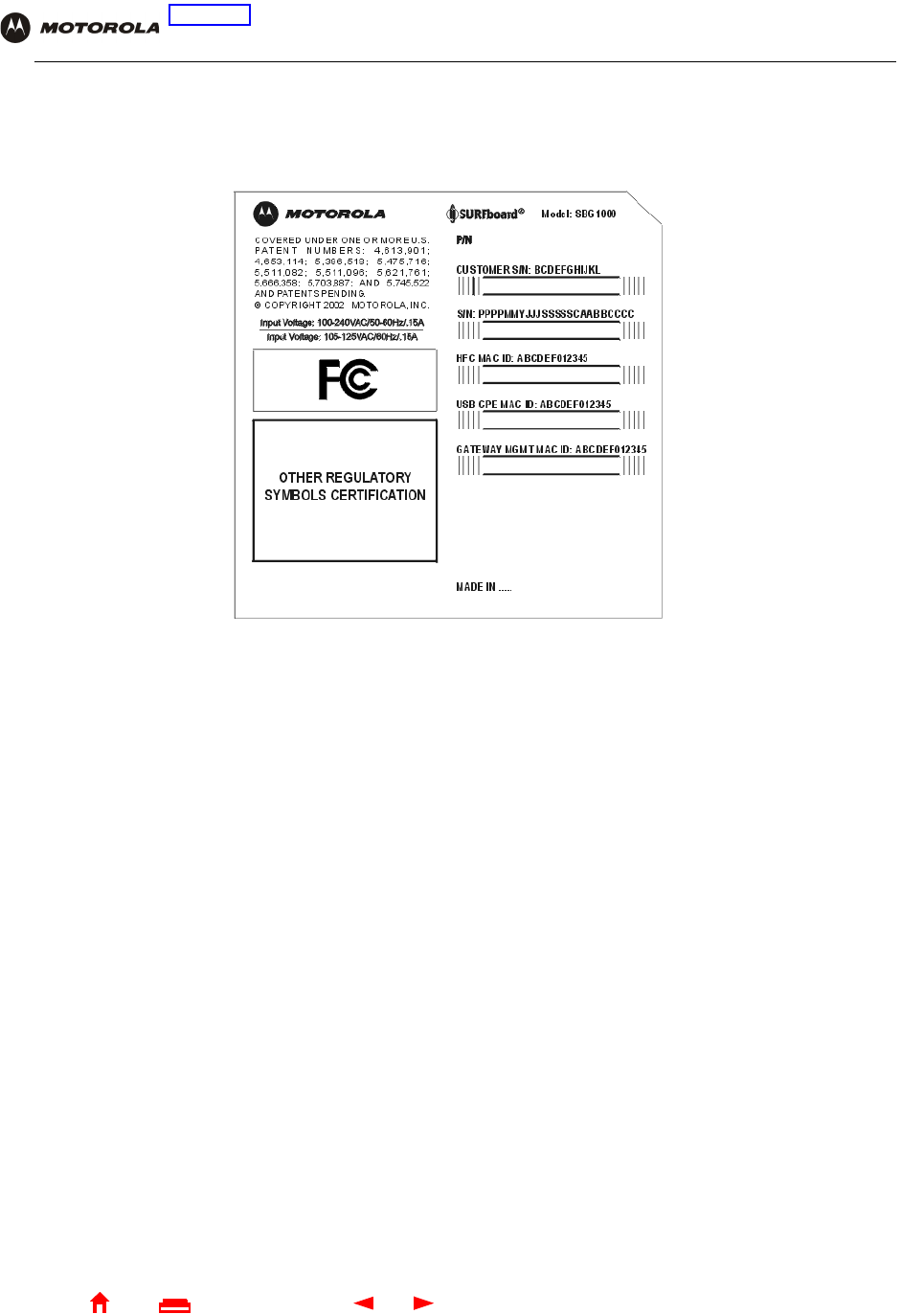
9SBG1000 Wireless Cable Modem Gateway User Guide
Home
X
E
xitPrint
Overview Installation Troubleshooting Contact FAQ Specifications Glossary License
Configuration: Basic Gateway TCP/IP Wireless Print Server USB
Label on the Bottom of the Unit
To receive data service, you need to provide the MAC address marked HFC MAC ID to your cable service
provider:
Wiring the SBG1000 LAN
The Motorola SBG1000 Wireless Cable Modem Gateway enables connection of a Class C network with up to 253
client computers and other IEEE 802.11b compliant devices on a combination of:
•10/100Base-T Ethernet
•IEEE 802.11b wireless networking
•HPNA V2.0
•USB V1.1
Each computer needs appropriate network adapter hardware and driver software. The clients on the Ethernet,
wireless, HPNA, or USB interfaces can share:
•Internet access with a single cable service provider account
(subject to network operator terms and conditions)
•Files, printers, storage devices, multi-user software applications, games, and video conferencing
Wireless and wired network connections use Windows networking to share files and peripheral devices such as
printers, CD-ROM drives, floppy disk drives, and Iomega® Zip Drives.
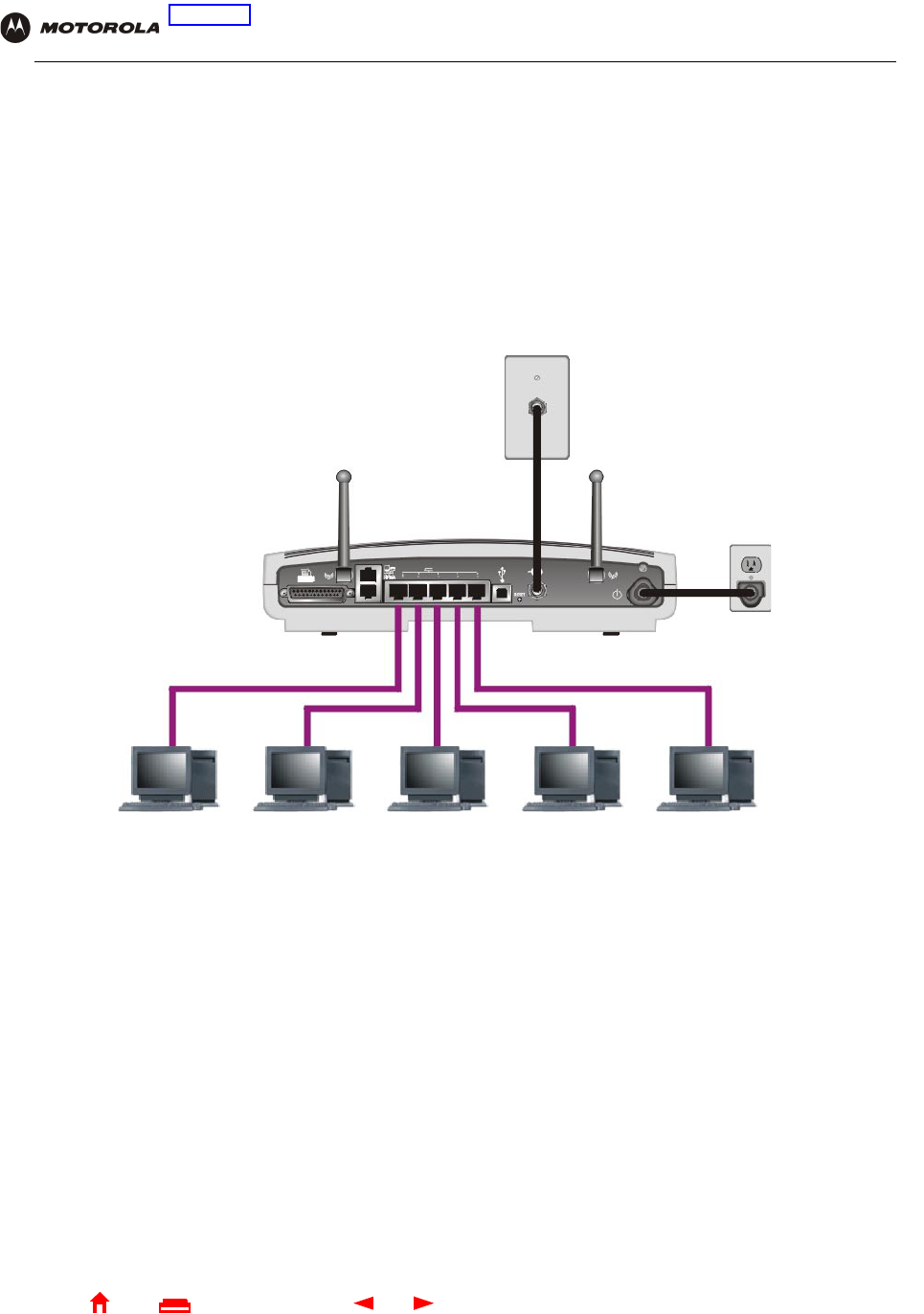
10 SBG1000 Wireless Cable Modem Gateway User Guide
Home
X
E
xitPrint
Overview Installation Troubleshooting Contact FAQ Specifications Glossary License
Configuration: Basic Gateway TCP/IP Wireless Print Server USB
Wired Ethernet LAN
Each computer on the Ethernet LAN requires an Ethernet network interface card (NIC) and driver software
installed.
Because the Motorola SBG1000 Wireless Cable Modem Gateway Ethernet ports support auto-MDIX, you can use
either straight-through or cross-over cable to connect a hub, switch, or computer. Use category 5 cabling for all
Ethernet connections.
The physical wiring arrangement has no connection to the logical network allocation of IP addresses.
Sample SBG1000 Ethernet network connections
Coaxial cable
Ethernet cable
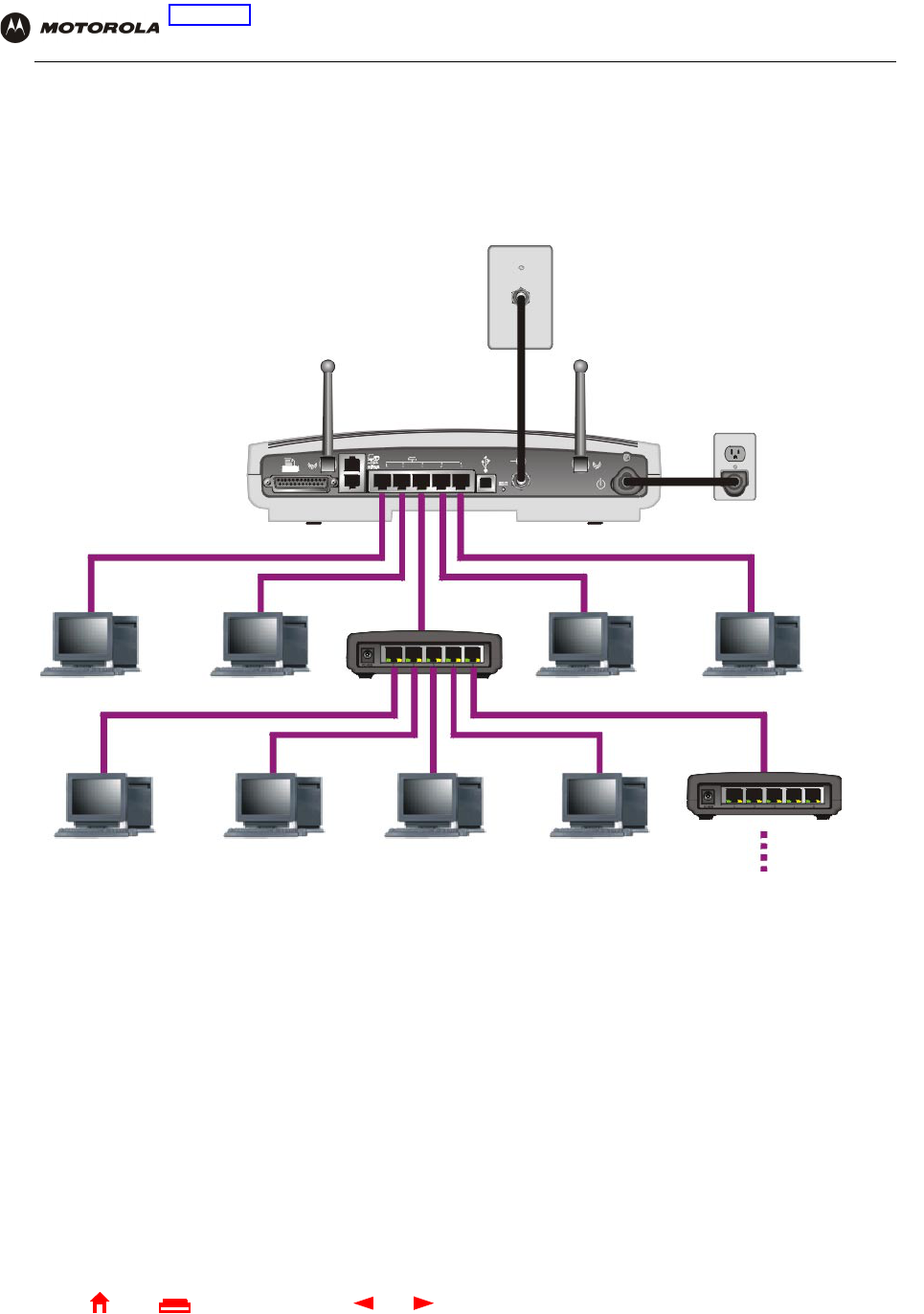
11 SBG1000 Wireless Cable Modem Gateway User Guide
Home
X
E
xitPrint
Overview Installation Troubleshooting Contact FAQ Specifications Glossary License
Configuration: Basic Gateway TCP/IP Wireless Print Server USB
A wired Ethernet LAN with more than five computers requires one or more hubs or switches. You can connect a
hub or switch to any Ethernet port on the Motorola SBG1000 Wireless Cable Modem Gateway.
The following illustration is an example of an Ethernet LAN you can set up using the Motorola SBG1000 Wireless
Cable Modem Gateway. You should cable the Ethernet LAN in an appropriate manner for the site. A complete
discussion of Ethernet cabling is beyond the scope of this document.
You can connect a hub or switch to any Ethernet port on the Motorola SBG1000 Wireless Cable Modem Gateway.
Add additional hubs or switches
for further expansion
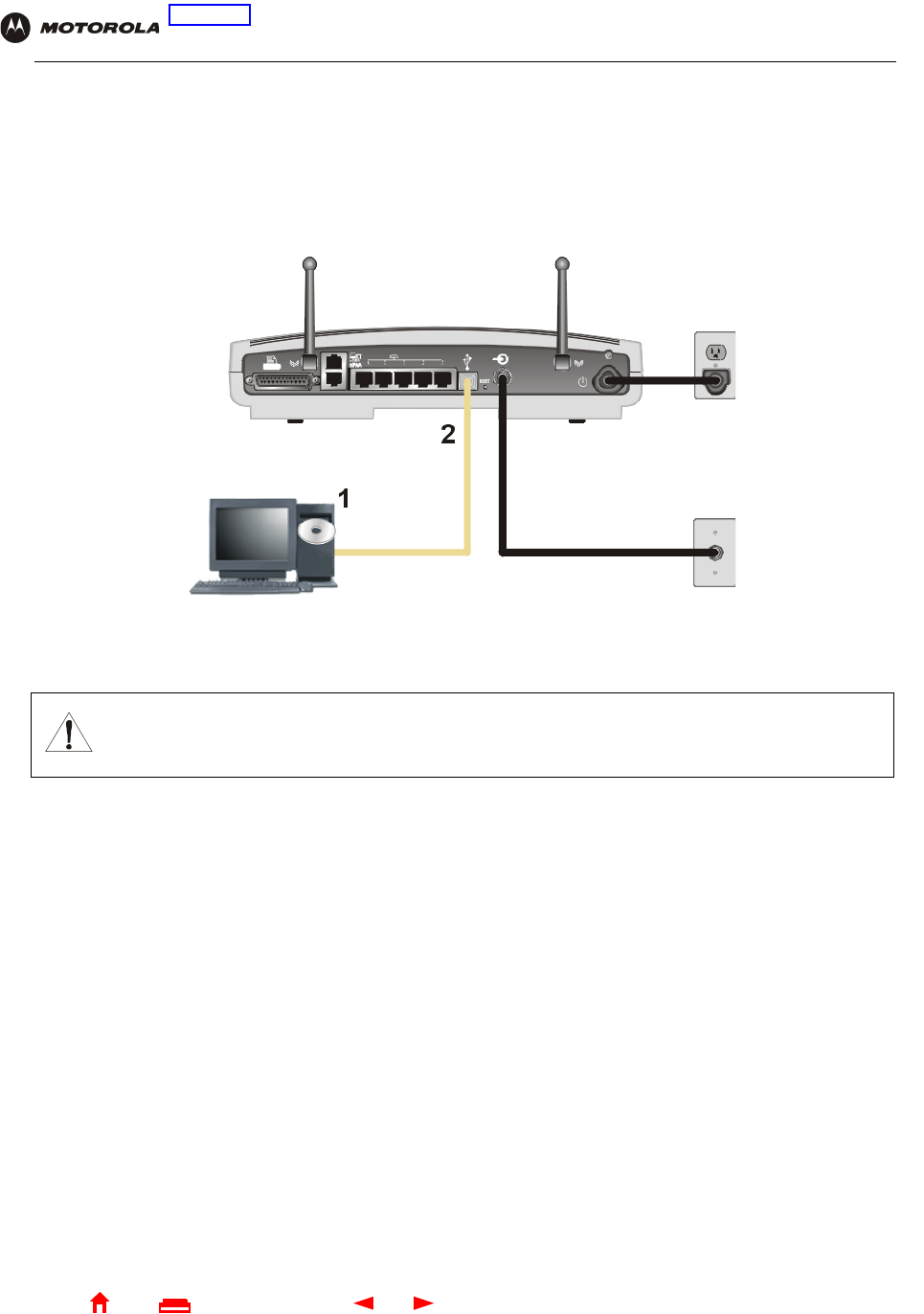
12 SBG1000 Wireless Cable Modem Gateway User Guide
Home
X
E
xitPrint
Overview Installation Troubleshooting Contact FAQ Specifications Glossary License
Configuration: Basic Gateway TCP/IP Wireless Print Server USB
USB Connection
You can connect a single PC running Windows®98, Windows XP™, Windows Me®, or Windows®2000 to the
Motorola SBG1000 Wireless Cable Modem Gateway USB port. For cabling instructions, see “Connecting a PC to
the USB Port” on page 24.
Sample USB connection.
Caution!
Before plugging in the USB cable, be sure the Motorola SBG1000 Wireless Cable Modem Gateway
CD-ROM is inserted in the PC CD-ROM drive.
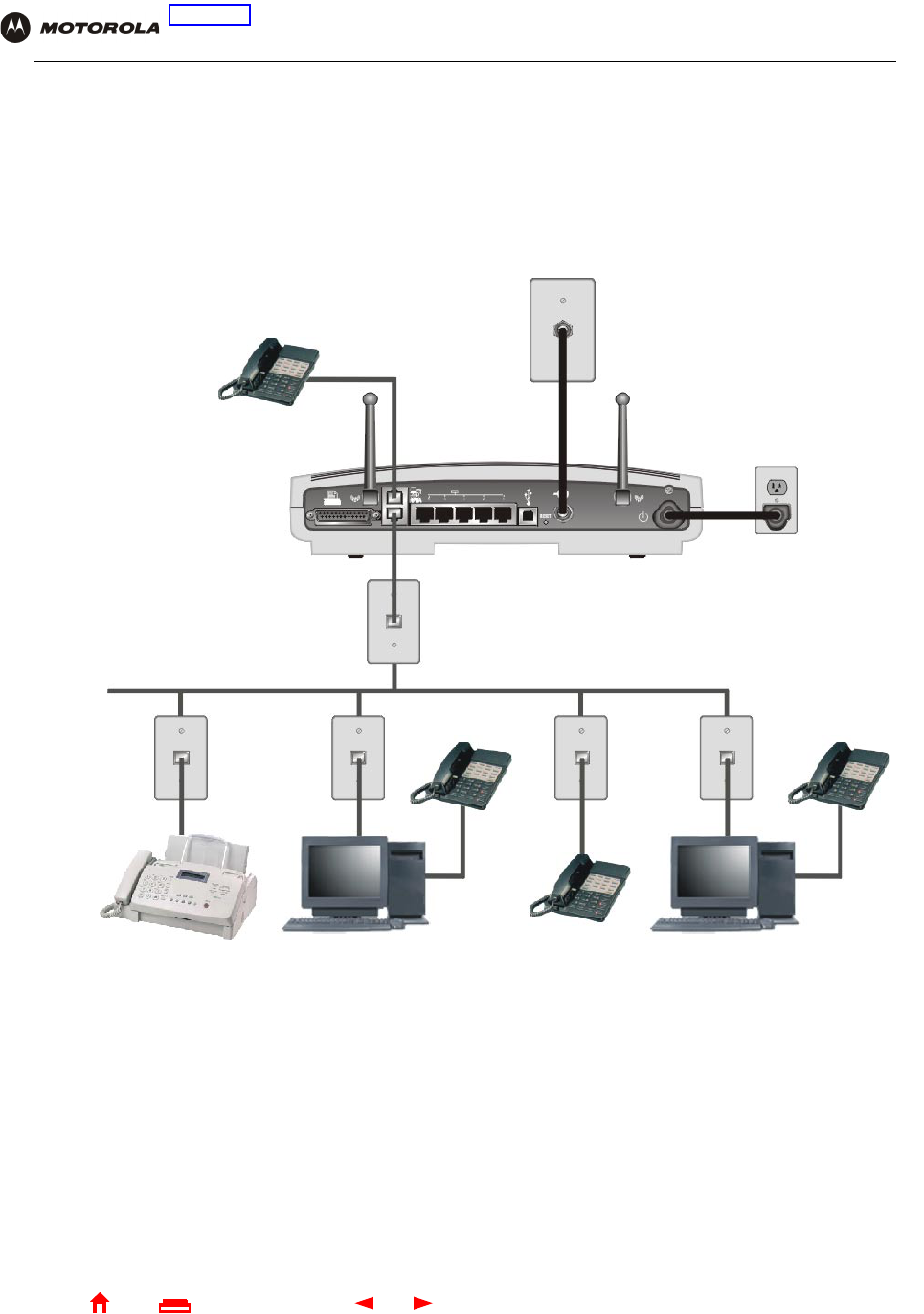
13 SBG1000 Wireless Cable Modem Gateway User Guide
Home
X
E
xitPrint
Overview Installation Troubleshooting Contact FAQ Specifications Glossary License
Configuration: Basic Gateway TCP/IP Wireless Print Server USB
HPNA LAN
To eliminate the need to install network wiring, the Motorola SBG1000 Wireless Cable Modem Gateway provides
a Home Phoneline Network Alliance (HPNA or HomePNA) connection. HPNA networks use existing telephone
lines to connect the computers without interfering with telephone voice service, DSL, ISDN, modems, or fax
machines. HPNA networks can extend up to 300 meters (1000 feet).
Sample HPNA network connections
Each computer requires an HPNA adapter to connect to the HPNA network. HPNA adapters (sold elsewhere) are
available for PCI or USB. After installing the HPNA adapter, you must install HPNA driver software on the
computer following the instructions provided with the HPNA adapter.
HPNA 2.0 supports 10 Mbps data transfer similar to Ethernet 10Base-T.
If there is more than one telephone line, you must make all HPNA connections to the same line. You can connect
a telephone to the top HPNA port on the SBG1000 (see “Front Panel” on page 6).
Existing wiring
Phone
system
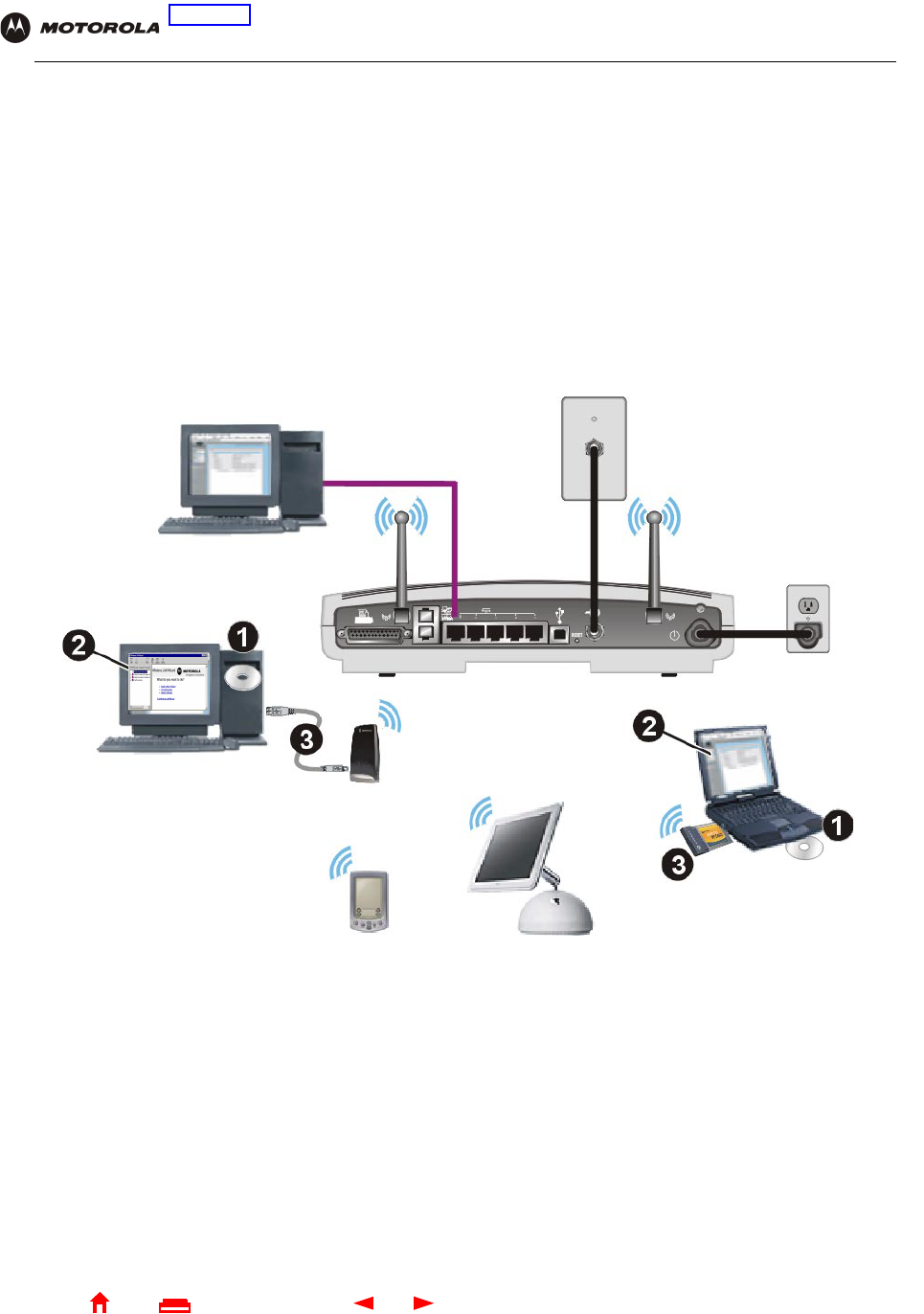
14 SBG1000 Wireless Cable Modem Gateway User Guide
Home
X
E
xitPrint
Overview Installation Troubleshooting Contact FAQ Specifications Glossary License
Configuration: Basic Gateway TCP/IP Wireless Print Server USB
IEEE 802.11b Wireless LAN
Wireless communication occurs over radio waves rather than a wire. Like a cordless telephone, a wireless LAN
uses radio signals instead of wires to exchange data. A wireless network eliminates the need for expensive and
intrusive wiring to connect computers throughout the home or office. Mobile users can remain connected to the
network even when carrying their laptop to different locations in the home or office.
Each computer on a wireless LAN requires an adapter described in “Optional Accessories” on page 4:
•For wireless laptops connections, use a Motorola PCC11b Wireless Card in the PCMCIA slot.
•For wireless desktop connections, use a Motorola USB11b Wireless Adapter to connect your PC USB port.
Sample wireless network connections
To set up the SBG1000, on a computer wired to the SBG1000 over Ethernet or USB, perform the procedures in
“Setting Up the Wireless LAN” on page 67.
To set up each wireless client (station):
1Insert the PCC11b and USB11b Wireless Adapter CD-ROM in the CD-ROM drive on the client.
2Install the device software from the CD.
3Connect the Motorola PCC11b wireless card or USB11b wireless adapter following the instructions supplied
with the card or adapter
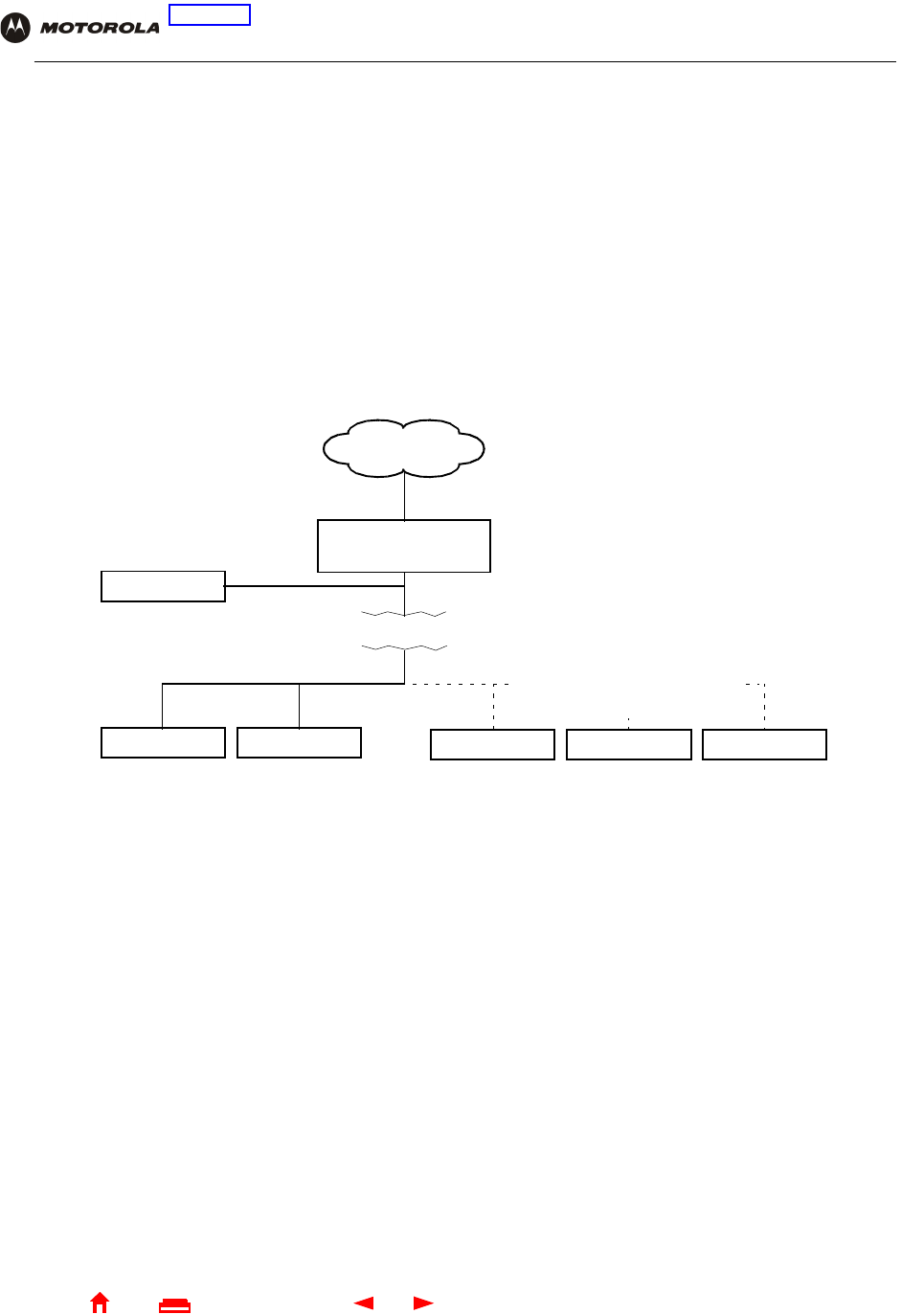
15 SBG1000 Wireless Cable Modem Gateway User Guide
Home
X
E
xitPrint
Overview Installation Troubleshooting Contact FAQ Specifications Glossary License
Configuration: Basic Gateway TCP/IP Wireless Print Server USB
Security
The Motorola SBG1000 Wireless Cable Modem Gateway provides:
•A firewall to protect the SBG1000 LAN from undesired attacks over the Internet
•Security measures to prevent eavesdropping of wireless data
Network Address Translation (NAT) provides some security because the IP addresses of SBG1000 LAN
computers are not visible on the Internet.
The logical network diagram does not necessarily correspond to the network cabling. A full discussion of network
security is beyond the scope of this document.
SBG1000 security measures shown in a logical network diagram
Firewall
The SBG1000 firewall protects the SBG1000 LAN from undesired attacks and other intrusions from the Internet. It
provides an advanced integrated stateful-inspection firewall supporting intrusion detection, session tracking, and
denial-of-service attack prevention. The firewall:
•Maintains state data for every TCP/IP session on the OSI network and transport layers
•Monitors all incoming and outgoing packets, applies the firewall policy to each one, and screens for improper
packets and intrusion attempts
•Provides comprehensive logging for all:
— User authentications
— Rejected internal and external connection requests
— Session creation and termination
— Outside attacks (intrusion detection)
You can configure the firewall filters to set rules for port usage and to block specific IP domains and networks. For
information about choosing a default firewall policy, see “Setting the Firewall Policy” on page 36.
SBG1000
Firewall
ComputerComputer
Wired Ethernet and/or HPNA LAN Wireless IEEE 802.11b LAN
LaptopComputer PDA
Wireless Security:
WEP shared key encryption
MAC access control list
Closed network
Internet
DMZ computer

16 SBG1000 Wireless Cable Modem Gateway User Guide
Home
X
E
xitPrint
Overview Installation Troubleshooting Contact FAQ Specifications Glossary License
Configuration: Basic Gateway TCP/IP Wireless Print Server USB
DMZ
A de-militarized zone (DMZ) is one or more computers logically located outside the firewall between an SBG1000
LAN and the Internet. A DMZ prevents direct access by outside users to private data. You can use a DMZ to set up
a web server without exposing confidential data on your network. A DMZ is also useful for gamers that have a
problem running a computer game’s protocol through a firewall. DMZ provides the gamer a way to expose a single
host directly to the Internet and thus overcome any firewall issues.
Wireless Security
To prevent unauthorized eavesdropping of data transmitted over the wireless LAN, you must enable wireless
security. The default Open authentication setting provides no security for transmitted data.
You can encrypt data transmitted over the IEEE 802.11b wireless interface by configuring a WEP key on the
Motorola SBG1000 Wireless Cable Modem Gateway and wireless LAN clients (stations).
You can also define a MAC access control list to restrict wireless LAN access to specified clients based on the
client MAC address.
If you enable closed network operation, the network name (ESSID) is not transmitted in the IEEE 802.11b beacon
frame. This provides additional network protection because only IEEE 802.11b stations that are configured with
your network name can associate with the SBG1000. Closed network operation is not part of the IEEE 802.11b
standard
For information about configuring a WEP key, see “Configuring Basic Wireless LAN Security” on page 69.
Virtual Private Networks
The SBG1000 allows multiple tunnel VPN pass-through operation to securely connect remote computers over the
Internet through the SBG1000. The SBG1000:
•Is compatible with Point to Point Tunneling Protocol (PPTP) and Layer 2 Tunneling Protocol (L2TP)
•Is fully interoperable with any IPSec client or gateway and ANX certified IPSec stacks
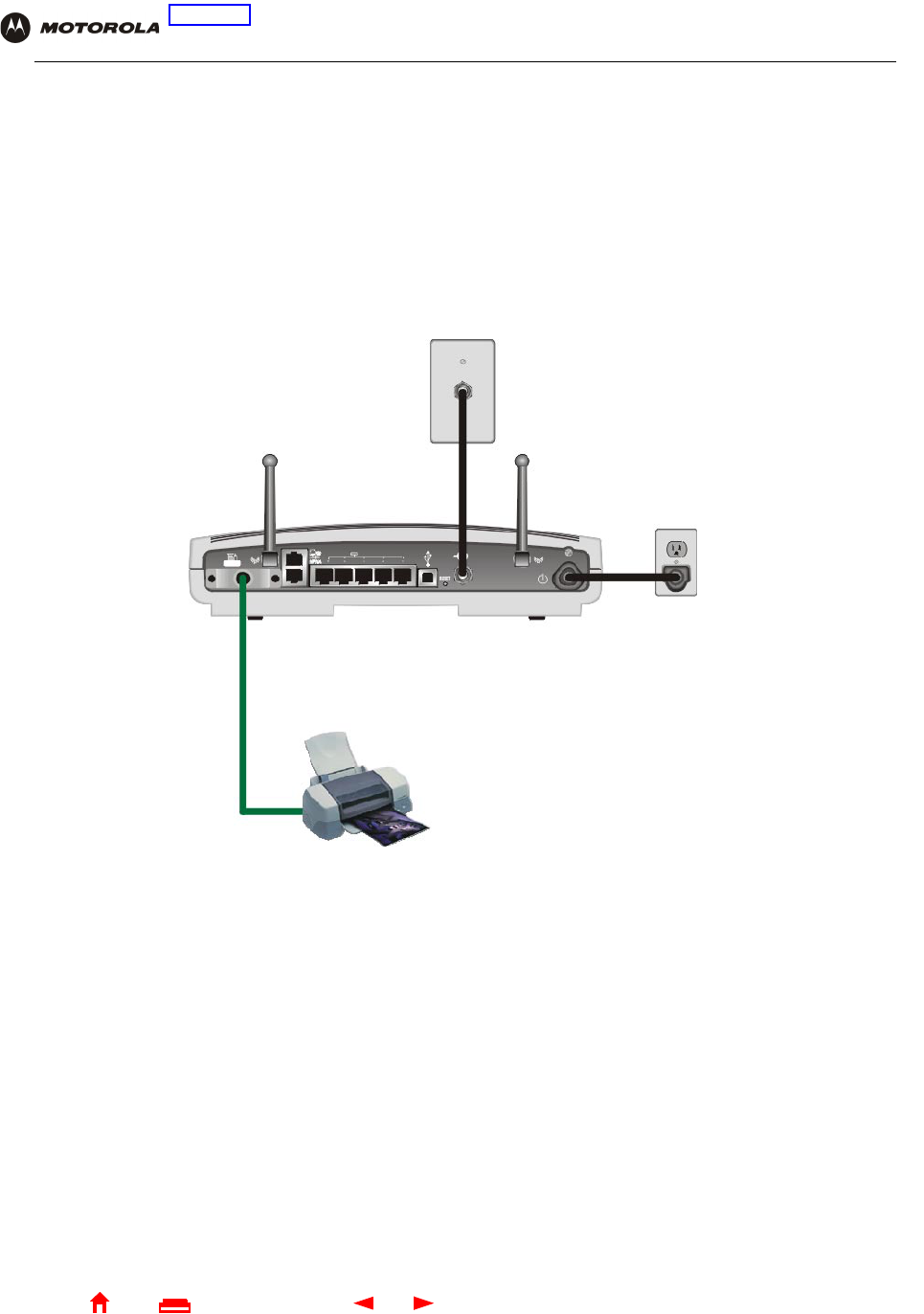
17 SBG1000 Wireless Cable Modem Gateway User Guide
Home
X
E
xitPrint
Overview Installation Troubleshooting Contact FAQ Specifications Glossary License
Configuration: Basic Gateway TCP/IP Wireless Print Server USB
Print Server
You can connect a printer to the Motorola SBG1000 Wireless Cable Modem Gateway back panel using a standard
DB-25 connector. The print server:
•Enables Windows, UNIX, Linux, or Macintosh computers on the wired or wireless SBG1000 LAN to share a
printer
•Supports the SMB, LPR, AppleTalk® printing protocols
Printer connection
For information about configuring the print server, see “Configuring the Print Server” on page 77.
Related Documentation
The following documents also provide information you can use with the Motorola SBG1000 Wireless Cable
Modem Gateway:
•Motorola SBG1000 Wireless Cable Modem Gateway Quick Start Guide
•Motorola PCC11b Wireless Card Quick Start Guide and on-line help on the PCC11b and USB11b Wireless
Adapter CD-ROM
•Motorola USB11b Wireless Adapter Quick Start Guide and on-line help on the PCC11b and USB11b Wireless
Adapter CD-ROM
•Motorola Diversity Antenna Installation Instructions
For the most recent documentation, visit the Product Documentation page on www.motorola.com/broadband.

19 SBG1000 Wireless Cable Modem Gateway User Guide
Home
X
E
xitPrint
Overview Installation Troubleshooting Contact FAQ Specifications Glossary License
Configuration: Basic Gateway TCP/IP Wireless Print Server USB
Installation
To install the Motorola SBG1000 Wireless Cable Modem Gateway hardware:
•Determine the type of connections you will make to the SBG1000 — Ethernet, HPNA, wireless, USB, and/or
printer
•Check that you have the proper cables, adapters, and adapter software to connect to your SBG1000:
— For Ethernet, you’ll need Ethernet cables and network interface cards (NICs) with accompanying
installation software.
— For HPNA, you’ll need telephone jumper cables, HPNA interface cards, and the installation software.
— For wireless connections, you’ll need wireless adapters and the installation software for the adapters.
— For USB, you’ll need a USB cable and the Motorola SBG1000 Wireless Cable Modem Gateway
CD-ROM which contains the software for USB installation.
— For the printer, you’ll need a printer cable.
Before You Begin
Before you begin the installation, check that you received the following items with the Motorola SBG1000 Wireless
Cable Modem Gateway:
You will need 75-ohm coaxial cable with F-type connectors to connect the SBG1000 to the nearest cable outlet. If
a TV is connected to the cable outlet, you may need a 5-900 MHz RF splitter and two additional coaxial cables to
use both the TV and the SBG1000.
Item Description
Power cord Connects the SBG1000 to the AC electrical outlet
10/100Base-T
Ethernet cable Connects to the Ethernet port
USB cable Connects to the USB port
Phone wire jumper
with RJ-11 connectors Connects to a telephone line used for the HPNA network
Motorola SBG1000
Wireless Cable Modem
Gateway CD-ROM
Contains this User Guide and USB drivers
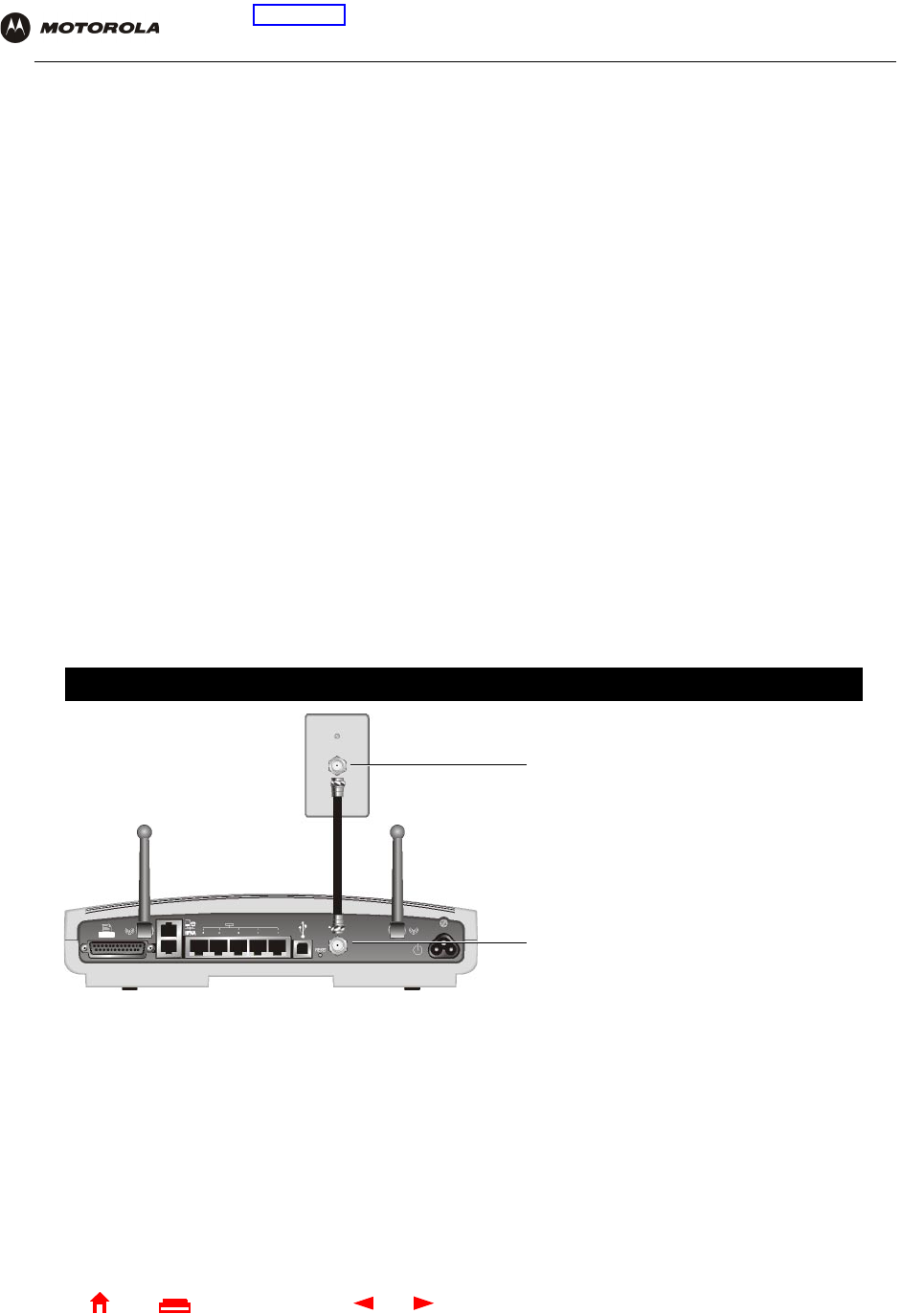
20 SBG1000 Wireless Cable Modem Gateway User Guide
Home
X
E
xitPrint
Overview Installation Troubleshooting Contact FAQ Specifications Glossary License
Configuration: Basic Gateway TCP/IP Wireless Print Server USB
You may need:
If you are installing the optional Motorola External Diversity Antenna, you may need a pair of needle nose pliers.
Coaxial cable, RF splitters, hubs, and switches are available at consumer electronic stores.
Precautions
Postpone SBG1000 installation until there is no risk of thunderstorm or lightning activity in the area.
To avoid damaging the SBG1000 with static electricity:
•Always first connect the coaxial cable to the grounded cable TV wall outlet.
•Before you connect or disconnect the USB or Ethernet cable from the SBG1000 or PC, always touch the
coaxial cable connector on the SBG1000 to release any static charges.
To avoid potential shock, always unplug the power cord from the wall outlet or other power source before
disconnecting it from the SBG1000 rear panel.
To prevent overheating the SBG1000, do not block the ventilation holes on the bottom of the unit.
Do not open the unit. Refer all service to your cable service provider.
Wipe the unit with a clean, dry cloth. Never use cleaning fluid or similar chemicals. Do not spray cleaners directly
on the unit or use forced air to remove dust.
To Set Up You Will Need
A wired Ethernet LAN with more
than five computers One or more Ethernet hubs or switches
An HPNA LAN An HPNA adapter and driver software for each computer connected using
HPNA
An IEEE 802.11b wireless LAN An IEEE 802.11b adapter and driver software for each computer having a
wireless connection (see “Optional Accessories” on page 4)
To avoid damaging the SBG1000 or computers with static electricity:
Always make the wall connection first.
Before you connect or disconnect the USB
or Ethernet cables, always touch the
coaxial cable connector on the SBG1000.

21 SBG1000 Wireless Cable Modem Gateway User Guide
Home
X
E
xitPrint
Overview Installation Troubleshooting Contact FAQ Specifications Glossary License
Configuration: Basic Gateway TCP/IP Wireless Print Server USB
Signing Up for Service
You must sign up with a cable service provider to access the Internet and other online services.
To activate your service, call your local cable service provider.
You need to provide the MAC address printed on the bar code label marked HFC MAC ID on the Motorola
SBG1000 Wireless Cable Modem Gateway rear panel. You can record it here:
00 : ______ : ______ : ______ : ______ : ______
You should ask your cable service provider the following questions:
•Do you have any special system requirements?
•When can I begin to use my SBG1000?
•Are there any files I need to download after I am connected?
•Do I need a user name or password to access the Internet or use e-mail?
Computer System Requirements
You can connect Microsoft Windows, Macintosh, UNIX, or Linux computers equipped as follows to the
SBG1000 LAN:
•One of the following:
•PC with Pentium class or better processor
•Windows 98, Windows 98 SE, Windows Me, Windows 2000, Windows XP, Windows NT, Macintosh, or Linux
operating system with operating system CD-ROM available
•Minimum 16 MB RAM recommended
•10 MB available hard disk space
You can use any web browser such as Microsoft® Internet Explorer or Netscape Navigator® with the Motorola
SBG1000 Wireless Cable Modem Gateway.
You can use the USB connection with any PC running Windows 98, Windows 2000, Windows Me, or Windows XP
that has a USB interface. The USB connection requires special USB driver software that is supplied on the
Motorola SBG1000 Wireless Cable Modem Gateway CD-ROM. You can upgrade the USB drivers from the
Internet. For information, check our website http://www.motorola.com/broadband.
Ethernet 10Base-T or 10/100Base-T Ethernet adapter with proper NIC driver software installed
IEEE 802.11b Any IEEE 802.11b device
For information about the Motorola PCC11b Wireless Card (PCMCIA type II 3.3 V slot) or
USB11b Wireless Adapter, see “Optional Accessories” on page 4.
HPNA HPNA phone line adapter installed with proper HPNA driver software installed

22 SBG1000 Wireless Cable Modem Gateway User Guide
Home
X
E
xitPrint
Overview Installation Troubleshooting Contact FAQ Specifications Glossary License
Configuration: Basic Gateway TCP/IP Wireless Print Server USB
Connecting the SBG1000 to the Cable System
Allow 5 to 30 minutes the first time you turn on the SBG1000 to find and lock on the appropriate communications
channels.
1Be sure the computer is on and the SBG1000 is unplugged.
2Connect one end of the coaxial cable to the cable outlet or splitter.
3Connect the other end of the coaxial cable to the cable connector on the SBG1000.
Hand-tighten the connectors to avoid damaging them.
4If you are using the optional Motorola External Diversity Antenna, install it now. Follow the instructions in
“Installing the Optional External Diversity Antenna” on page 28.
5Insert the Motorola SBG1000 Wireless Cable Modem Gateway CD-ROM into the CD-ROM drive.
6Plug the power cord into the power connector on the SBG1000.
7Plug the power cord into the electrical outlet. This turns the Motorola SBG1000 Wireless Cable Modem
Gateway on. You do not need to unplug it when not in use.
8Check that the lights on the Front Panel cycle through this sequence:
•Power icon turns on when AC power is connected to the SBG1000 and indicates that the power supply is
working properly.
•RX (receive) light flashes while scanning for the receive channel and changes to solid green when the
receive channel is locked.
•TX (transmit) light flashes while scanning for the send channel and changes to solid green when the
send channel is locked.
•LNK (link) light flashes during SBG1000 registration and configuration and changes to solid green when
the cable modem wireless gateway is registered.
•Globe icon flashes when the SBG1000 is transmitting or receiving data.
Connecting the SBG1000 to the cable system
4
1
2
3
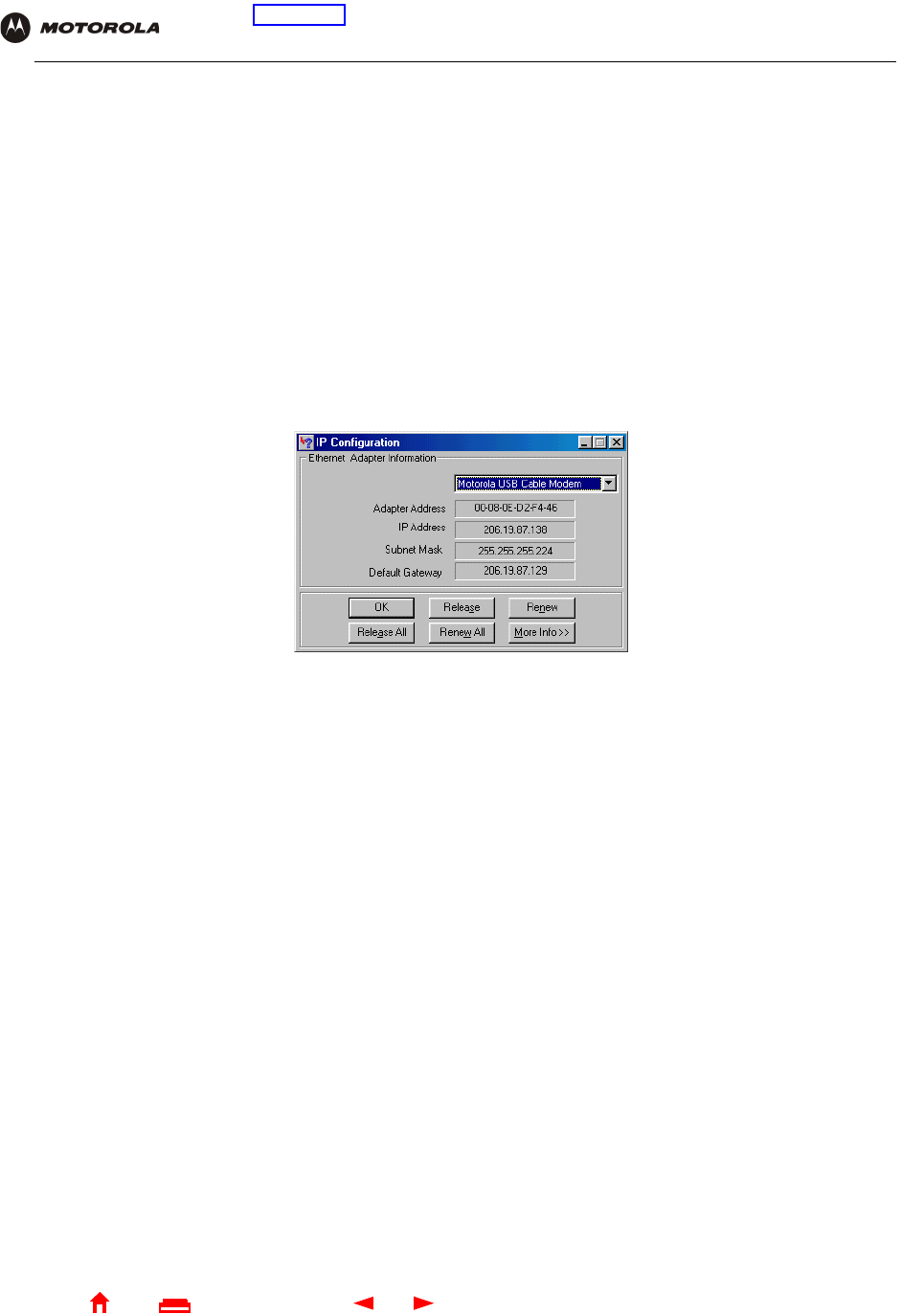
23 SBG1000 Wireless Cable Modem Gateway User Guide
Home
X
E
xitPrint
Overview Installation Troubleshooting Contact FAQ Specifications Glossary License
Configuration: Basic Gateway TCP/IP Wireless Print Server USB
Cabling the Ethernet or HPNA LAN
After connecting to the cable system, you can connect your wired Ethernet and/or HPNA LAN. Some samples are
shown in “Wired Ethernet LAN” on page 10 and “HPNA LAN” on page 13. Detailed information about network
cabling is beyond the scope of this document. You must install proper drivers for the Ethernet NIC or HPNA
adapter.
Obtaining an IP address in Windows 98, Windows 98 SE, or Windows Me
You must do the following on each Ethernet client PC running Windows 98, Windows 98 SE, or Windows Me:
1On the Windows Desktop, click Start.
2Select Run. The Run window is displayed.
3Type winipcfg.exe and click OK. The IP Configuration window is displayed:
4Click the Renew button to obtain an IP address for the PC from the DHCP server on the SBG1000.
Obtaining an IP address in Windows 2000 or Windows XP
You must do the following on each Ethernet client PC running Windows 2000 or Windows XP:
1On the Windows Desktop, click Start.
2Select Run. The Run window is displayed.
3Type cmd and click OK to display a command prompt window.
4Type ipconfig /renew and press ENTER to obtain an IP address for the PC from the DHCP server on the
SBG1000.
5Type exit and press ENTER to return to Windows.
Obtaining an IP address on Macintosh or UNIX Systems
Follow the instructions in your user manual.
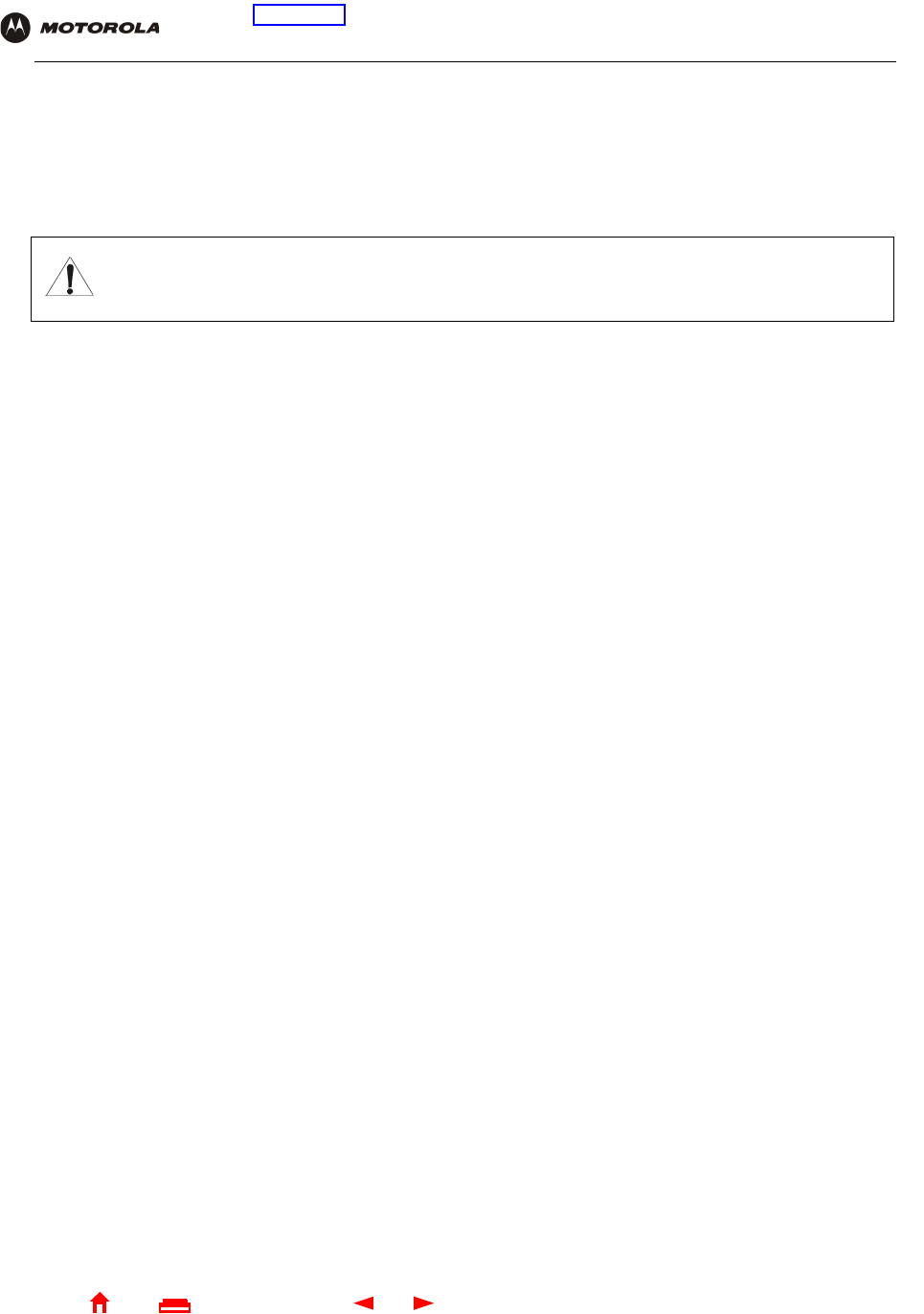
24 SBG1000 Wireless Cable Modem Gateway User Guide
Home
X
E
xitPrint
Overview Installation Troubleshooting Contact FAQ Specifications Glossary License
Configuration: Basic Gateway TCP/IP Wireless Print Server USB
Connecting a PC to the USB Port
You can connect a single PC running Windows 98, Windows XP, Windows Me, or Windows 2000 to the Motorola
SBG1000 Wireless Cable Modem Gateway USB port.
To connect a PC to the USB port:
1Connect the USB cable to the USB port on the SBG1000.
2Connect the other end to the USB port on the computer.
3Install the USB driver following the appropriate procedure for “Setting Up a USB Driver” on page 95.
Setting Up the Wireless LAN
For information about wireless LAN setup, see “Setting Up the Wireless LAN” on page 67.
Connecting the Printer
Connect the printer to the Motorola SBG1000 Wireless Cable Modem Gateway printer port. If a cable was
supplied with the printer, use that cable. Consult your printer documentation to determine cabling requirements
from the SBG1000 to the printer.
After connecting the printer, power it on and follow the instructions for “Configuring the Print Server” on page 77.
Caution!
Before plugging in the USB cable, be sure the Motorola SBG1000 Wireless Cable Modem Gateway
CD-ROM is inserted in the PC CD-ROM drive.
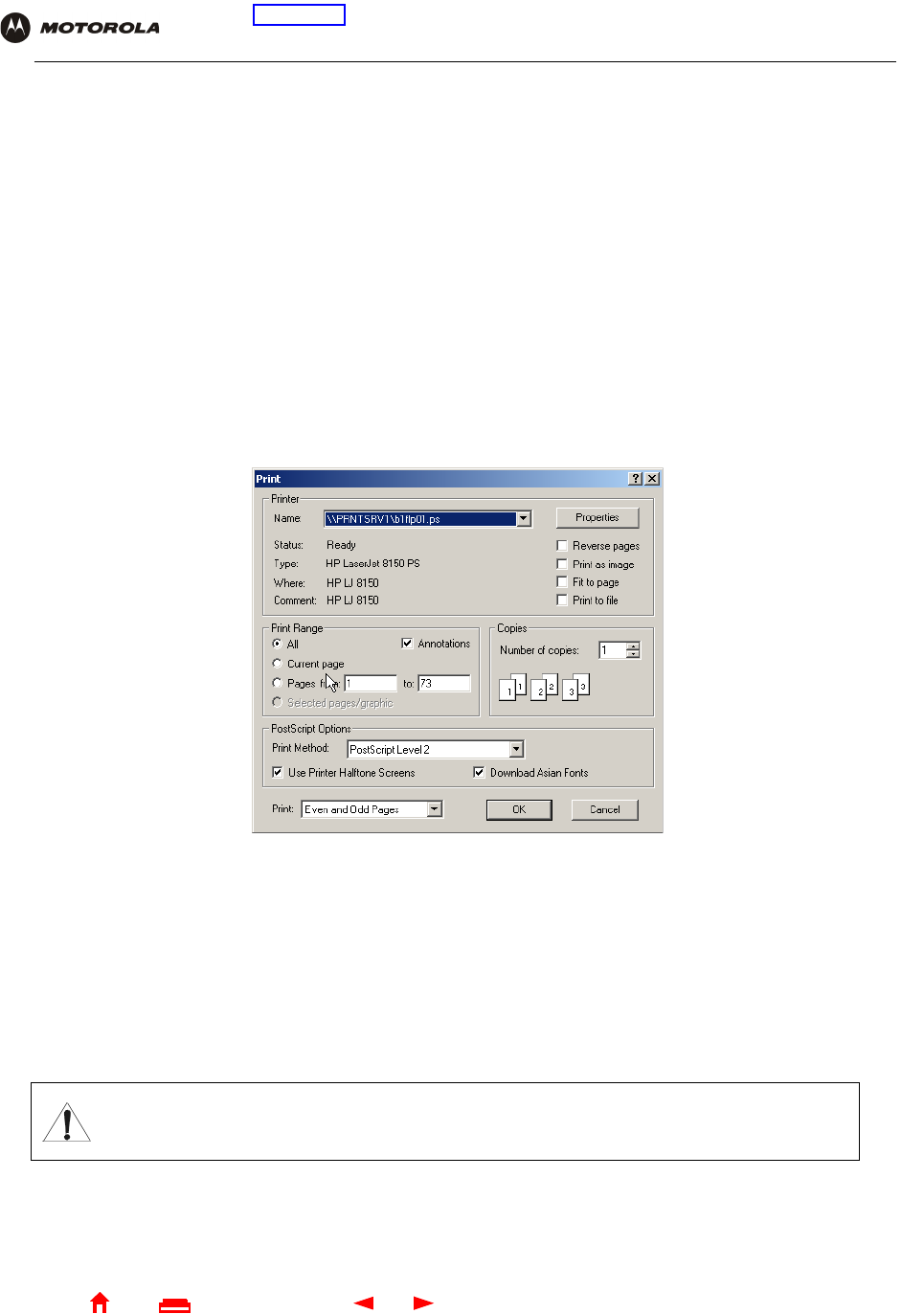
25 SBG1000 Wireless Cable Modem Gateway User Guide
Home
X
E
xitPrint
Overview Installation Troubleshooting Contact FAQ Specifications Glossary License
Configuration: Basic Gateway TCP/IP Wireless Print Server USB
Wall Mounting the Wireless Gateway
If you mount the SBG1000 on the wall, you must:
•Locate the unit as specified by the local or national codes governing residential or business cable TV and
communications services.
•Follow all local standards for installing a network interface unit/network interface device (NIU/NID).
If possible, mount the SBG1000 to concrete, masonry, a wooden stud, or other very solid wall material. Use
anchors if necessary; for example if you must mount the unit on drywall.
To mount your SBG1000 on the wall:
1Print the Wall Mounting Template on page 27:
Click the Print icon or choose Print from the File menu to display the Print dialog box. (The following image is
from Adobe Acrobat Reader® running on Windows 2000; there may be slight differences in your version.)
Be sure you print the template at 100% scale. Be sure Fit to page is not checked in the Print dialog box.
Click the OK button to print the template.
2Measure the printed template with a ruler to ensure that it is the correct size.
3Use a center punch to mark the center of the holes.
4On the wall, locate the marks for the mounting holes.
5Drill the holes to a depth of at least 3.8 cm (11/2 inches).
6If necessary, seat an anchor in each hole.
Caution!
Before drilling holes, check the structure for potential damage to water, gas, or electric lines.
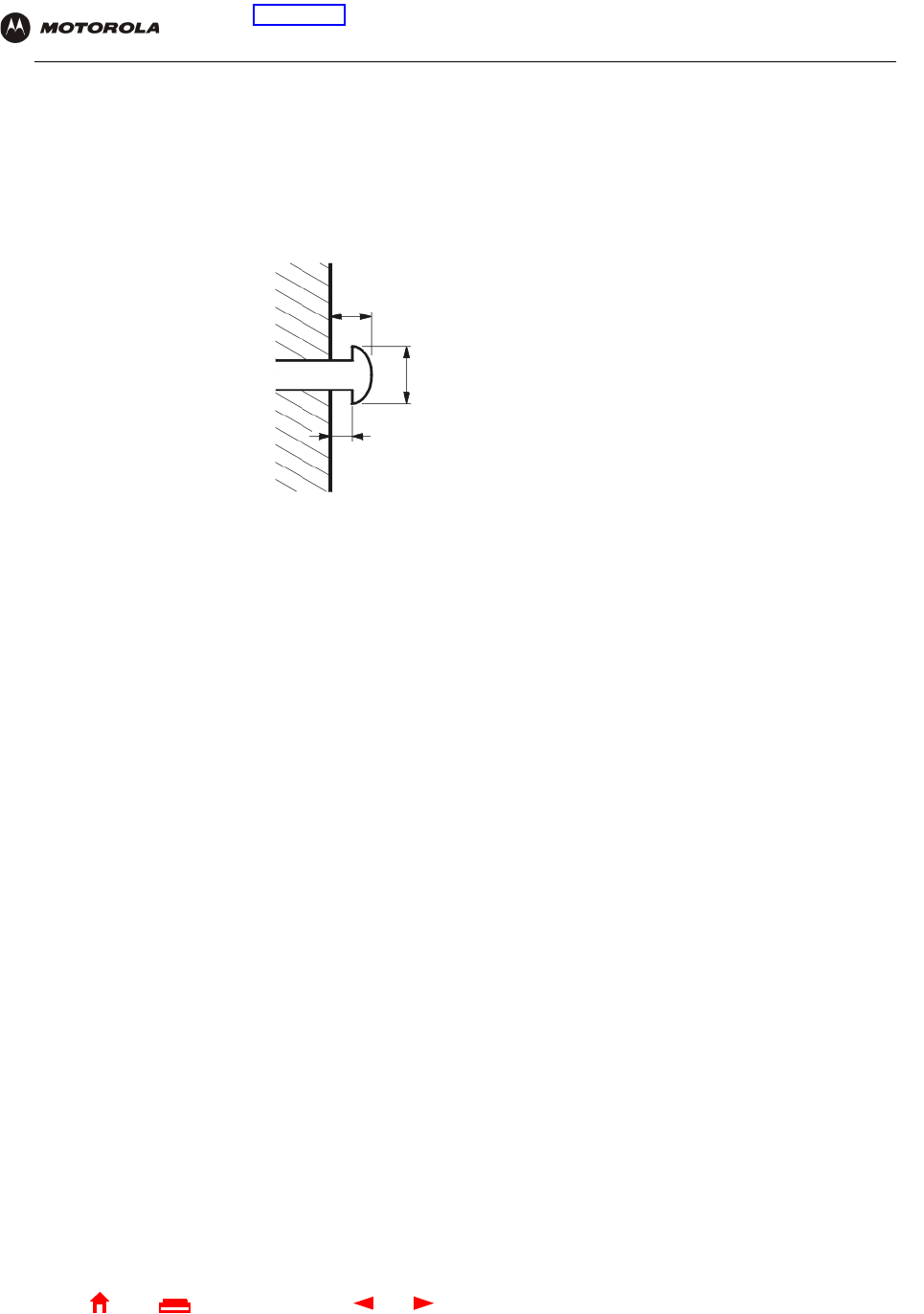
26 SBG1000 Wireless Cable Modem Gateway User Guide
Home
X
E
xitPrint
Overview Installation Troubleshooting Contact FAQ Specifications Glossary License
Configuration: Basic Gateway TCP/IP Wireless Print Server USB
Use M5 x 38 mm (#10-16 x 11/2 inch) screws with a flat underside and maximum screw head diameter of
10.5 mm to mount the SBG1000.
7Using a screwdriver, turn each screw until part of it protrudes from the wall, as shown:
•There must be 4.0 mm (.16 inches) between the wall and the underside of the screw head.
•The maximum distance from the wall to the top of the screw head is 7.6 mm (.3 in).
8Place the SBG1000 so the keyholes are above the mounting screws.
9Slide the SBG1000 down so it stops against the top of the keyhole opening.
7.6 mm (.3 inches) maximum
10.5 mm (.4 inches) maximum
4.0 mm (.16 inches)
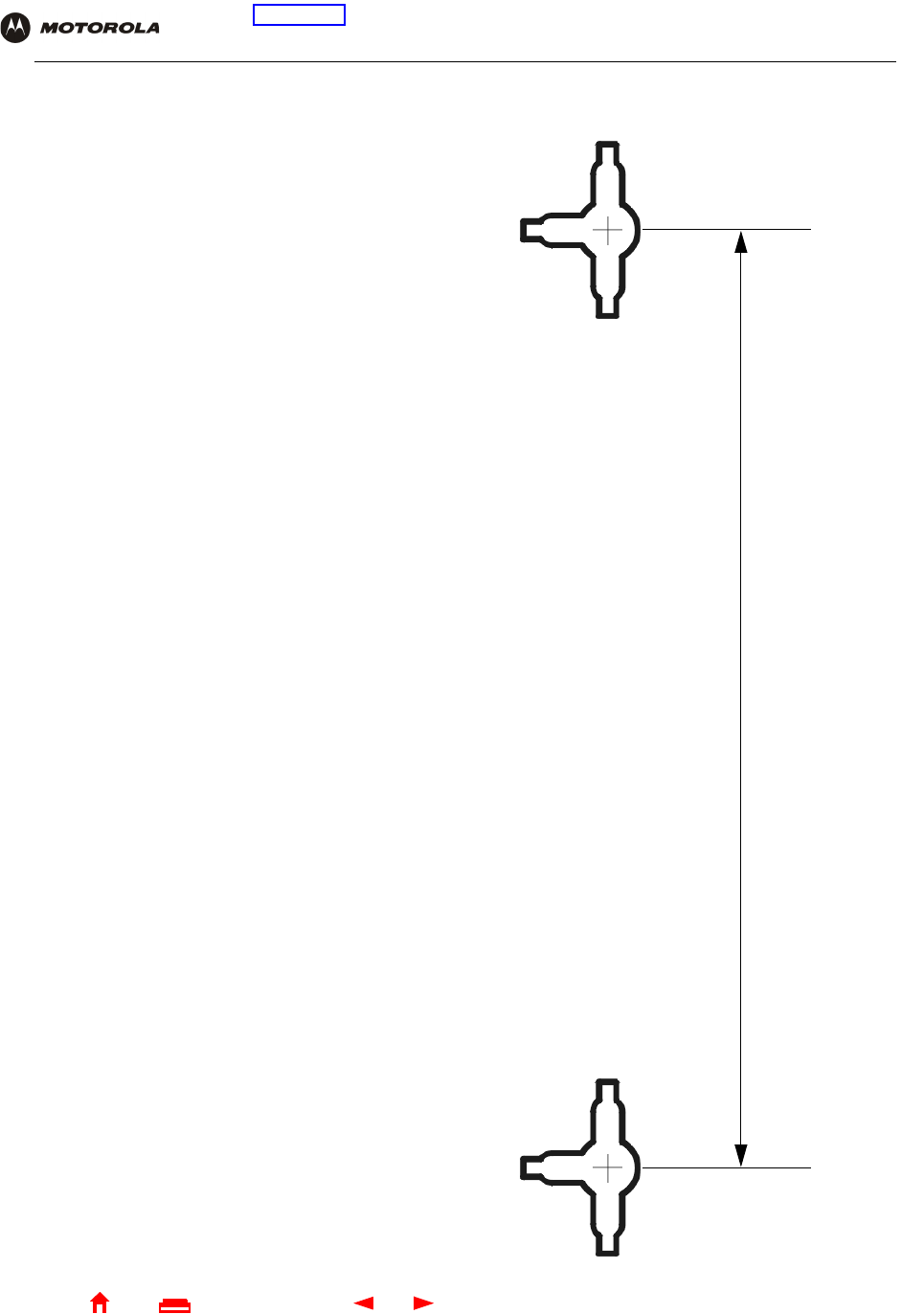
27 SBG1000 Wireless Cable Modem Gateway User Guide
Home
X
E
xitPrint
Overview Installation Troubleshooting Contact FAQ Specifications Glossary License
Configuration: Basic Gateway TCP/IP Wireless Print Server USB
Wall Mounting Template
You can print this page to use as a wall mounting template.
Be sure you print it at 100% scale. In Acrobat Reader, be sure
that Fit To Page is not checked in the Print dialog box.
Measure the printed template with a ruler to ensure that it is
the correct size.
17.24 cm.
6.79 in.

28 SBG1000 Wireless Cable Modem Gateway User Guide
Home
X
E
xitPrint
Overview Installation Troubleshooting Contact FAQ Specifications Glossary License
Configuration: Basic Gateway TCP/IP Wireless Print Server USB
Installing the Optional External Diversity Antenna
The optional Motorola External Diversity Antennas are designed to provide an indoor operating range with WEP
enabled of at least:
The maximum wireless operation distance depends on the type of materials through which the signal must pass
and the location of the diversity antennas and clients (stations). Motorola cannot guarantee wireless operation for
all supported distances in all environments.
To install the optional Motorola External Diversity Antenna:
1Be sure the SBG1000 is unplugged. As with all electronic equipment, avoid potential shock by always
unplugging the power cord from the wall outlet or other power source before disconnecting it from the
SBG1000 rear panel.
2Remove the antennas on the SBG1000 by unscrewing the connectors. You may need a pair of needle nose
pliers to loosen them.
Store the antennas supplied on the SBG1000 in a safe place.
Distance Data Transfer Rate
30 meters (100 feet) 11 Mbps
50 meters (165 feet) 5.5 Mbps
75 meters (230 feet) 2Mbps
95 meters (300 feet) 1Mbps
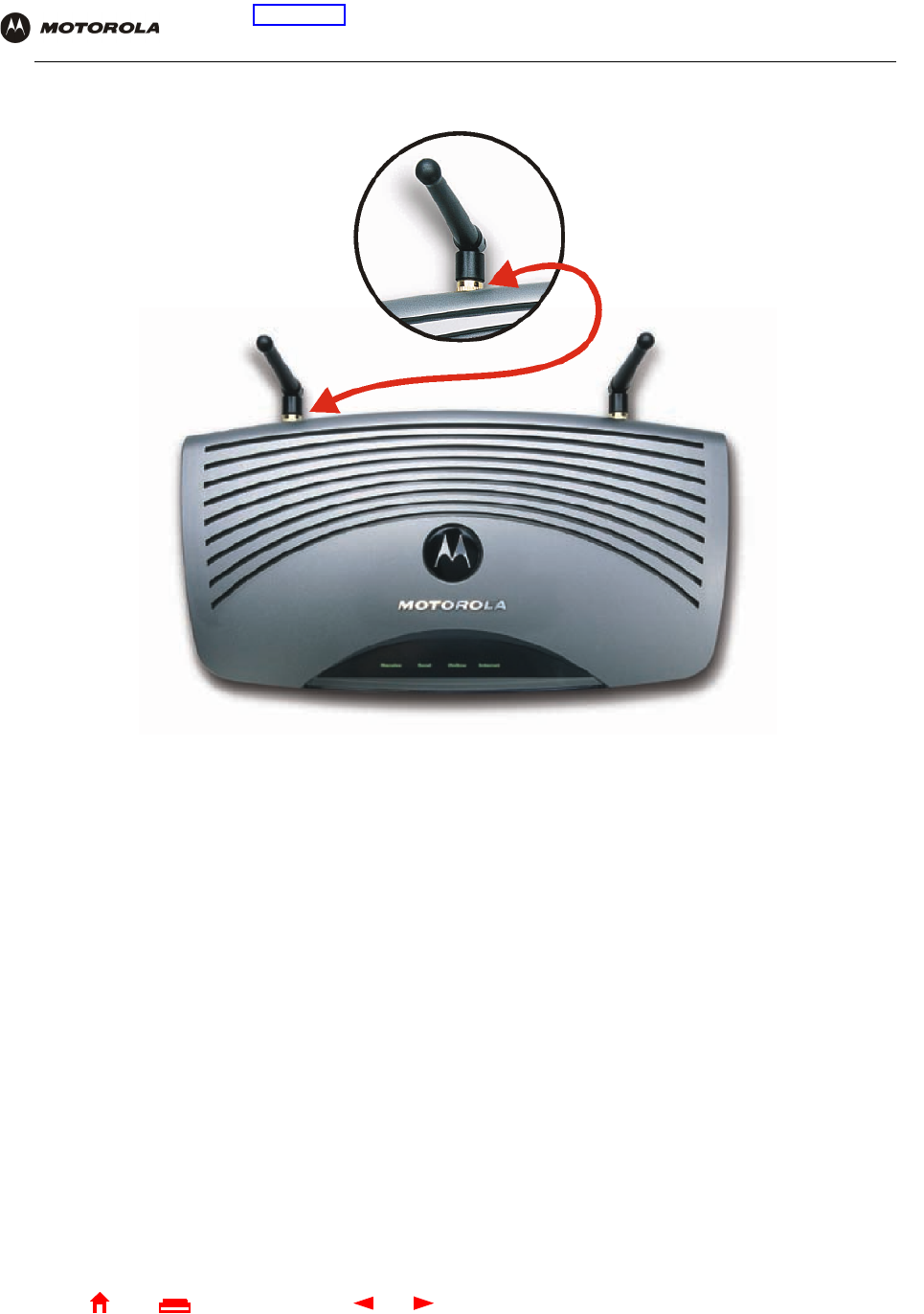
29 SBG1000 Wireless Cable Modem Gateway User Guide
Home
X
E
xitPrint
Overview Installation Troubleshooting Contact FAQ Specifications Glossary License
Configuration: Basic Gateway TCP/IP Wireless Print Server USB
Disconnecting the antennas provided with the SBG1000
3Connect the cables from the Motorola External Diversity Antenna to the connectors on the Motorola
SBG1000 Wireless Cable Modem Gateway Front Panel. Hand-tighten the connectors to avoid damaging
them. Using excessive force may damage the connectors.
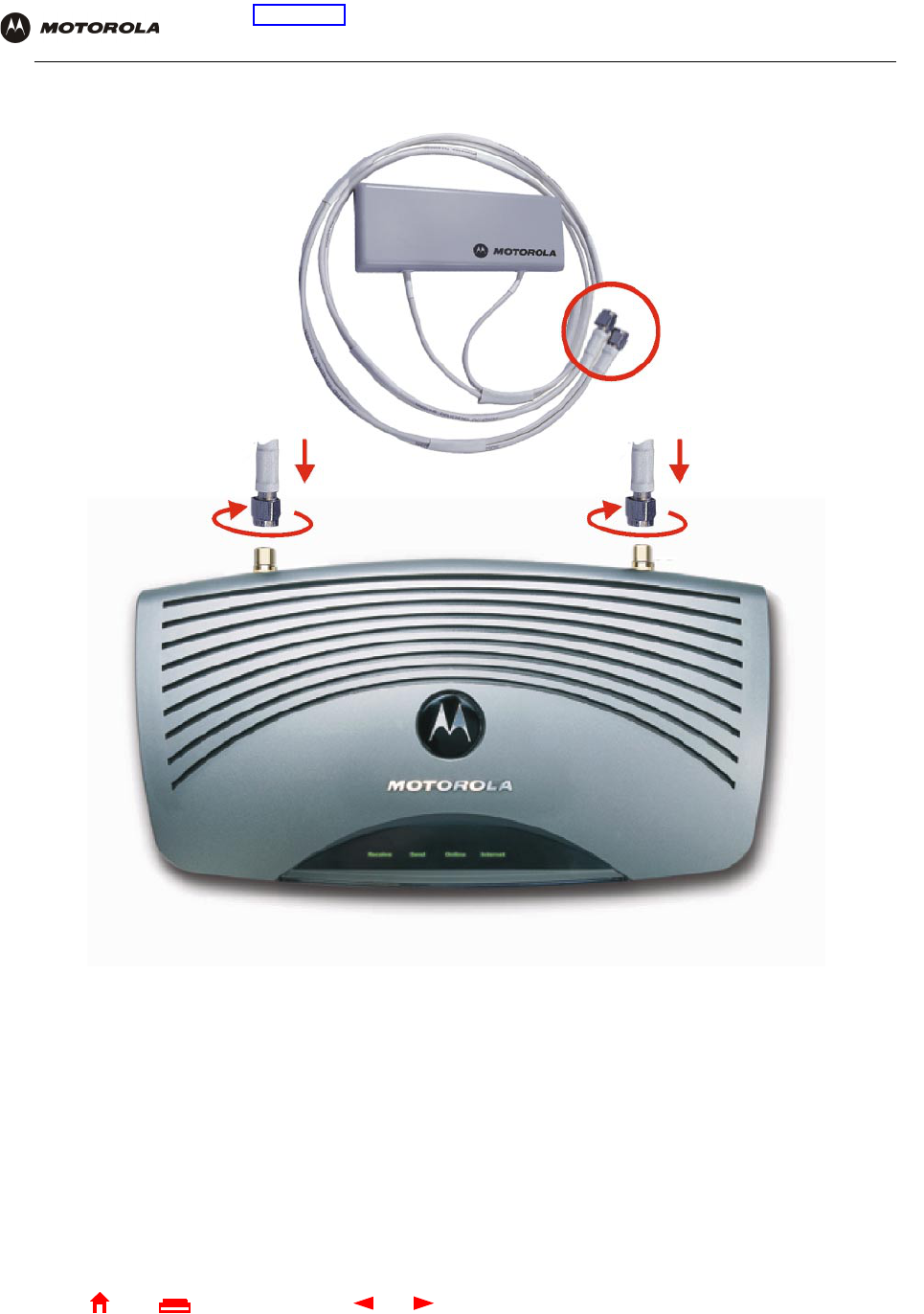
30 SBG1000 Wireless Cable Modem Gateway User Guide
Home
X
E
xitPrint
Overview Installation Troubleshooting Contact FAQ Specifications Glossary License
Configuration: Basic Gateway TCP/IP Wireless Print Server USB
Connecting the Optional External Diversity Antenna to the SBG1000
4Position or mount the External Diversity Antenna in a suitable location away from the computer and monitor.
Follow the instructions provided with the External Diversity Antenna. Do not twist the antenna cables.
To obtain optimum results, try moving the External Diversity Antennas to slightly different locations.
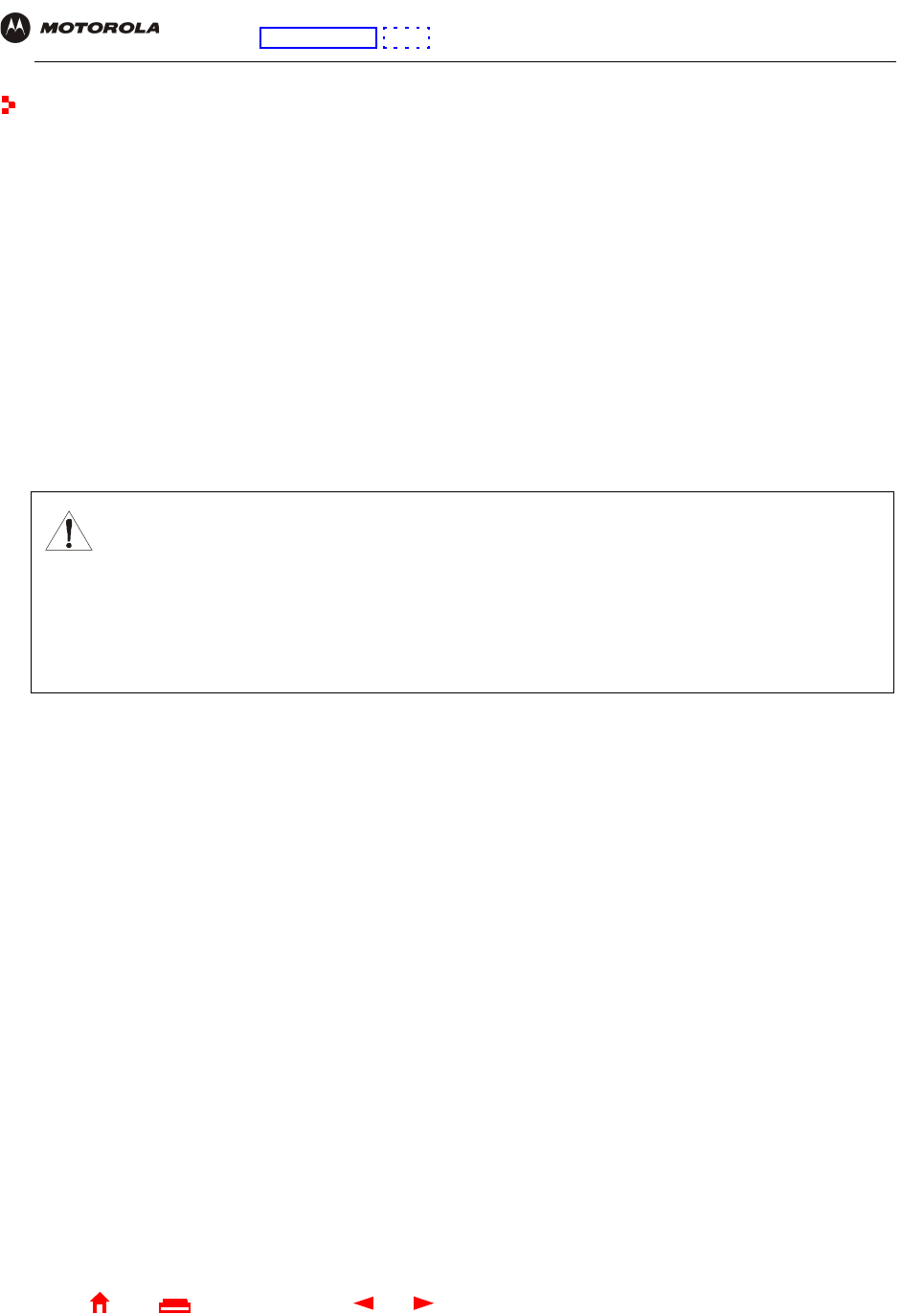
31 SBG1000 Wireless Cable Modem Gateway User Guide
Home
X
E
xitPrint
Overview Installation Troubleshooting Contact FAQ Specifications Glossary License
Configuration: Basic Gateway TCP/IP Wireless Print Server USB
Configuring the SBG1000
Configuring the SBG1000 includes:
•Starting the SBG1000 Setup Program (see page 32)
•Changing the Default Password (see page 34)
•Getting Help (see page 35)
•Setting the Firewall Policy (see page 36)
For more information about configuration, see “Configuring TCP/IP” on page 53, “Setting Up the Wireless LAN” on
page 67, “Configuring the Print Server” on page 77, or “Setting Up a USB Driver” on page 95.
For normal operation, you do not need to change most default settings. The following caution statements
summarize the issues you must be aware of:
Caution!
To prevent unauthorized configuration, change the default password immediately when you first
configure the Motorola SBG1000 Wireless Cable Modem Gateway. See “Changing the Default
Password” on page 34
Firewalls are not foolproof. Choose the most secure firewall policy you can. See “Setting the Firewall
Policy” on page 36.
For a wireless LAN only, be sure you follow the instructions in “Setting Up the Wireless LAN” on
page 67.
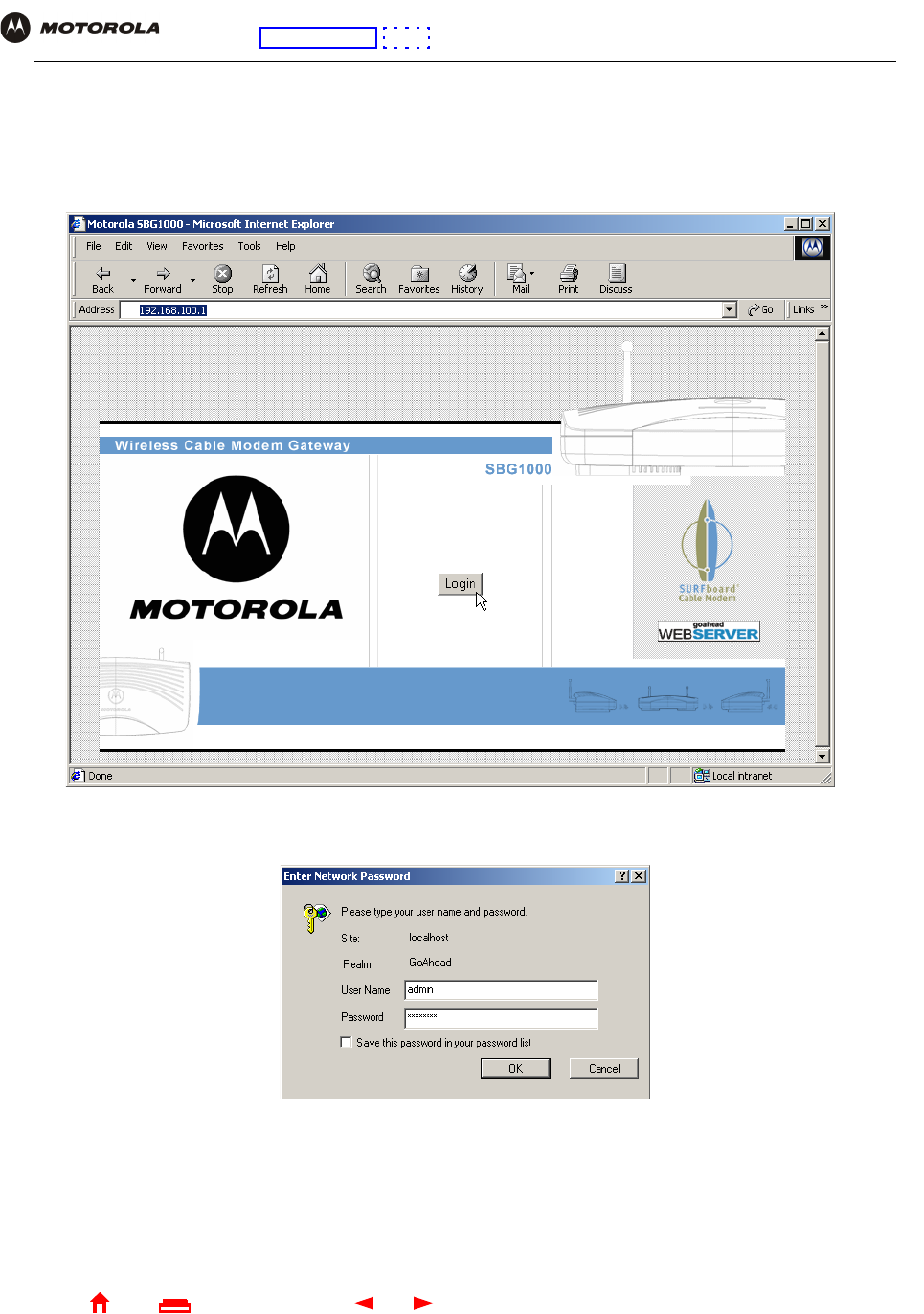
32 SBG1000 Wireless Cable Modem Gateway User Guide
Home
X
E
xitPrint
Overview Installation Troubleshooting Contact FAQ Specifications Glossary License
Configuration: Basic Gateway TCP/IP Wireless Print Server USB
Starting the SBG1000 Setup Program
1On a computer on the LAN, open a web browser.
2In the Address or Location field, type 192.168.100.1 and press ENTER to display the Login window:
3Click Login to display the Enter Network Password window:
4In the User Name field, type the User Name (the default is “admin”).
5In the Password field, type the Password (the default is “motorola”).
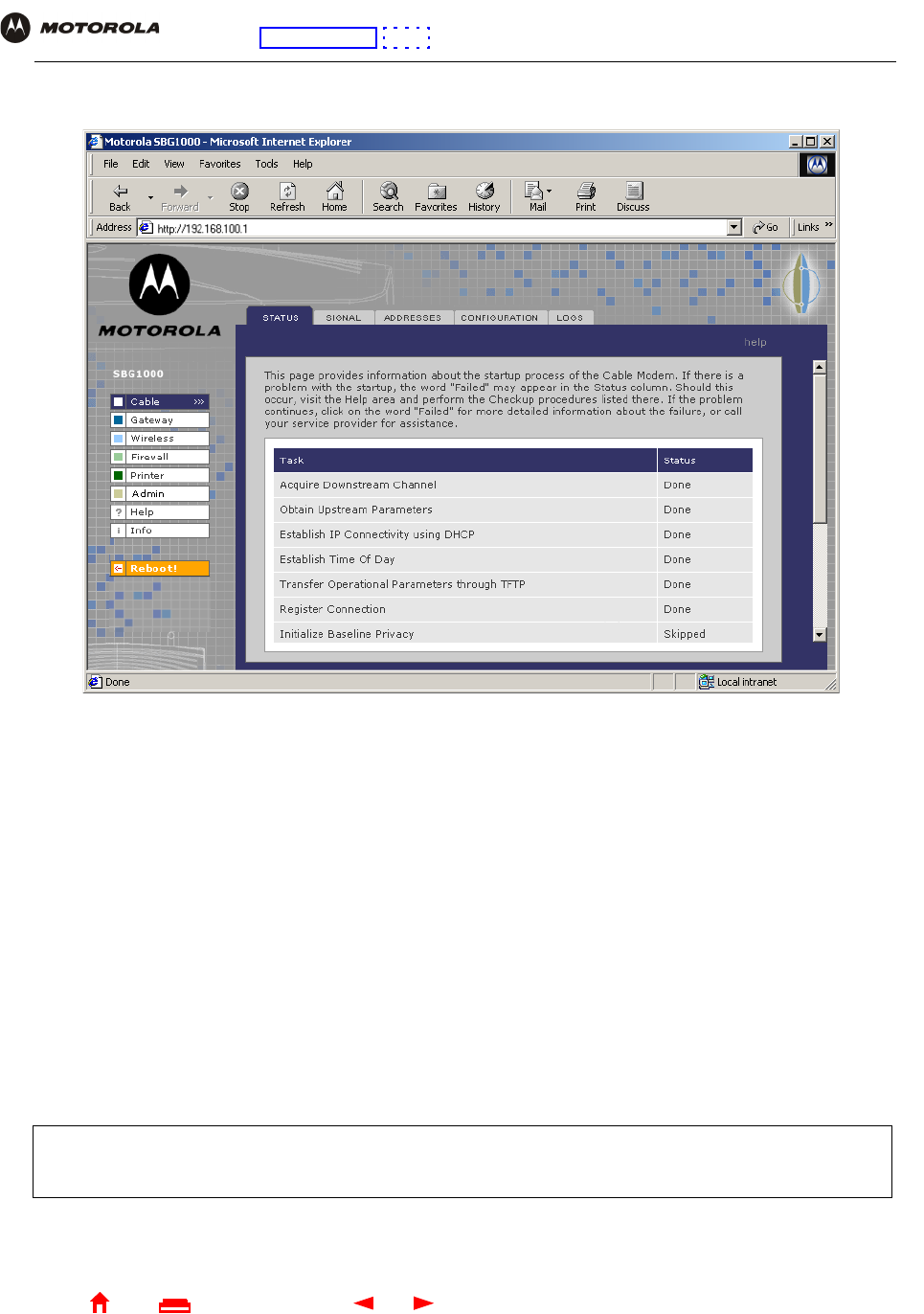
33 SBG1000 Wireless Cable Modem Gateway User Guide
Home
X
E
xitPrint
Overview Installation Troubleshooting Contact FAQ Specifications Glossary License
Configuration: Basic Gateway TCP/IP Wireless Print Server USB
6Click OK to display the SBG1000 Setup Program:
Click To Perform
Cable Configure and monitor the cable system connection
Gateway Configure and monitor the gateway preferences (see “Configuring the Gateway” on page 43)
Wireless Configure and monitor the wireless interface (see “Setting Up the Wireless LAN” on page 67)
Firewall Configure and monitor the firewall (see “Setting the Firewall Policy” on page 36)
Printer Configure the SBG1000 print server (see “Configuring the Print Server” on page 77)
Admin Changing the Default Password (see page 34)
Help Display information about the SBG1000 (see “Getting Help” on page 35)
Info Display information about the SBG1000 Setup Program
Reboot Restart the SBG1000. It is the same as pressing the reset button on the Rear Panel for less than five
seconds.
For some settings, after you edit the field and click Apply, you are warned that you must Reboot for your
change to take effect. Rebooting takes 10 to 15 seconds. After rebooting, you must log-in again.
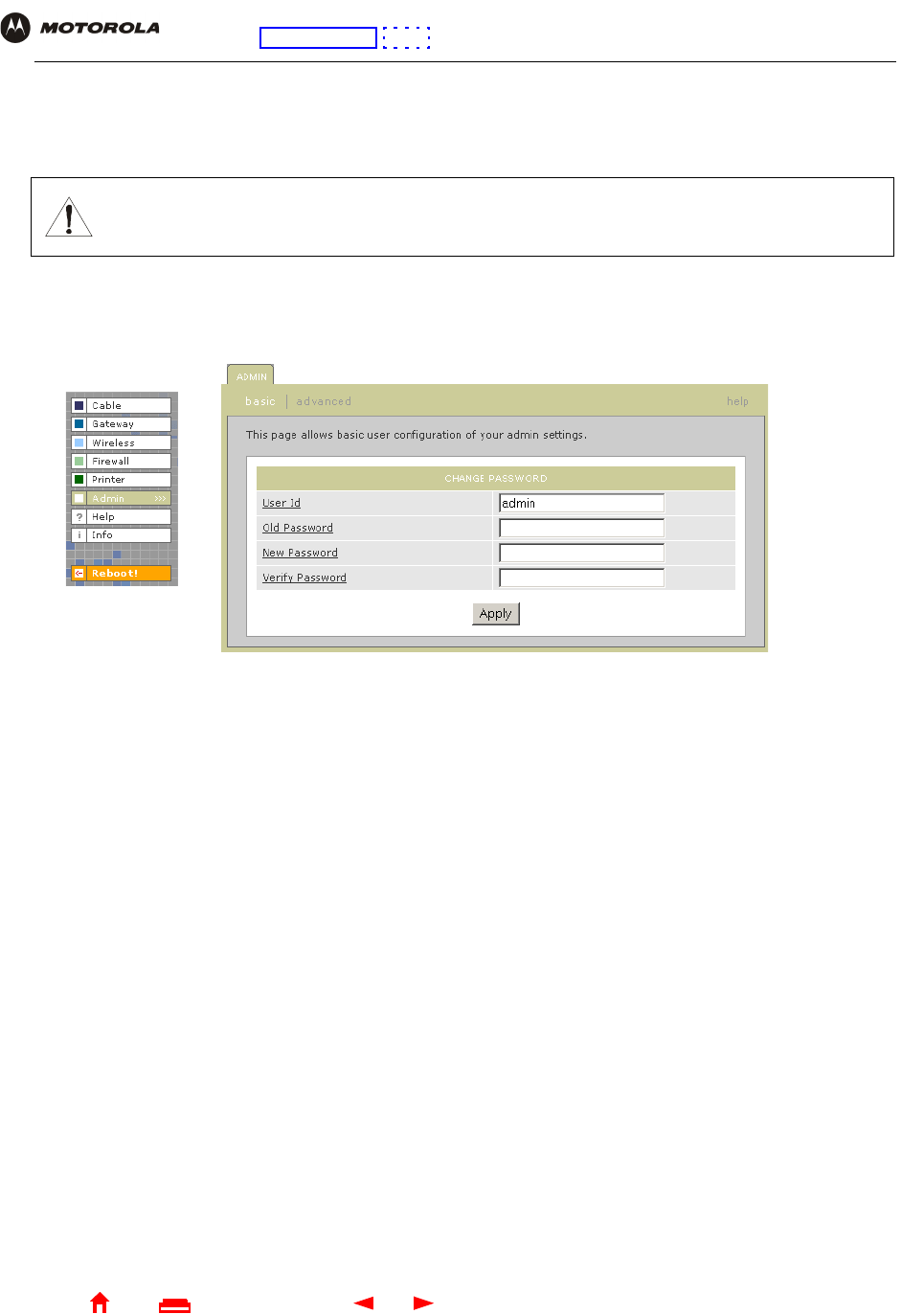
34 SBG1000 Wireless Cable Modem Gateway User Guide
Home
X
E
xitPrint
Overview Installation Troubleshooting Contact FAQ Specifications Glossary License
Configuration: Basic Gateway TCP/IP Wireless Print Server USB
Changing the Default Password
To change the default password:
1On the SBG1000 Setup Program screen, click Admin to display the ADMIN — basic page:
2Type the old password in the Old Password field. (The default password is “motorola.”)
3Type the new password in the New Password field.
4Type the new password again in the Verify Password field.
5Click Apply to apply your changes.
Caution!
To prevent unauthorized configuration, change the default password immediately when you first
configure the Motorola SBG1000 Wireless Cable Modem Gateway.
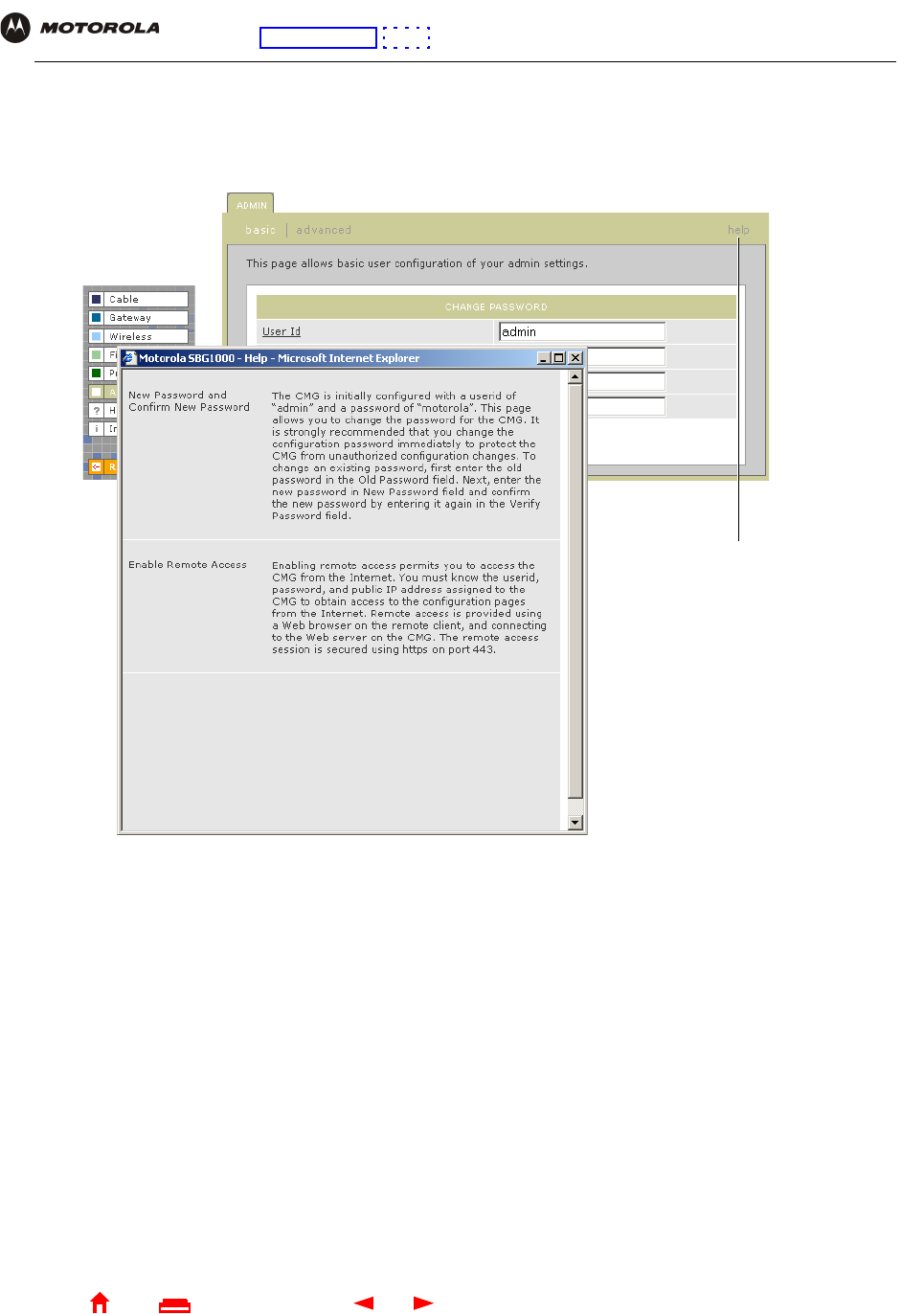
35 SBG1000 Wireless Cable Modem Gateway User Guide
Home
X
E
xitPrint
Overview Installation Troubleshooting Contact FAQ Specifications Glossary License
Configuration: Basic Gateway TCP/IP Wireless Print Server USB
Getting Help
To get help on any underlined item, field, click the text. For example, if you click a field or the help button on the
ADMIN — basic page, the following help is displayed:
You can scroll to browse the help, or click another item to display help for that item.
This button also displays
help for the window.
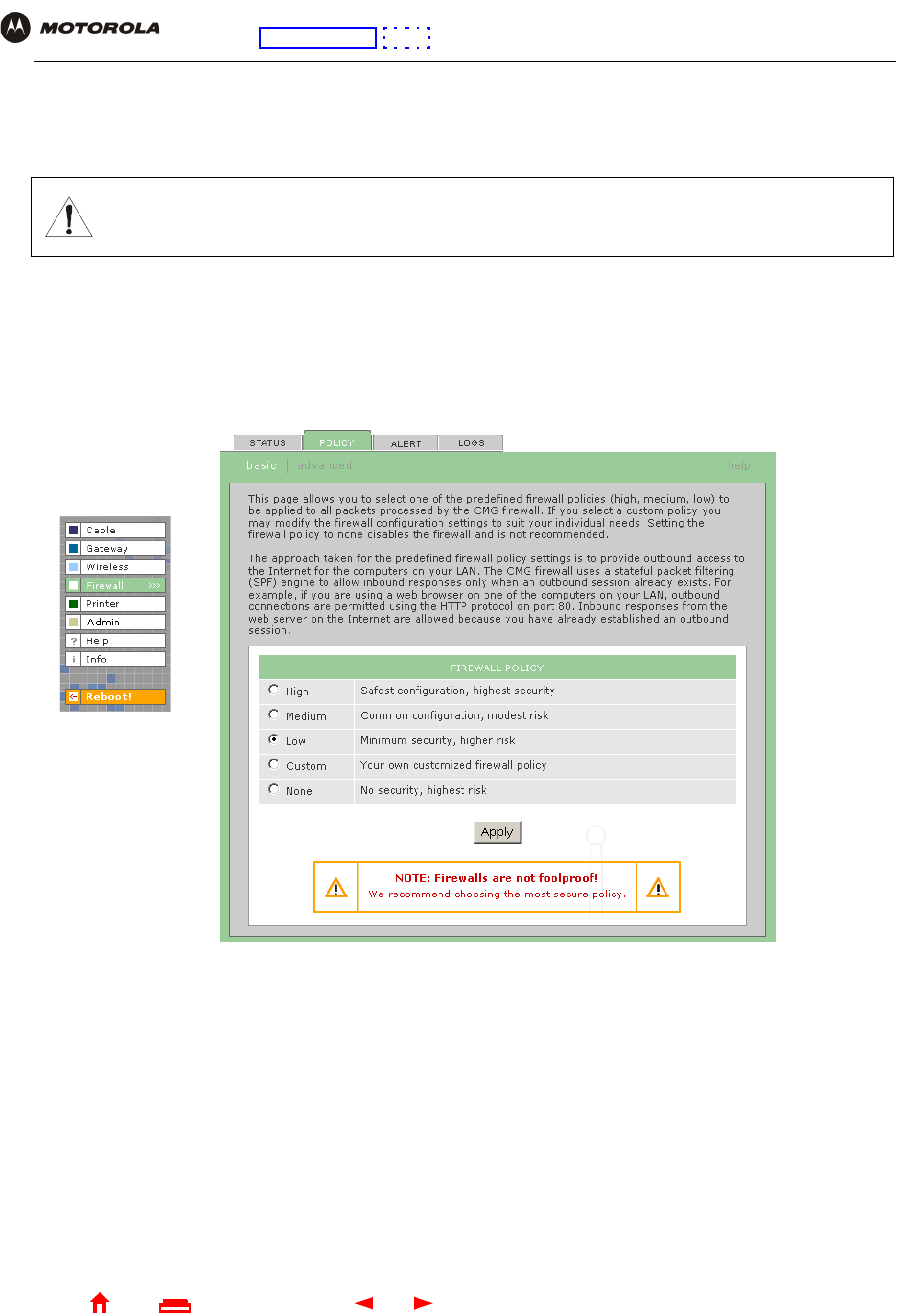
36 SBG1000 Wireless Cable Modem Gateway User Guide
Home
X
E
xitPrint
Overview Installation Troubleshooting Contact FAQ Specifications Glossary License
Configuration: Basic Gateway TCP/IP Wireless Print Server USB
Setting the Firewall Policy
To select a predefined policy for all packets processed by the firewall:
1On the SBG1000 Setup Program left panel, click Firewall.
2Click POLICY.
3Click basic to display the options for firewall policy:
4Select one of the following. Unless you have the necessary expertise and need to setup a custom firewall,
use High, Medium, or Low:
5Click Apply to apply your changes.
Caution!
Firewalls are not foolproof. Choose the most secure firewall policy you can. To enable easy network
setup, the default firewall policy is Low, which provides minimum security.
High Safest configuration, highest security. We recommend this setting.
Medium Common configuration, modest risk
Low Minimum security, higher risk
Custom You can create a custom firewall policy on the Firewall > POLICY — advanced Page (see page 39). Do
not create a custom policy unless you have the necessary expertise and the need to do so.
None This setting disables the firewall and provides no security. We do not recommend this setting.
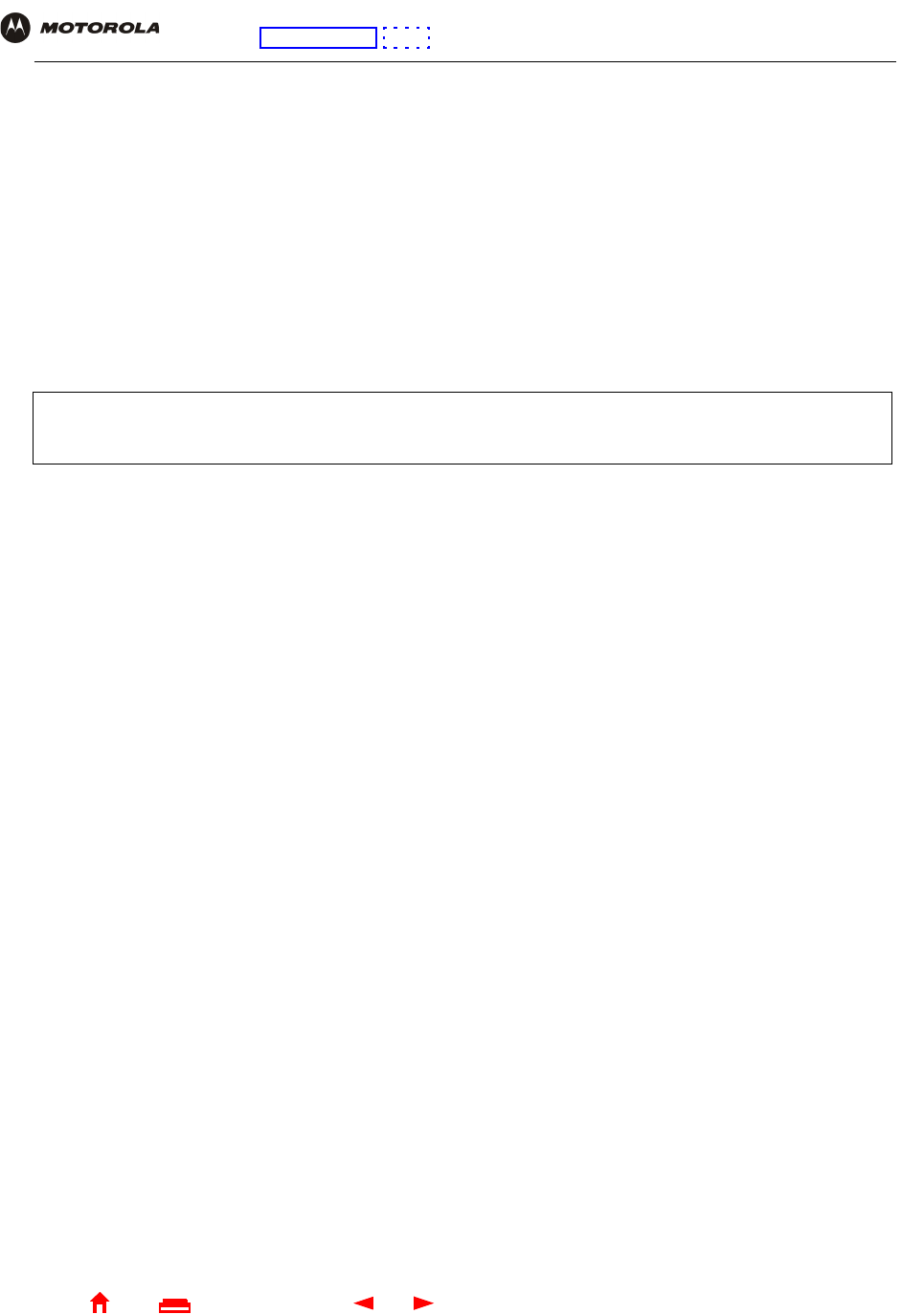
37 SBG1000 Wireless Cable Modem Gateway User Guide
Home
X
E
xitPrint
Overview Installation Troubleshooting Contact FAQ Specifications Glossary License
Configuration: Basic Gateway TCP/IP Wireless Print Server USB
Firewall Pages in the SBG1000 Setup Program
Use the following pages to configure the firewall:
•Firewall > POLICY — basic Page (see page 38)
•Firewall > POLICY — advanced Page (see page 39)
•Firewall > ALERT — basic Page (see page 40)
•Firewall > ALERT — email Page (see page 41)
•Firewall > LOGS Page (see page 42)
For some settings, after you edit the field and click Apply, you are warned that you must Reboot for your
change to take effect. Rebooting takes 10 to 15 seconds. After rebooting, you must log-in again.

38 SBG1000 Wireless Cable Modem Gateway User Guide
Home
X
E
xitPrint
Overview Installation Troubleshooting Contact FAQ Specifications Glossary License
Configuration: Basic Gateway TCP/IP Wireless Print Server USB
Firewall > POLICY — basic Page
Use this page to select a predefined firewall policy for all packets processed by the SBG1000 firewall, as
described in “Setting the Firewall Policy” on page 36. Advanced users only can create a custom policy on the
Firewall > POLICY — advanced Page (see page 39). The FIREWALL POLICY setting None disables the firewall
and provides no security. We do not recommend this setting.
The predefined policies provide outbound Internet access for computers on the SBG1000 LAN.
The SBG1000 firewall uses stateful inspection to allow inbound responses when there already is an outbound
session running corresponding to the data flow. For example, if you use a web browser, outbound HTTP
connections are permitted on port 80. Inbound responses from the Internet are allowed because an outbound
session is established. When required, the SBG1000 firewall can be configured to allow inbound packets
without first establishing an outbound session.
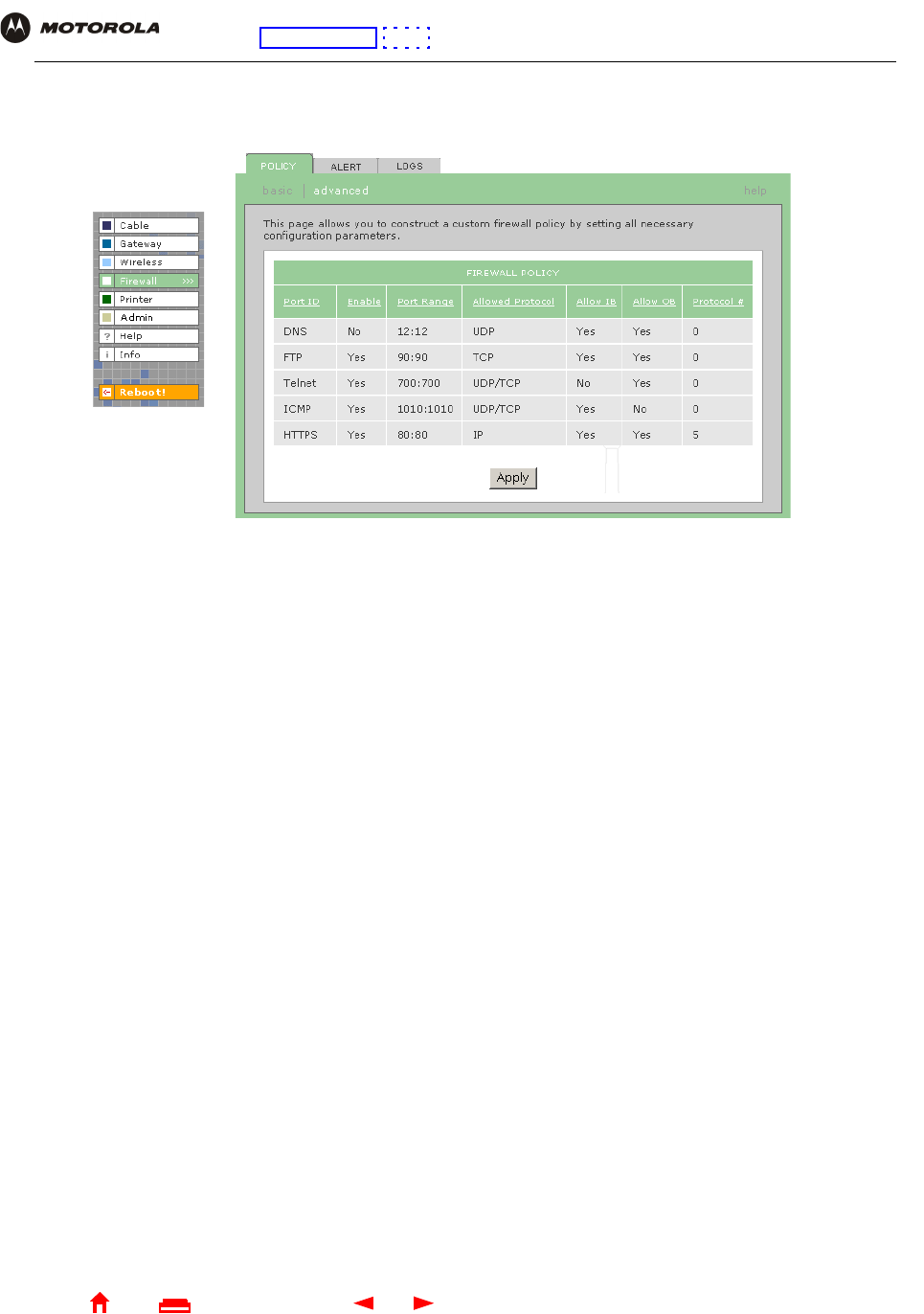
39 SBG1000 Wireless Cable Modem Gateway User Guide
Home
X
E
xitPrint
Overview Installation Troubleshooting Contact FAQ Specifications Glossary License
Configuration: Basic Gateway TCP/IP Wireless Print Server USB
Firewall > POLICY — advanced Page
Use this page to construct a custom firewall policy.
Firewall > POLICY — advanced page fields
Field Description
Port ID The name of the protocol being filtered.
Enable Check this box to enable firewall policy filtering for the port.
Port Range
(From:To) Sets the from and to port range, which must contain all ports required by the protocol.
Allowed Protocol The allowed protocols.
Allow IB (Inbound) Filters inbound data from the Internet on the specified ports.
Allow OB (Outbound) Filters outbound data to the Internet on the specified ports. Stateful inspection ensures
appropriate responses for outbound sessions.
Protocol # The protocol number associated with the IP packets to allow in the firewall policy.
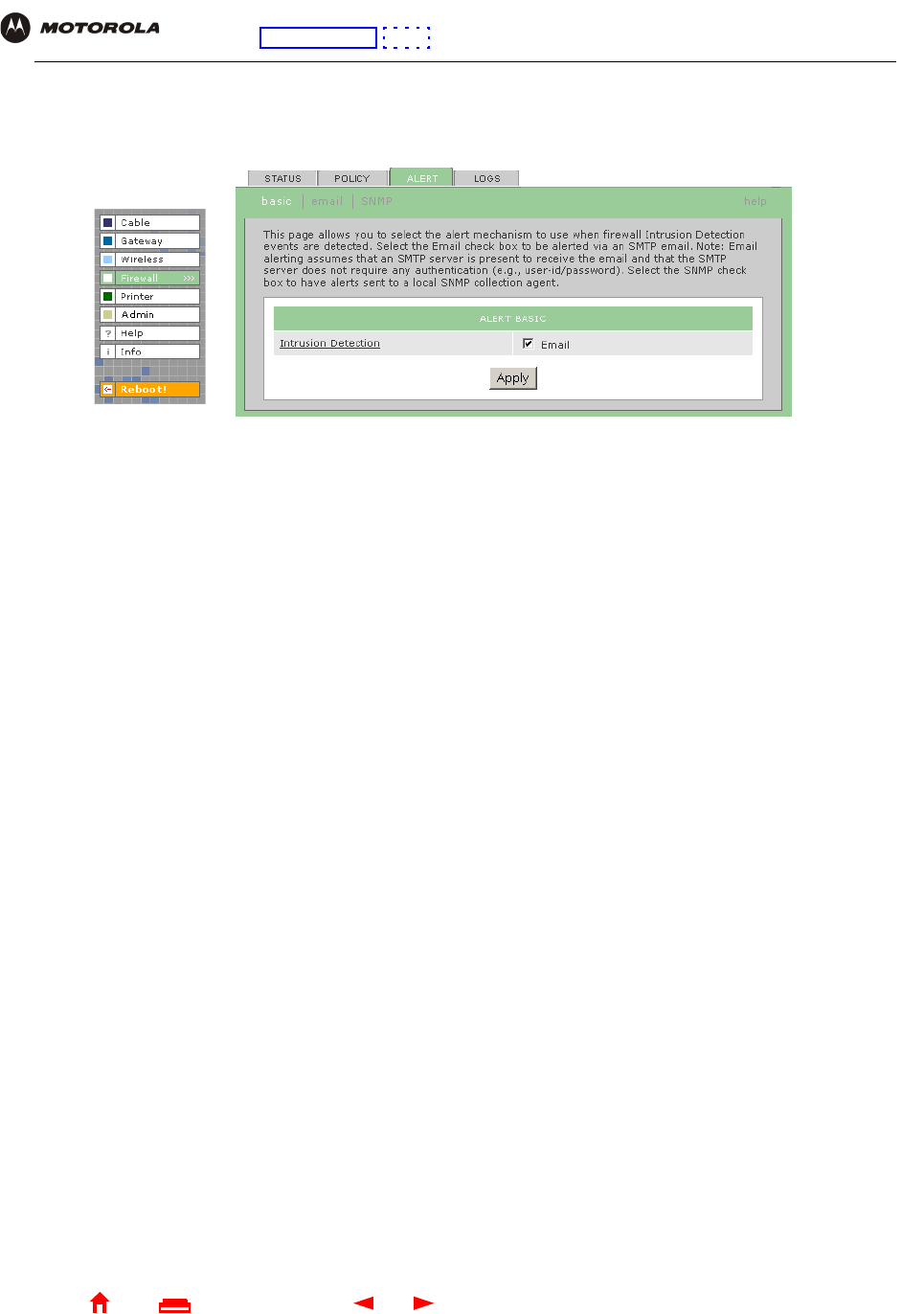
40 SBG1000 Wireless Cable Modem Gateway User Guide
Home
X
E
xitPrint
Overview Installation Troubleshooting Contact FAQ Specifications Glossary License
Configuration: Basic Gateway TCP/IP Wireless Print Server USB
Firewall > ALERT — basic Page
Use this page to set the alert mechanism for firewall intrusion detection events.
Firewall > ALERT — basic page fields
Field or Button Description
Intrusion Detection Check Email to be alerted through SMTP e-mail. An SMTP server that does not require any
authentication such as a user name or password must be present to receive the e-mail.
Apply Click to apply your changes.
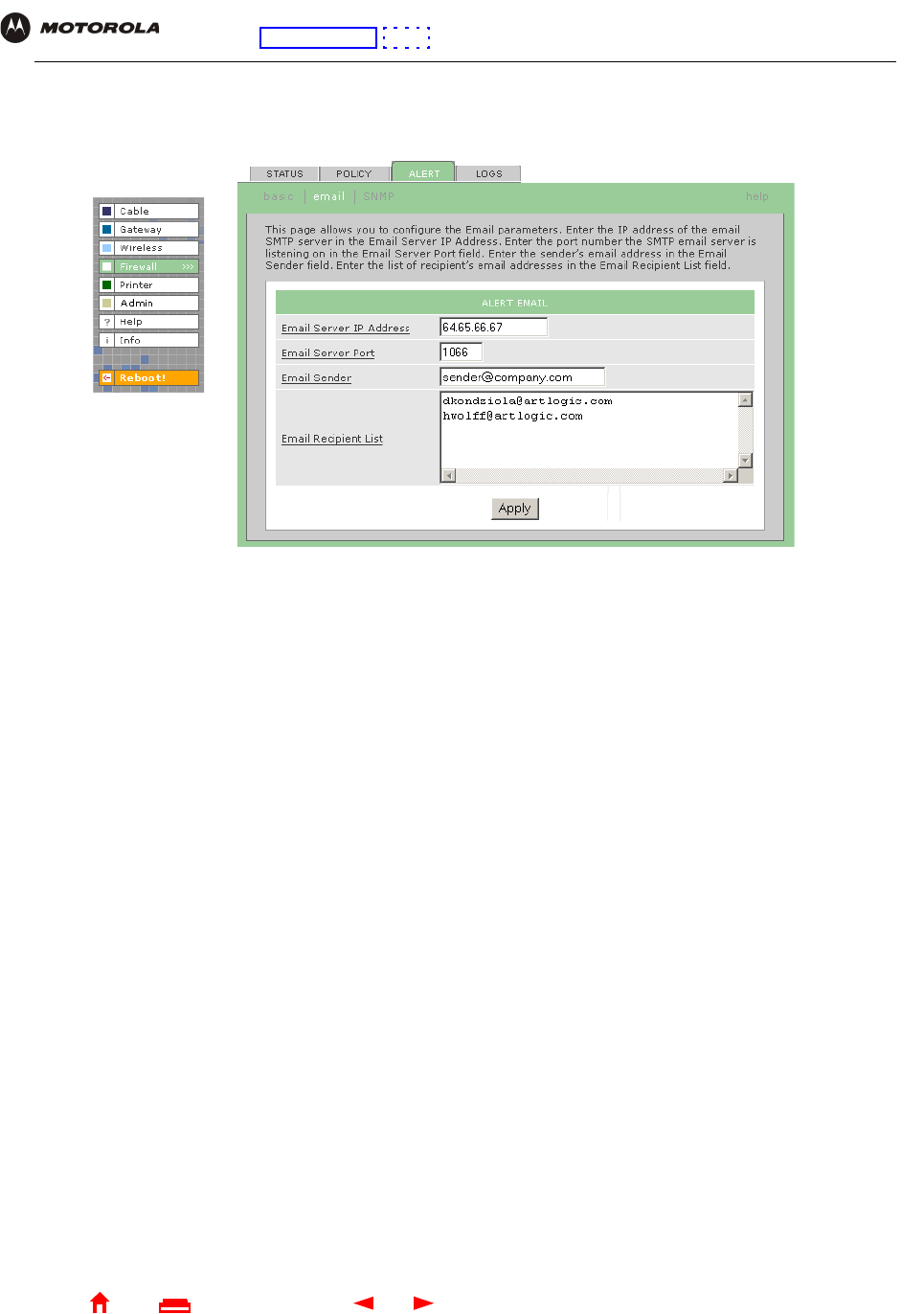
41 SBG1000 Wireless Cable Modem Gateway User Guide
Home
X
E
xitPrint
Overview Installation Troubleshooting Contact FAQ Specifications Glossary License
Configuration: Basic Gateway TCP/IP Wireless Print Server USB
Firewall > ALERT — email Page
Use this page to configure the e-mail alert parameters:
Firewall > ALERT — email page fields
Field or Button Description
E-mail Server IP Address Sets the e-mail server IP address, in dotted-decimal format.
E-mail Server Port Sets the e-mail server port number.
E-mail Sender Sets the sender e-mail address.
E-mail Recipient List Sets the list of e-mail addresses that receive alerts from the SBG1000 firewall.
Apply Click to apply your changes.
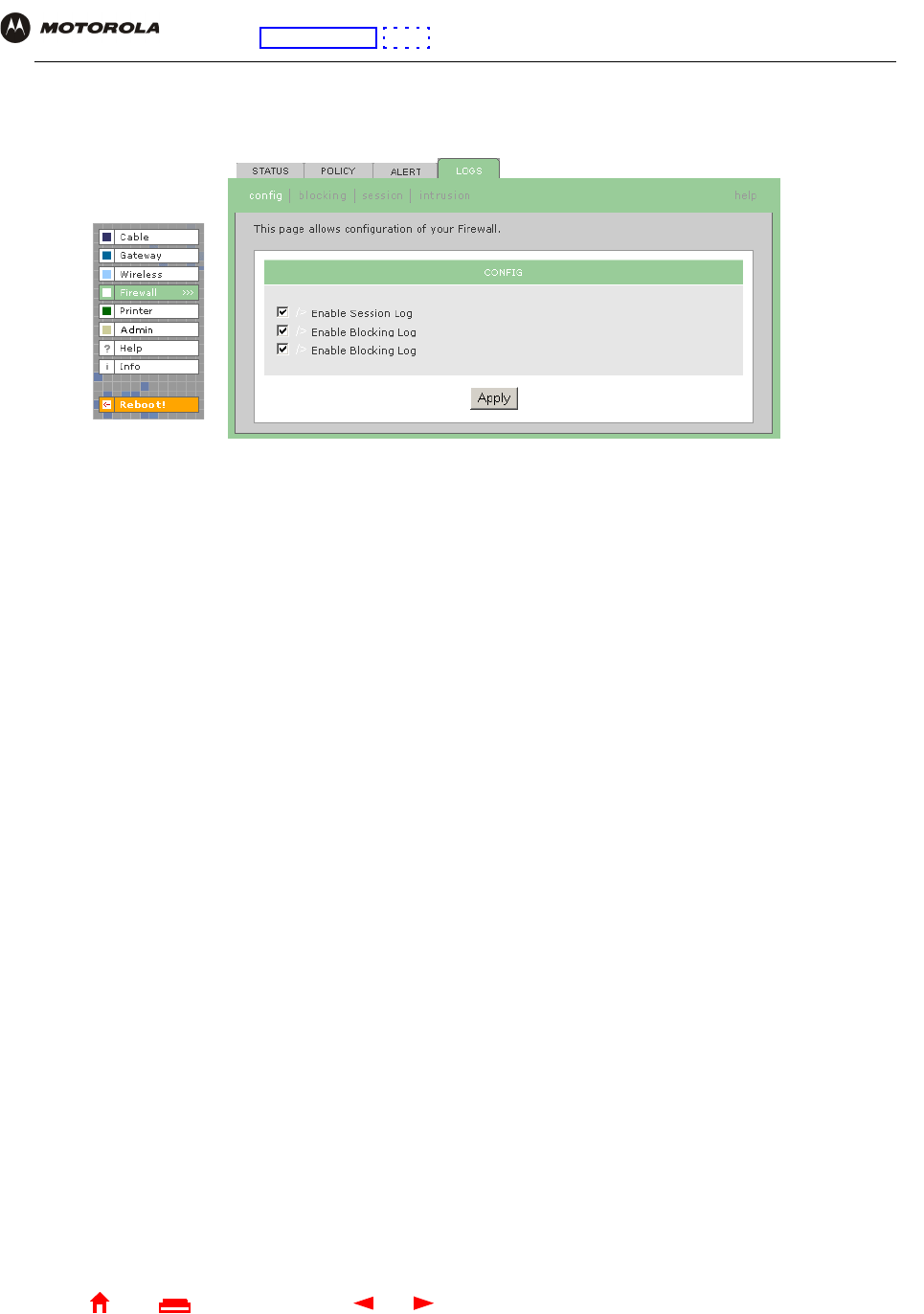
42 SBG1000 Wireless Cable Modem Gateway User Guide
Home
X
E
xitPrint
Overview Installation Troubleshooting Contact FAQ Specifications Glossary License
Configuration: Basic Gateway TCP/IP Wireless Print Server USB
Firewall > LOGS Page
Use this page to set which firewall events are logged.
Firewall > LOGS page fields
Field or Button Description
Enable Session Log Check this box to log session events.
Enable Blocking Log Check this box to log blocking events.
Enable Intrusion Log Check this box to log intrusions.
Apply Click to apply your changes.
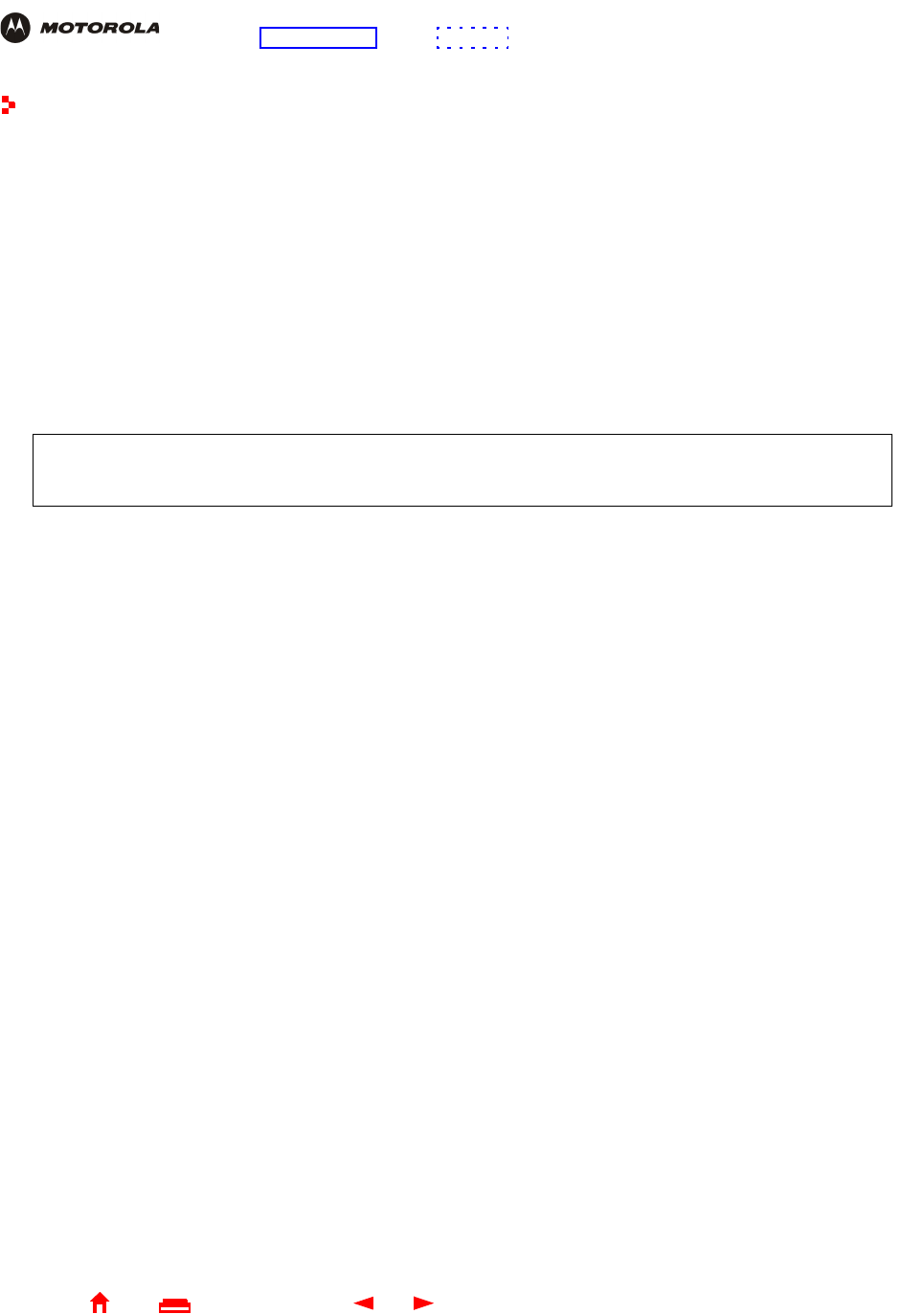
43 SBG1000 Wireless Cable Modem Gateway User Guide
Home
X
E
xitPrint
Overview Installation Troubleshooting Contact FAQ Specifications Glossary License
Configuration: Basic Gateway TCP/IP Wireless Print Server USB
Configuring the Gateway
This section describes the Gateway configuration pages in the SBG1000 Setup Program:
•Gateway > STATUS Page (see page 44)
•Gateway > WAN Page (see page 45)
•Gateway > LAN — nat config Page (see page 47)
•Gateway > LAN — dhcp server config Page (see page 48)
•Gateway > LAN — dhcp reservations Page (see page 49)
•Gateway > LOG Page (see page 51)
For some settings, after you edit the field and click Apply, you are warned that you must Reboot for your
change to take effect. Rebooting takes 10 to 15 seconds. After rebooting, you must log-in again.
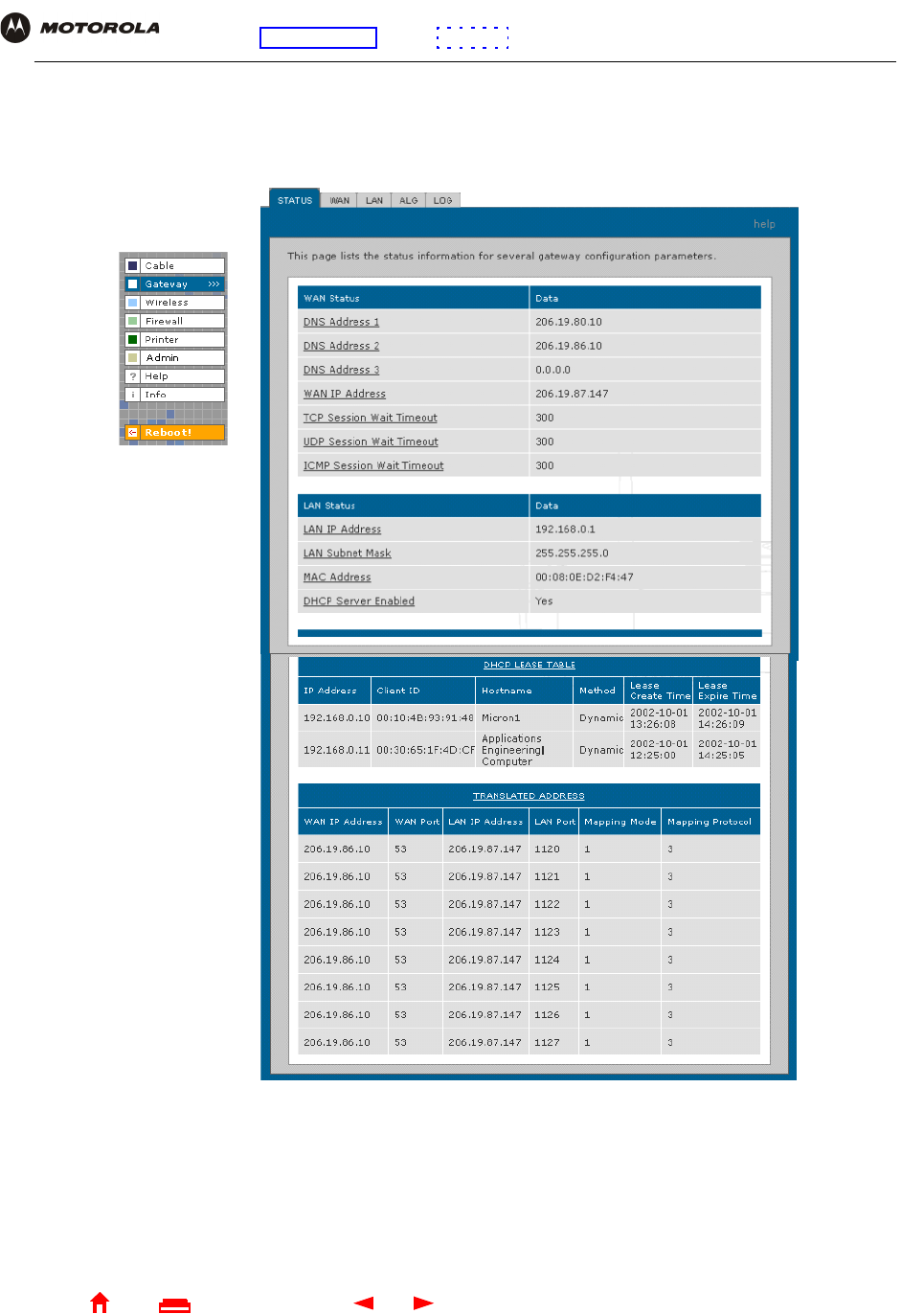
44 SBG1000 Wireless Cable Modem Gateway User Guide
Home
X
E
xitPrint
Overview Installation Troubleshooting Contact FAQ Specifications Glossary License
Configuration: Basic Gateway TCP/IP Wireless Print Server USB
Gateway > STATUS Page
This page displays the gateway status information:
These fields display settings that are set on the other Gateway pages. For descriptions, see the sections about
those pages.
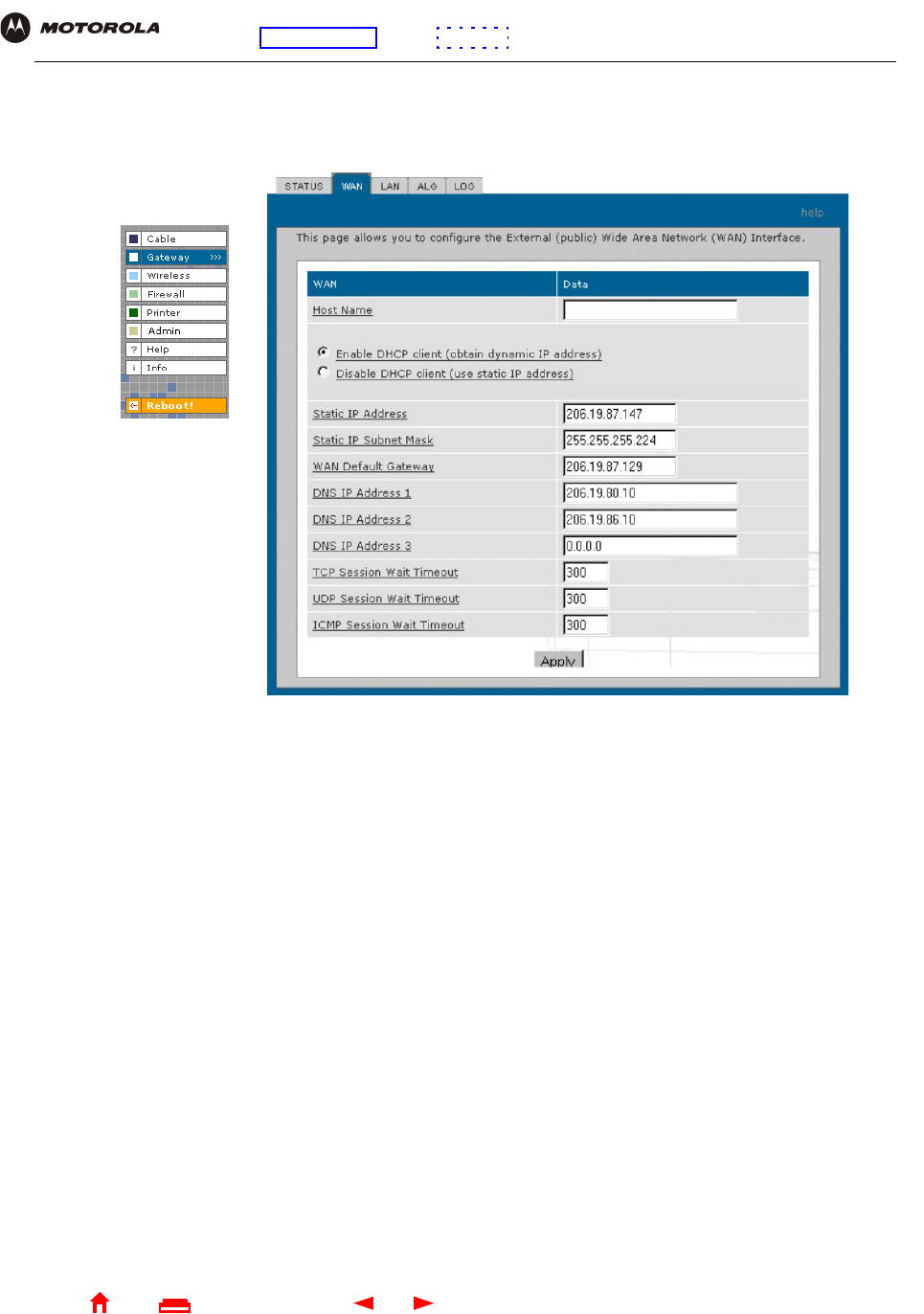
45 SBG1000 Wireless Cable Modem Gateway User Guide
Home
X
E
xitPrint
Overview Installation Troubleshooting Contact FAQ Specifications Glossary License
Configuration: Basic Gateway TCP/IP Wireless Print Server USB
Gateway > WAN Page
Use this page to configure the external (public) wide area network (WAN) interface:
Gateway > WAN page fields
Field Description
Host Name If the cable service provider requires a hostname to access to their network, type the hostname
they provided in this field. The default is None.
Enable DHCP Client Enabling the DHCP client causes the wireless gateway to automatically obtain the public IP
address, subnet mask, domain name, and DNS server(s). Most commonly, the DHCP client is
enabled if the cable service provider automatically assigns a public IP address from their
DHCP server. Enable DHCP Client is on by default.
Disable DHCP Client If the cable service provider does not automatically assign a public IP address using DHCP,
they must provide a static IP address. Select Disable DHCP Client. When you disable the
DHCP client, you must type the static IP address, subnet mask, DNS server(s), and domain
name (if necessary) in the fields provided. Disable DHCP Client is off by default.
Static IP Address If Disable DHCP Client is on, type the static IP address provided by the cable service provider,
in dotted-decimal format. The default is None.
Static IP Address
Subnet Mask If Disable DHCP Client is on, type the subnet mask associated with the static IP address, in
dotted-decimal format. The default is None.
Domain Name If the cable service provider requires a domain name, type the domain name they provided you
in this field. The default is None.

46 SBG1000 Wireless Cable Modem Gateway User Guide
Home
X
E
xitPrint
Overview Installation Troubleshooting Contact FAQ Specifications Glossary License
Configuration: Basic Gateway TCP/IP Wireless Print Server USB
DNS IP Address 1
DNS IP Address 2
DNS IP Address 3
The cable service provider DNS server provides name-to-IP address resolution. If the cable
service provider does not automatically assign DNS addresses from their DHCP server, they
must provide at least one DNS server IP address to enter in these fields, in dotted-decimal
format. The default is None.
TCP Session Wait
Timeout Sets the maximum time in minutes to wait before assuming a TCP session has timed out. The
default is 5 minutes.
UDP Session Wait
Timeout Sets the maximum time in minutes to wait before assuming a UDP session has timed out. The
default is 5 minutes.
ICMP Session Wait
Timeout Sets the maximum time in minutes to wait before assuming an ICMP session has timed out.
The default is 5 minutes.
Apply Click to apply your changes.
Gateway > WAN page fields (continued)
Field Description
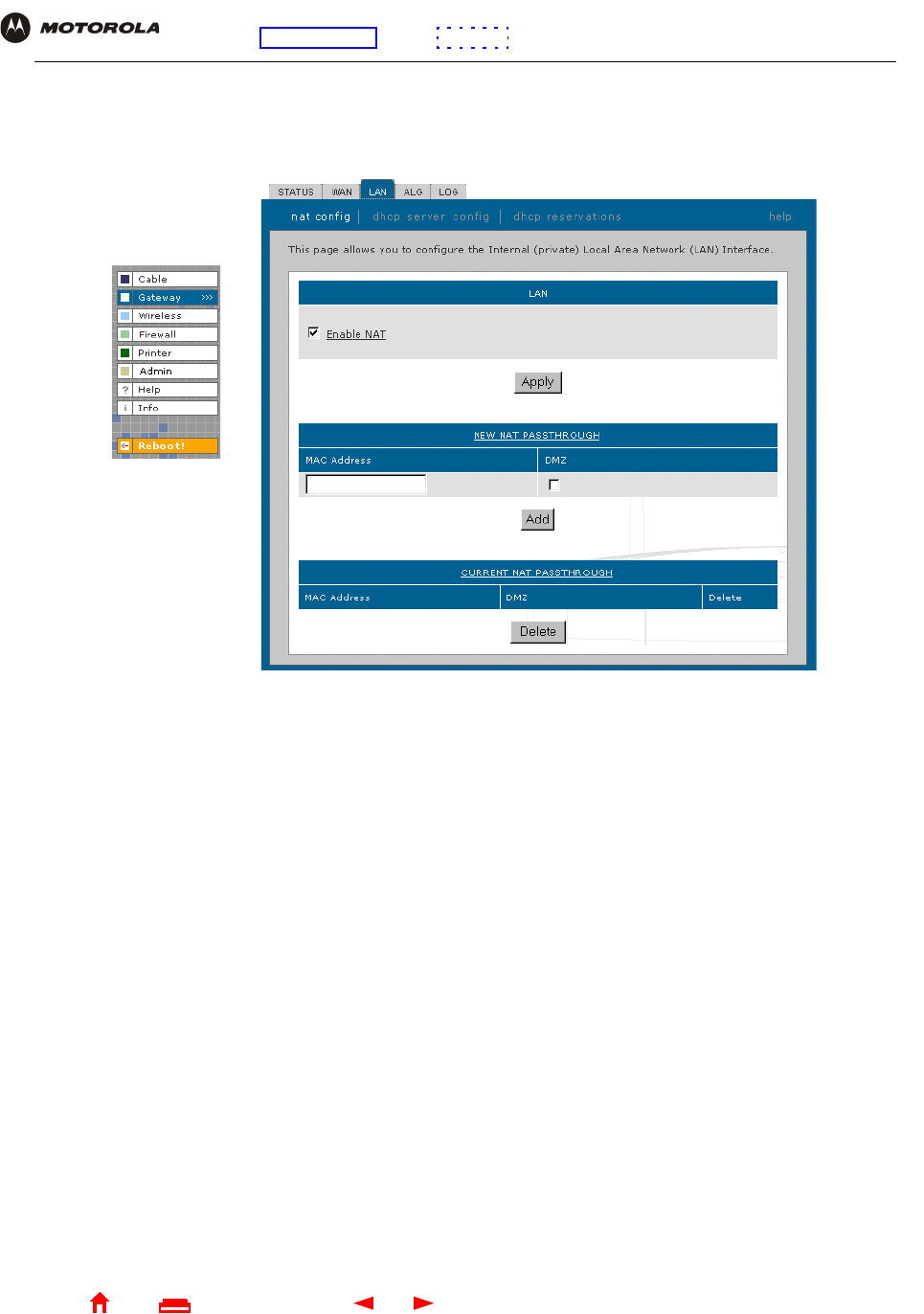
47 SBG1000 Wireless Cable Modem Gateway User Guide
Home
X
E
xitPrint
Overview Installation Troubleshooting Contact FAQ Specifications Glossary License
Configuration: Basic Gateway TCP/IP Wireless Print Server USB
Gateway > LAN — nat config Page
Use this page to configure NAT:
Gateway > LAN — nat config page fields
Field or Button Description
LAN
Enable NAT If enabled, the single HFC IP Address (public IP address) assigned by the cable service
provider is mapped to many private IP addresses on the SBG1000 LAN.
Apply Click to apply your changes. You must reboot the SBG1000.
NEW NAT
PASSTHROUGH NAT Passthrough is used to identify which CPEs are passthrough devices, not subject to
network address translation. Up to 32 NAT passthrough CPEs can be entered using the
CPE MAC address. When configuring a CPE as a NAT passthrough device, you may also
identify whether the CPE should be treated as a de-militarized zone (DMZ) host. A DMZ host
is a CPE device that is completely exposed to the Internet. Any CPE device configured as a
DMZ is open to Internet hackers and should be used with extreme caution.
MAC Address Sets the MAC address of the passthrough client. The format is 16 hexadecimal numerals.
DMZ Check the box to set the MAC address as a de-militarized zone (DMZ) client. A DMZ is a
computer on the LAN that can be accessed from the public Internet.
Add Click to add the IP address to the reserved IP address table.
CURRENT NAT
PASSTHROUGH Displays the NAT passthrough list.
Delete Click to delete the MAC address from the NAT passthrough list.

48 SBG1000 Wireless Cable Modem Gateway User Guide
Home
X
E
xitPrint
Overview Installation Troubleshooting Contact FAQ Specifications Glossary License
Configuration: Basic Gateway TCP/IP Wireless Print Server USB
Gateway > LAN — dhcp server config Page
Experienced network administrators only can use this page to perform advanced DHCP server configuration:
CAUTION!
Do not modify these settings unless you are an experienced network administrator with strong
knowledge of IP addressing, subnetting, and DHCP.
Gateway > LAN — advanced page fields
Field Description
LAN IP Address Sets the SBG1000 LAN IP address, in dotted-decimal format. The default is 192.168.0.1.
LAN IP Subnet Mask Sets the subnet mask, in dotted-decimal format. The default is 255.255.255.0
Starting IP Address Sets the starting IP address assigned by the SBG1000 DHCP server to clients, in
dotted-decimal format. The default is 192.168.0.2.
# of DHCP Users Sets the number of clients for the SBG1000 DHCP server to assign a private IP address.
There are 253 possible client addresses. The default is 253.
DHCP Server Lease
Time Sets the time in seconds that the SBG1000 DHCP server leases an IP address to a client. The
default is 60 seconds.
Domain Name Sets the domain name for the SBG1000 LAN. The default is None.
Time To Live Sets the TTL (hop limit) for outbound packets. The default is 64.
Interface Maximum
Transmission Unit Sets the SBG1000 LAN MTU, in bytes. The minimum is 68 bytes. The default is 1500 bytes.
Apply Click to apply your changes. You must reboot the SBG1000.
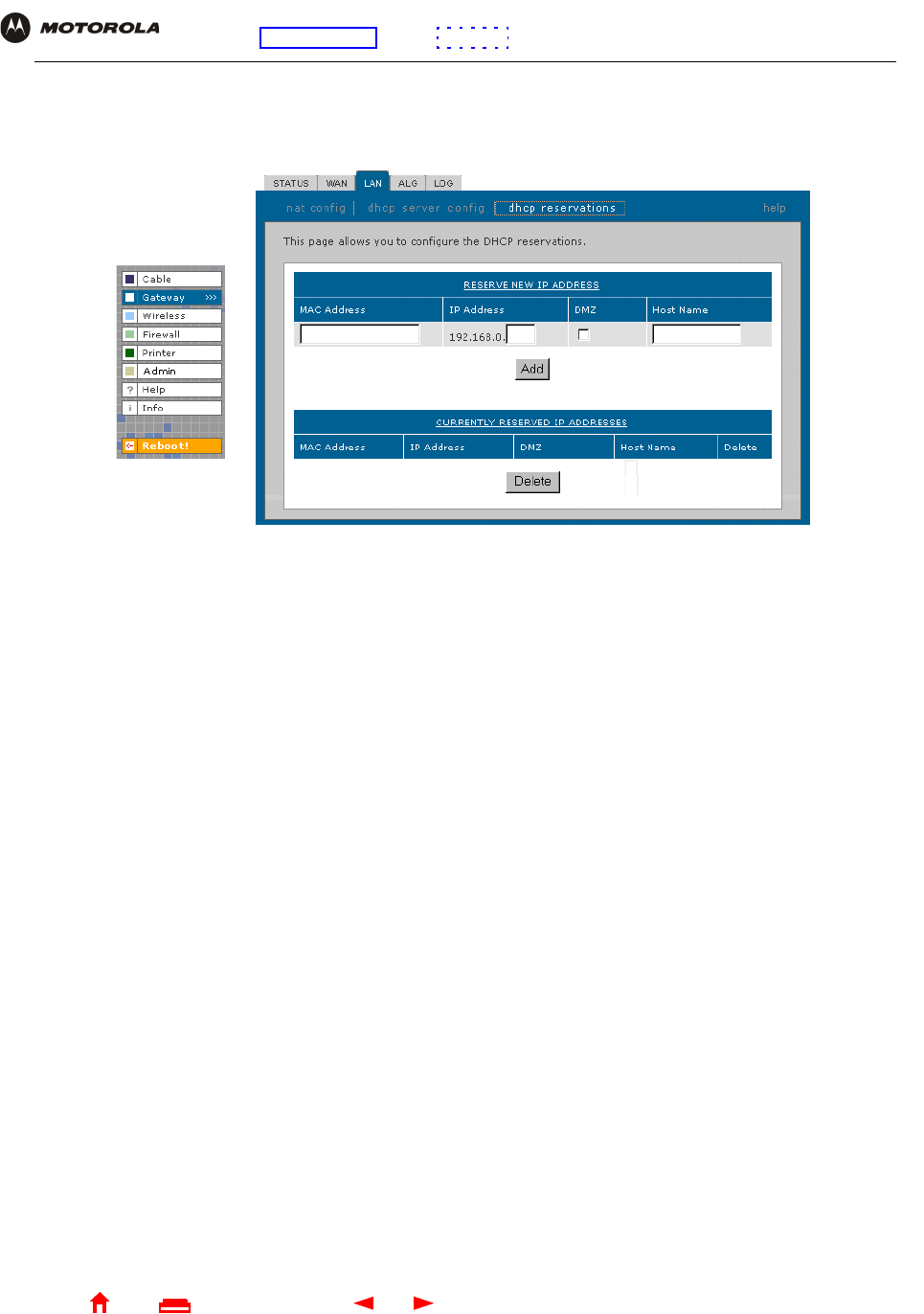
49 SBG1000 Wireless Cable Modem Gateway User Guide
Home
X
E
xitPrint
Overview Installation Troubleshooting Contact FAQ Specifications Glossary License
Configuration: Basic Gateway TCP/IP Wireless Print Server USB
Gateway > LAN — dhcp reservations Page
Use this page to configure DHCP reservations:
Gateway > LAN — dhcp reservations page fields
Field Description
RESERVE NEW IP
ADDRESS You can reserve up to 32 IP addresses assigned by the SBG1000 DHCP server for specific
LAN clients. For example, you can reserve an IP address for a private FTP server to ensure
that it always receives the same private IP address.
MAC Address Type the MAC address of the DHCP client for which a reserved IP address is required. The
format is 16 hexadecimal numerals.
IP Address Sets the host portion of the reserved IP address for the LAN client having the specified MAC
address. When the LAN client requests an IP address, the SBG1000 DHCP server assigns
the client this IP address.
DMZ Check this box if you want the host to bypass NAT and be exposed directly to the Internet.
When configuring a client as a NAT passthrough device, you can specify whether it should be
a de-militarized zone (DMZ) host. A DMZ host is completely exposed to the Internet. Any
device configured as a DMZ is open to Internet hackers and should be used with extreme
caution.
Host Name If your ISP requires a hostname to access their network, enter the hostname provided to you
in the Host Name field.
Add Click Add to reserve a new IP address.

50 SBG1000 Wireless Cable Modem Gateway User Guide
Home
X
E
xitPrint
Overview Installation Troubleshooting Contact FAQ Specifications Glossary License
Configuration: Basic Gateway TCP/IP Wireless Print Server USB
Gateway > ALG — basic Page
This may not be supported in your code release. For the most recent documentation, visit the Product
Documentation page on www.motorola.com/broadband.
Gateway > ALG — advanced Page
This may not be supported in your code release. For the most recent documentation, visit the Product
Documentation page on www.motorola.com/broadband.
CURRENTLY
RESERVED IP
ADDRESSES
Displays all DHCP clients that have specific IP addresses reserved for their use by MAC and
IP address.
MAC Address Displays the reserved MAC addresses.
IP Address Displays the reserved IP addresses.
DMZ Displays whether the client is configured as a DMZ.
Host Name Displays the host name.
Delete Click this box to remove the reserved IP address for the client.
Delete Click this button to remove the reserved IP addresses for clients designated by the Delete
box.
Gateway > LAN — dhcp reservations page fields (continued)
Field Description
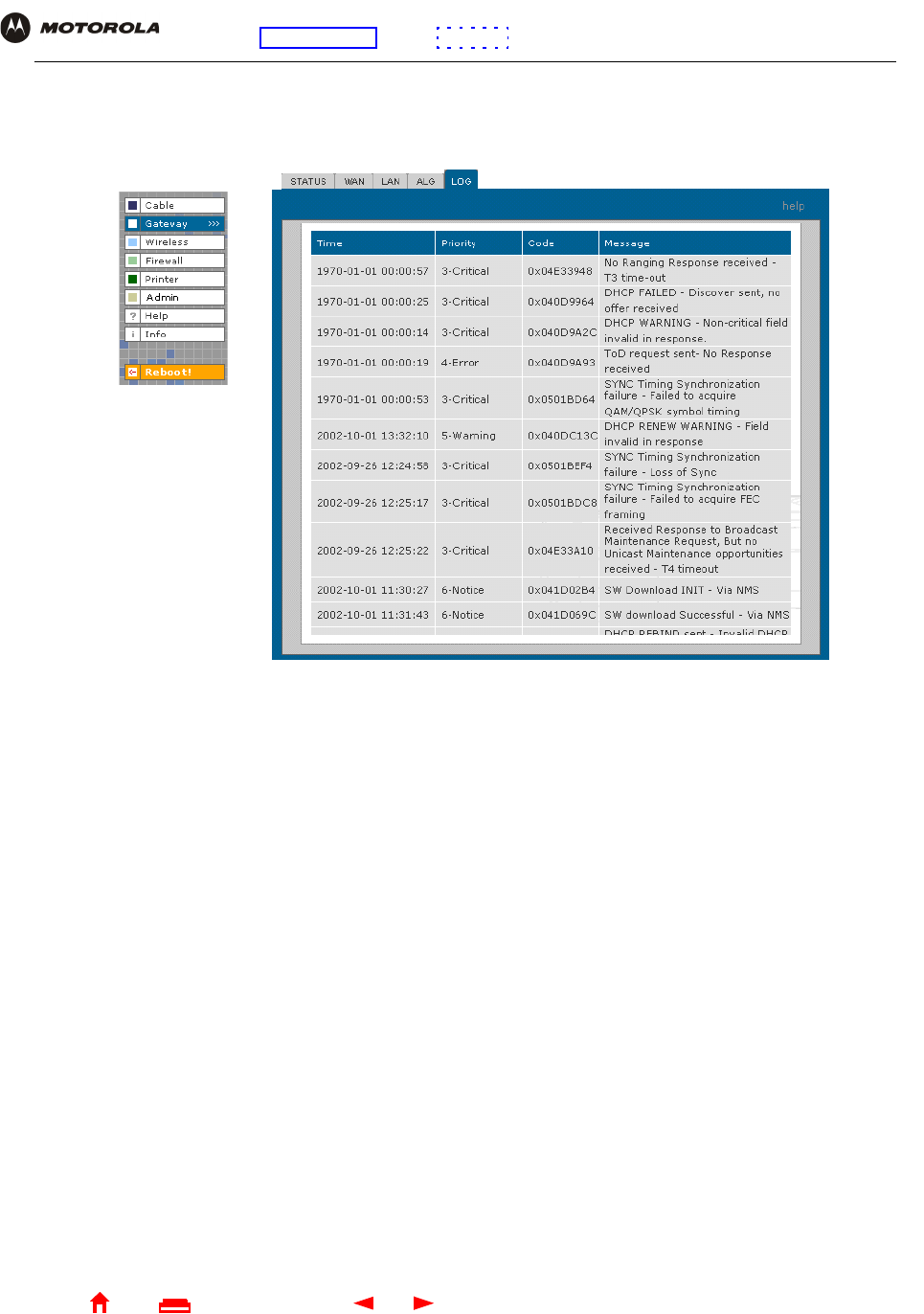
51 SBG1000 Wireless Cable Modem Gateway User Guide
Home
X
E
xitPrint
Overview Installation Troubleshooting Contact FAQ Specifications Glossary License
Configuration: Basic Gateway TCP/IP Wireless Print Server USB
Gateway > LOG Page
Use this page to:
Gateway > LOG page fields
Field Description
Time The data and time in the format yyyy-mm-dd hh:mm:ss (hours hh are 00 to 23)
Priority Indicates the importance of the message.
Code
Message Describes the event.
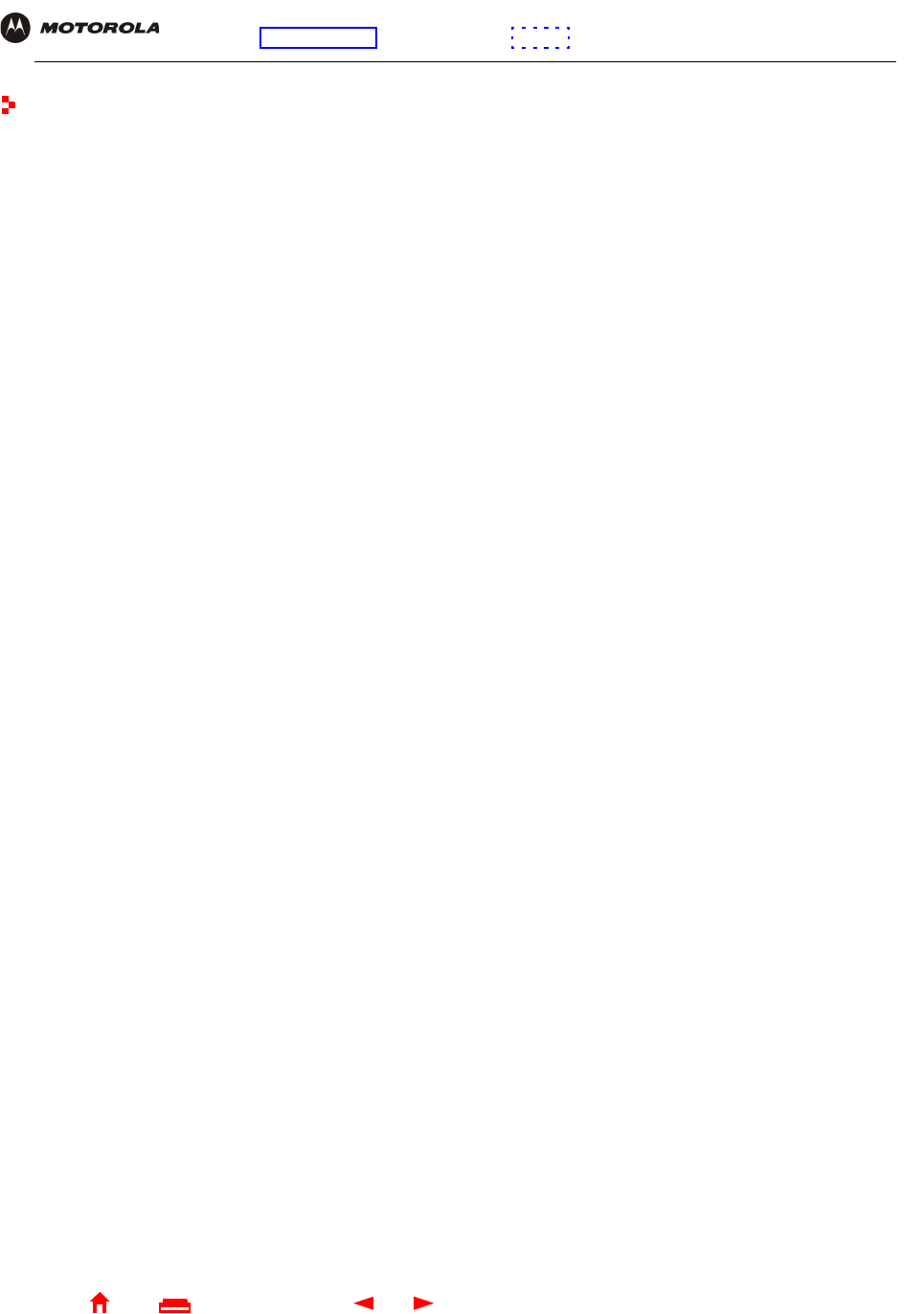
53 SBG1000 Wireless Cable Modem Gateway User Guide
Home
X
E
xitPrint
Overview Installation Troubleshooting Contact FAQ Specifications Glossary License
Configuration: Basic Gateway TCP/IP Wireless Print Server USB
Configuring TCP/IP
You must be sure all client computers are configured for TCP/IP (a protocol for communication between
computers). Perform one of:
•“Configuring TCP/IP in Windows 95, Windows 98, or Windows Me” on page 54
•“Configuring TCP/IP in Windows 2000” on page 56
•“Configuring TCP/IP in Windows XP” on page 60
•Follow the instructions in your Macintosh or UNIX user manual
After configuring TCP/IP, perform one of the following to verify the IP address:
•“Verifying the IP Address in Windows 95, Windows 98, or Windows Me” on page 64
•“Verifying the IP Address in Windows 2000 or Windows XP” on page 65
•Follow the instructions in your Macintosh or UNIX user manual
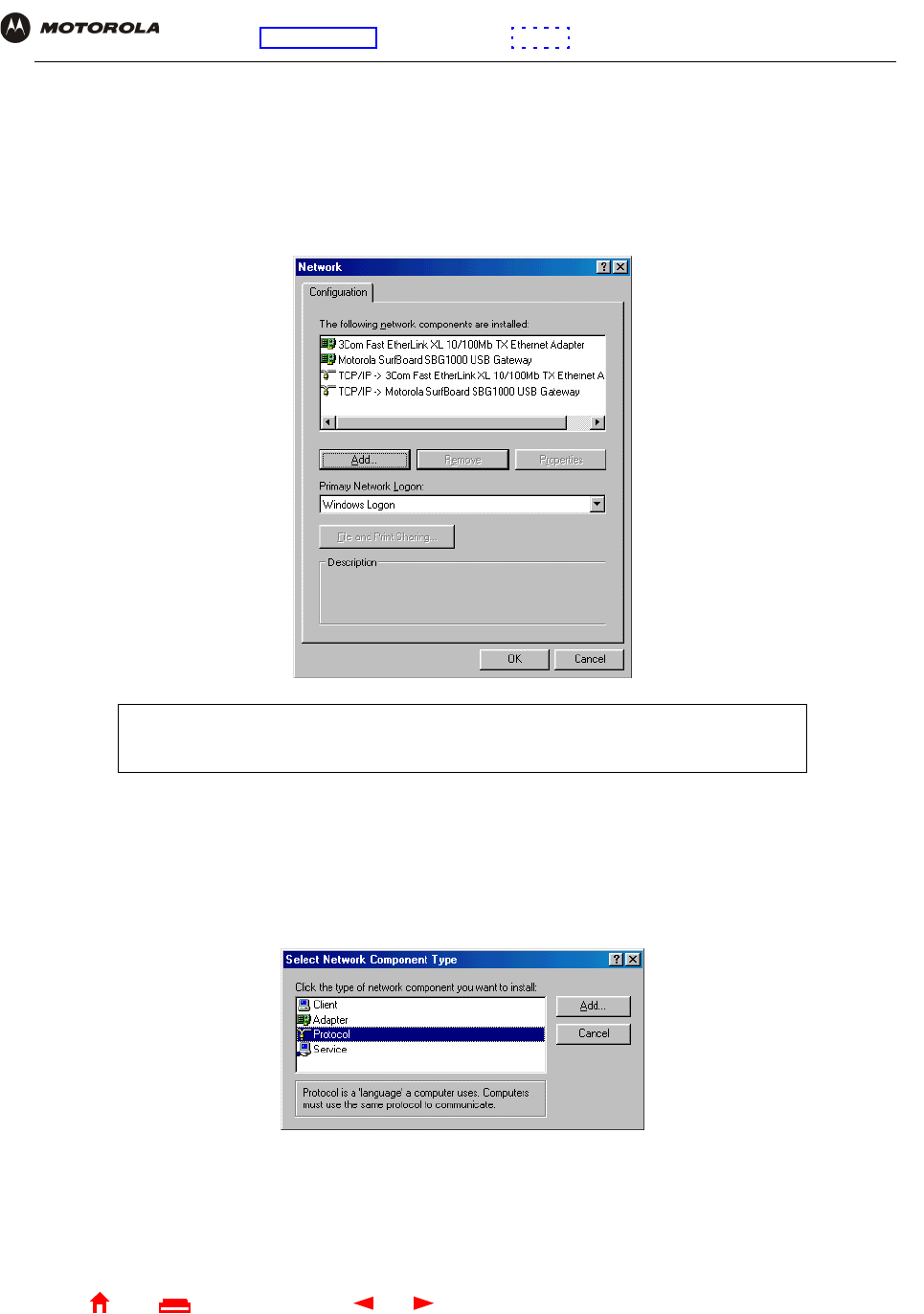
54 SBG1000 Wireless Cable Modem Gateway User Guide
Home
X
E
xitPrint
Overview Installation Troubleshooting Contact FAQ Specifications Glossary License
Configuration: Basic Gateway TCP/IP Wireless Print Server USB
Configuring TCP/IP in Windows 95, Windows 98, or Windows Me
1On the Windows Desktop, click Start.
2Select Settings and then Control Panel from the pop-up menus to display the Control Panel window.
3Double-click the Network icon to display the Network window:
4Select the Configuration tab.
5Verify that TCP/IP is installed for the adapter used to connect to the SBG1000. If TCP/IP is installed, skip to
step 10. If TCP/IP is not installed for the adapter, continue with step 6.
6Select the adapter to use for the SBG1000 connection and click Add. The Select Network Component Type
window is displayed:
7Click Protocol and click the Add button.
Although your SBG model number may be different than in the images in this guide,
the procedure is the same.
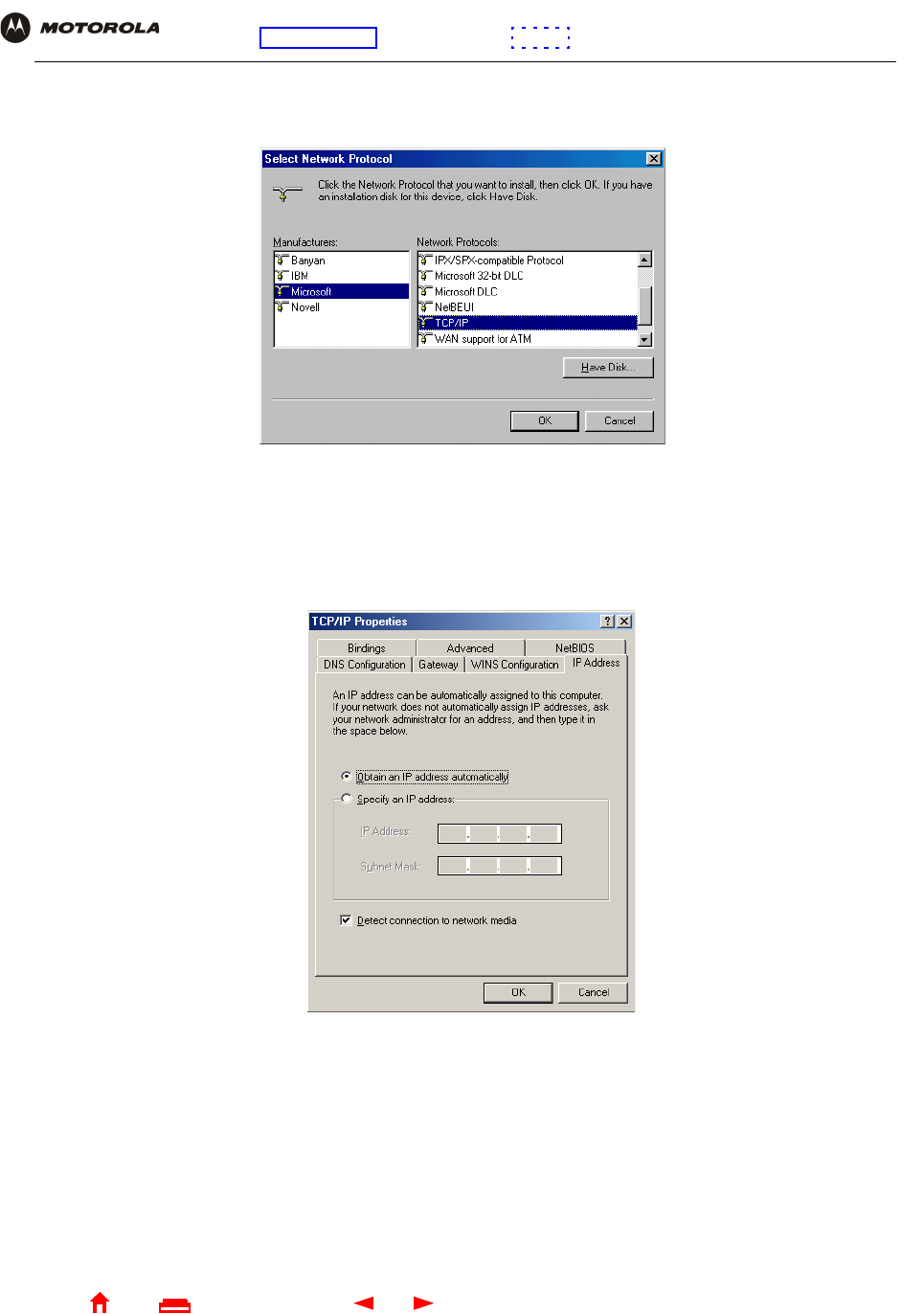
55 SBG1000 Wireless Cable Modem Gateway User Guide
Home
X
E
xitPrint
Overview Installation Troubleshooting Contact FAQ Specifications Glossary License
Configuration: Basic Gateway TCP/IP Wireless Print Server USB
8Click Microsoft in the Manufacturers section and click TCP/IP in the Network Protocol section of Select
Network Protocol window:
9Click OK.
10 Click TCP/IP on the Network window. If there is more than one TCP/IP entry, choose the one for the Ethernet
card or USB port connected to the SBG1000.
11 Click Properties. The TCP/IP Properties window is displayed:
12 Click the IP Address tab.
13 Click Obtain an IP address automatically.
14 Click OK to accept the TCP/IP settings.
15 Click OK to close the Network window.
16 Click OK when prompted to restart the computer and click OK again.
When you complete TCP/IP configuration, go to “Verifying the IP Address in Windows 95, Windows 98, or
Windows Me” on page 64.
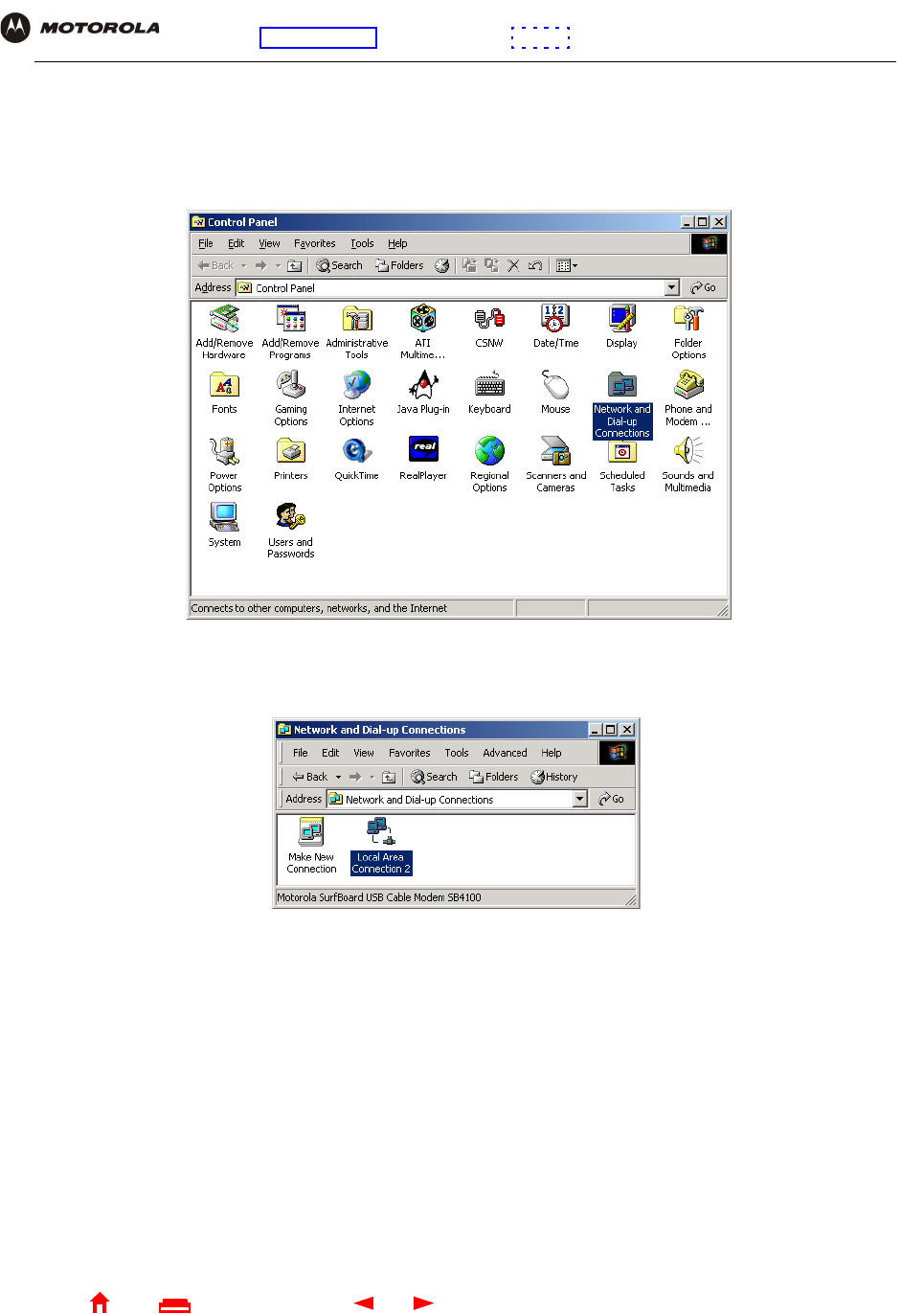
56 SBG1000 Wireless Cable Modem Gateway User Guide
Home
X
E
xitPrint
Overview Installation Troubleshooting Contact FAQ Specifications Glossary License
Configuration: Basic Gateway TCP/IP Wireless Print Server USB
Configuring TCP/IP in Windows 2000
1On the Windows Desktop, click Start.
2Select Settings and then Control Panel from the pop-up menus to display the Control Panel window:
3Double-click the Network and Dial-up Connections icon to display the Network and Dial-up Connections
window:

57 SBG1000 Wireless Cable Modem Gateway User Guide
Home
X
E
xitPrint
Overview Installation Troubleshooting Contact FAQ Specifications Glossary License
Configuration: Basic Gateway TCP/IP Wireless Print Server USB
4Click Local Area Connection number. The value of number varies from system to system. The Local Area
Connection number Status window is displayed:
5Click Properties. Information similar to the following window is displayed:
6If Internet Protocol (TCP/IP) is in the list of components, TCP/IP is installed. You can skip to step 10.
If Internet Protocol (TCP/IP) is not in the list, click Install. The Select Network Component Type window is
displayed:
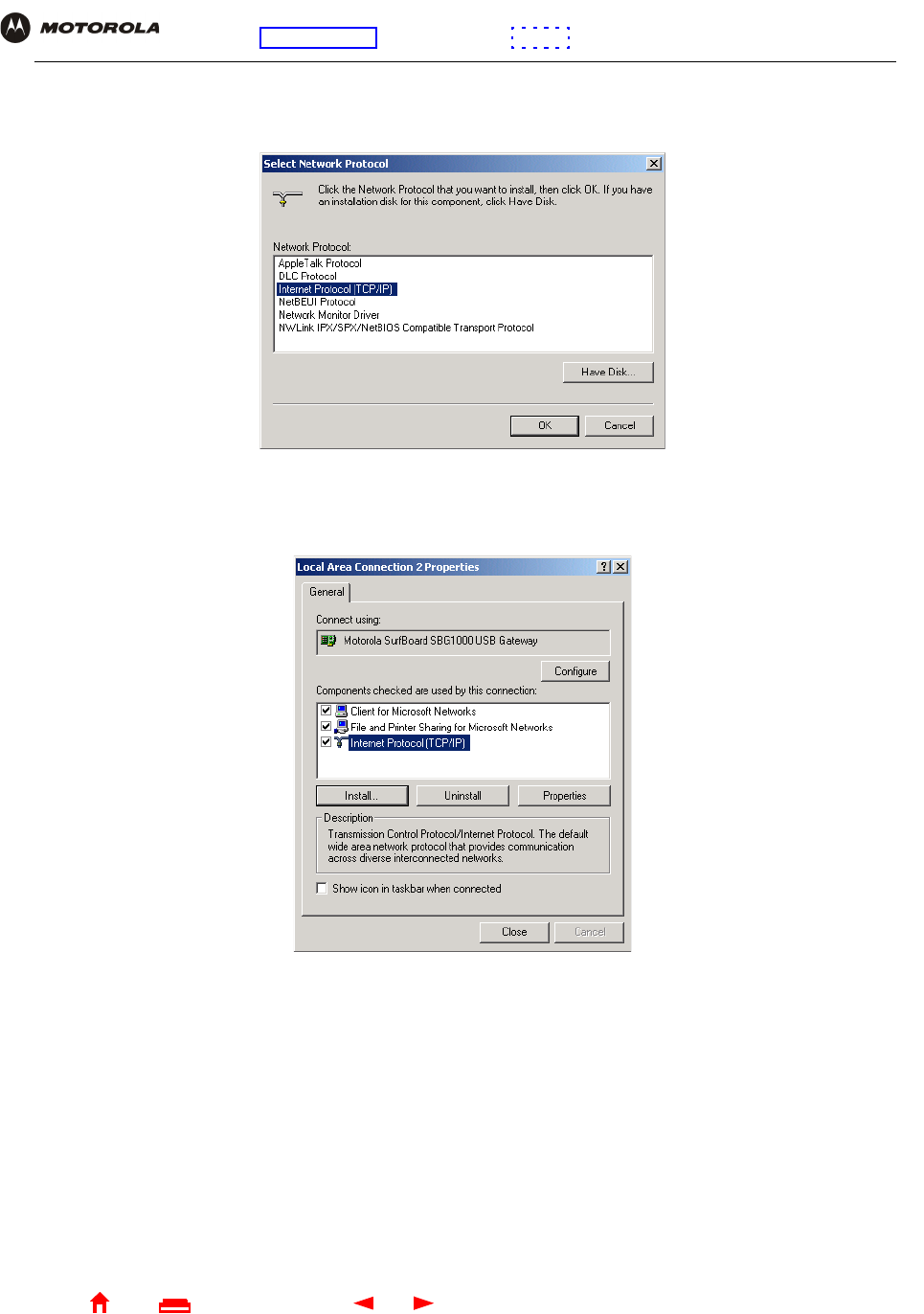
58 SBG1000 Wireless Cable Modem Gateway User Guide
Home
X
E
xitPrint
Overview Installation Troubleshooting Contact FAQ Specifications Glossary License
Configuration: Basic Gateway TCP/IP Wireless Print Server USB
7Click Protocol on the Select Network Component Type window and click Add. The Select Network Protocol
window is displayed:
8Click Internet Protocol (TCP/IP).
9Click OK. The Local Area Connection number Properties window is re-displayed.
10 Be sure the box next to Internet Protocol (TCP/IP) is checked.
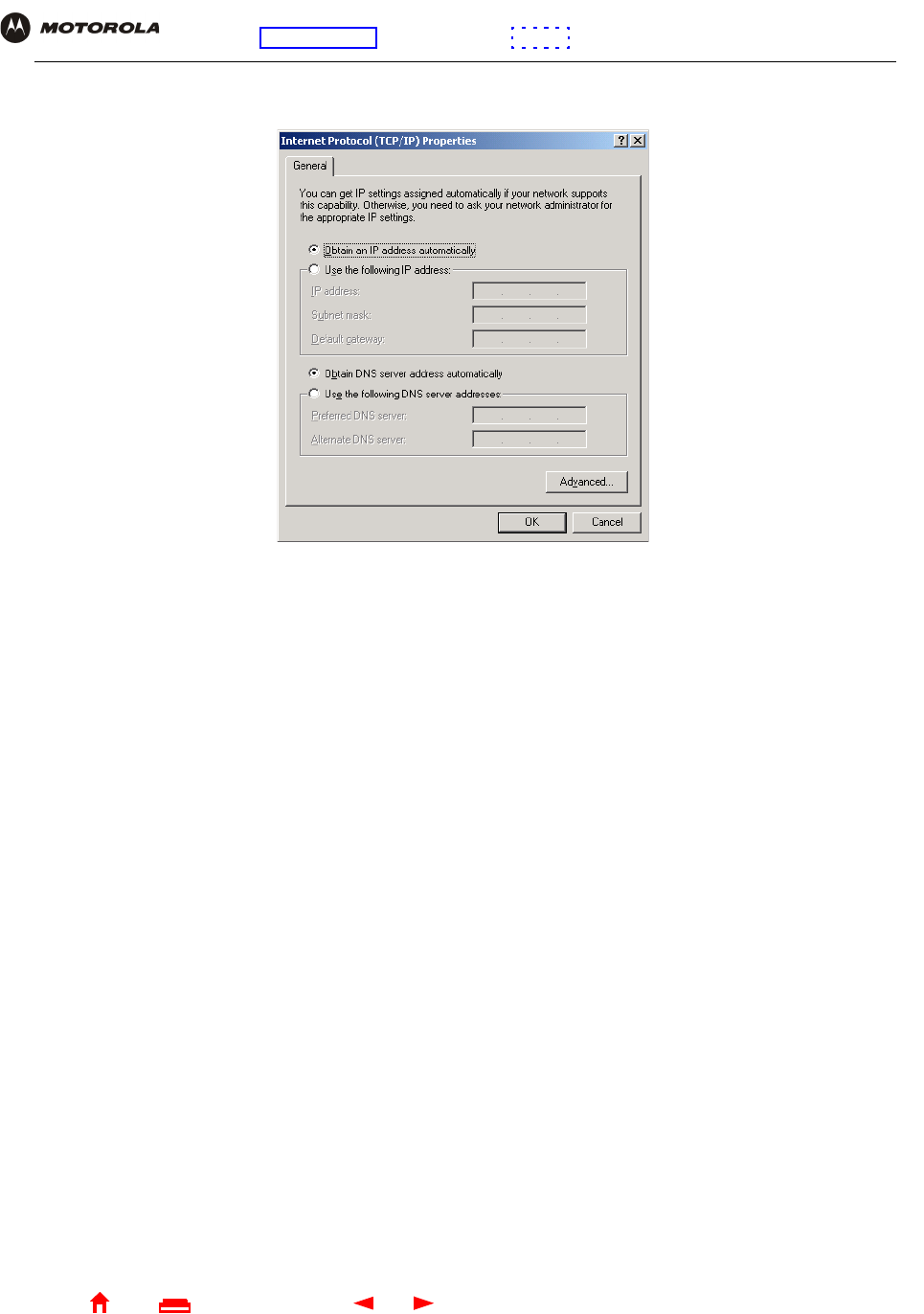
59 SBG1000 Wireless Cable Modem Gateway User Guide
Home
X
E
xitPrint
Overview Installation Troubleshooting Contact FAQ Specifications Glossary License
Configuration: Basic Gateway TCP/IP Wireless Print Server USB
11 Click Properties. The Internet Protocol (TCP/IP) Properties window is displayed:
12 Be sure Obtain IP address automatically and Obtain DNS server address automatically are selected.
13 Click OK to accept the TCP/IP settings.
14 Click OK to close the Local Area Connection number Properties window.
15 Click OK when prompted to restart the computer and click OK again.
When you complete the TCP/IP configuration, go to “Verifying the IP Address in Windows 2000 or Windows XP”
on page 65.

60 SBG1000 Wireless Cable Modem Gateway User Guide
Home
X
E
xitPrint
Overview Installation Troubleshooting Contact FAQ Specifications Glossary License
Configuration: Basic Gateway TCP/IP Wireless Print Server USB
Configuring TCP/IP in Windows XP
1On the Windows desktop, click Start to display the Start window:
2Click Control Panel to display the Control Panel window. The display varies, depending on the Windows XP
view options. If the display is a Category view as shown below, continue with step 3. Otherwise, skip to
step 5.
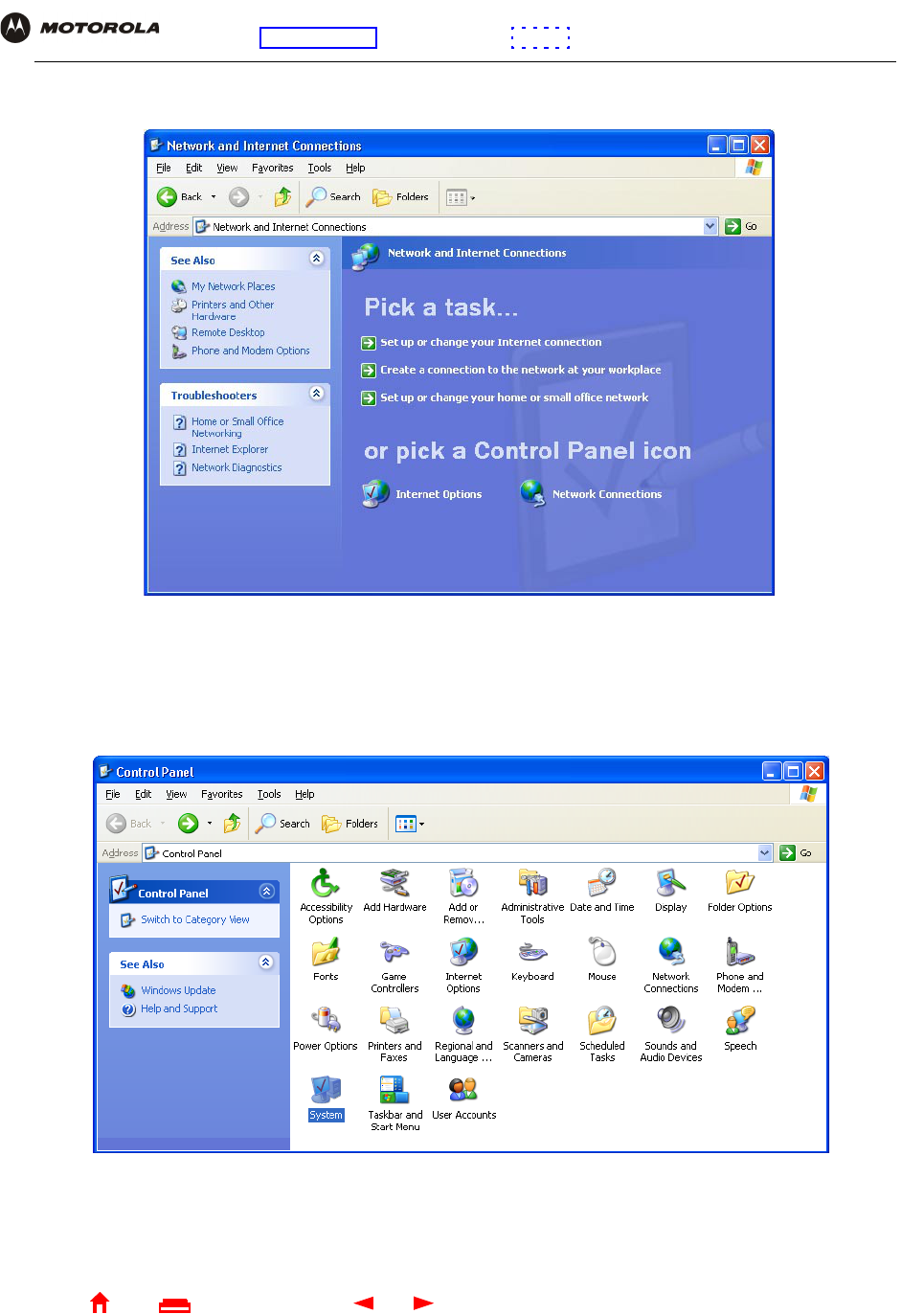
61 SBG1000 Wireless Cable Modem Gateway User Guide
Home
X
E
xitPrint
Overview Installation Troubleshooting Contact FAQ Specifications Glossary License
Configuration: Basic Gateway TCP/IP Wireless Print Server USB
3Click Network and Internet Connections to display the Network and Internet Connections window:
4On the Network and Internet Connections window in the “or pick a Control Panel icon, click Network
Connections to display the LAN or High-speed Internet connections. Skip to step 6.
5If a classic view similar to below is displayed, click Network Connections to display the LAN or High-speed
Internet connections:
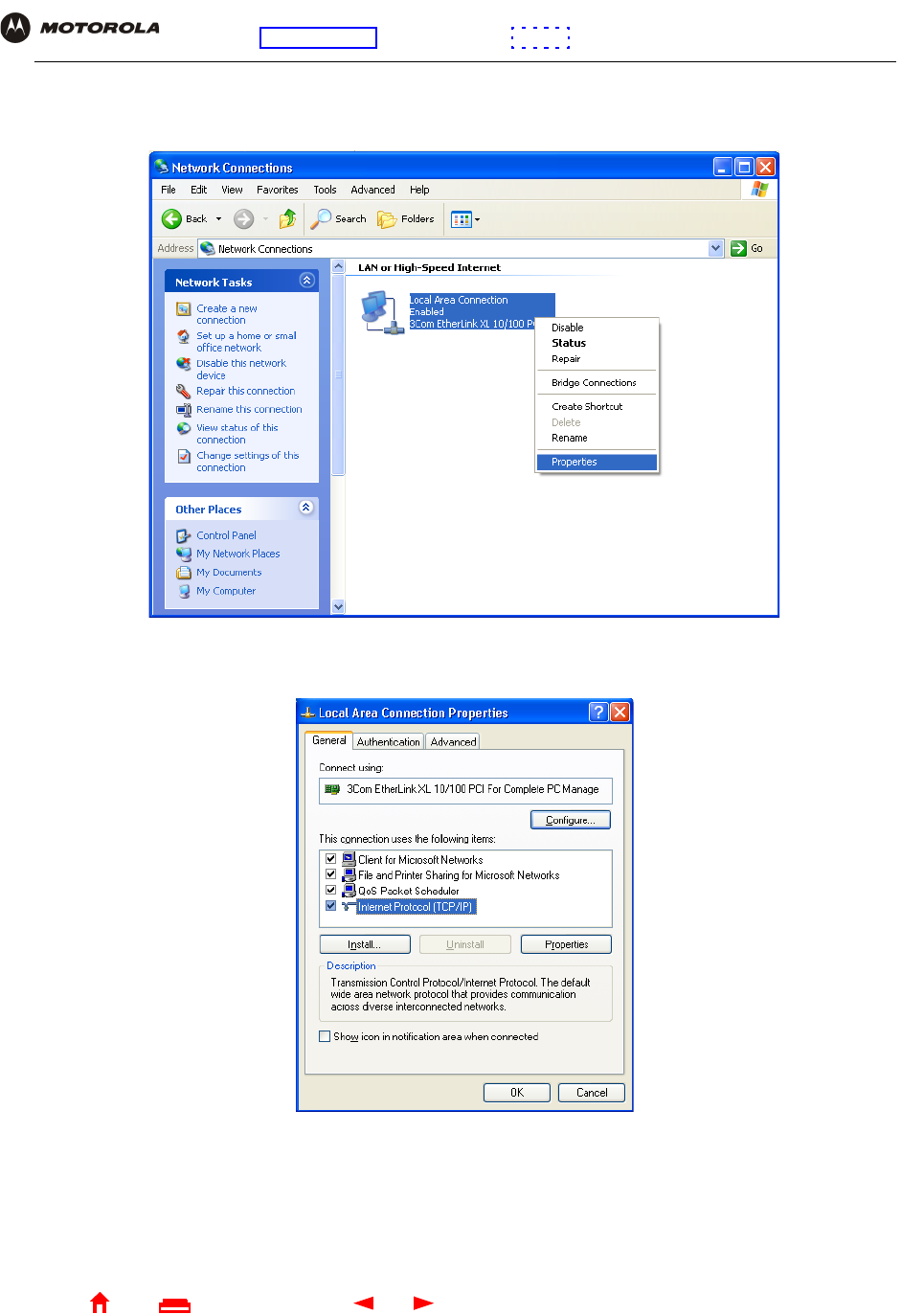
62 SBG1000 Wireless Cable Modem Gateway User Guide
Home
X
E
xitPrint
Overview Installation Troubleshooting Contact FAQ Specifications Glossary License
Configuration: Basic Gateway TCP/IP Wireless Print Server USB
6Right-click on the network connection. If more than one connection is displayed, be sure to select the one for
your network interface:
7Select Properties from the pop-up menu to display the Local Area Connection Properties window:
8On the Local Area Connection Properties window, be sure Internet Protocol (TCP/IP) is checked. If it is not
checked, check it.
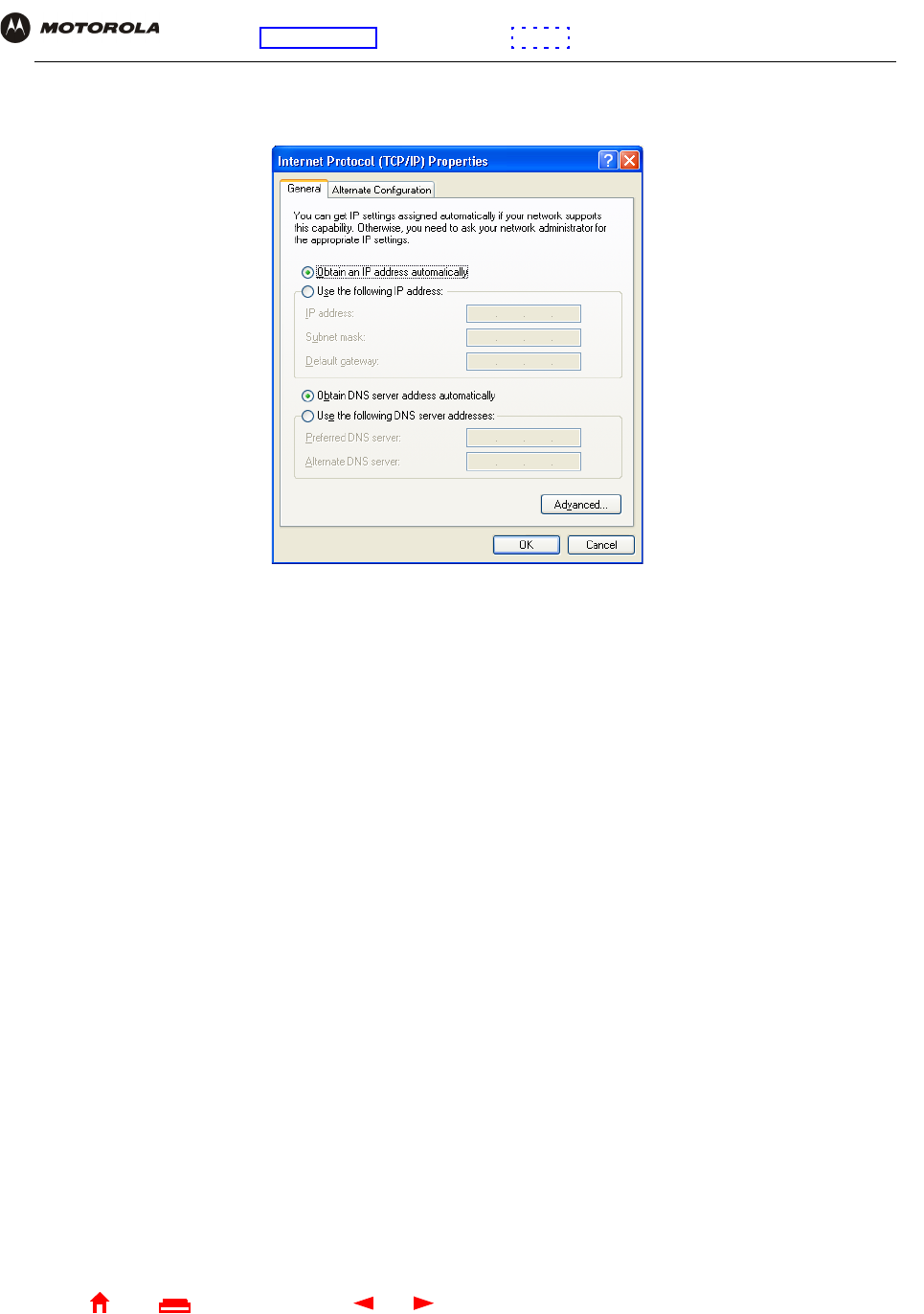
63 SBG1000 Wireless Cable Modem Gateway User Guide
Home
X
E
xitPrint
Overview Installation Troubleshooting Contact FAQ Specifications Glossary License
Configuration: Basic Gateway TCP/IP Wireless Print Server USB
9Select Internet Protocol (TCP/IP) and click Properties to display the Internet Protocol (TCP/IP) Properties
window:
10 On the Internet Protocol (TCP/IP) Properties window, verify that the settings are correct, as shown above.
11 Click OK to close the TCP/IP Properties window.
12 Click OK to close the Local Area Connection Properties window.
When you complete the TCP/IP configuration, go to “Verifying the IP Address in Windows 2000 or Windows XP”
on page 65.
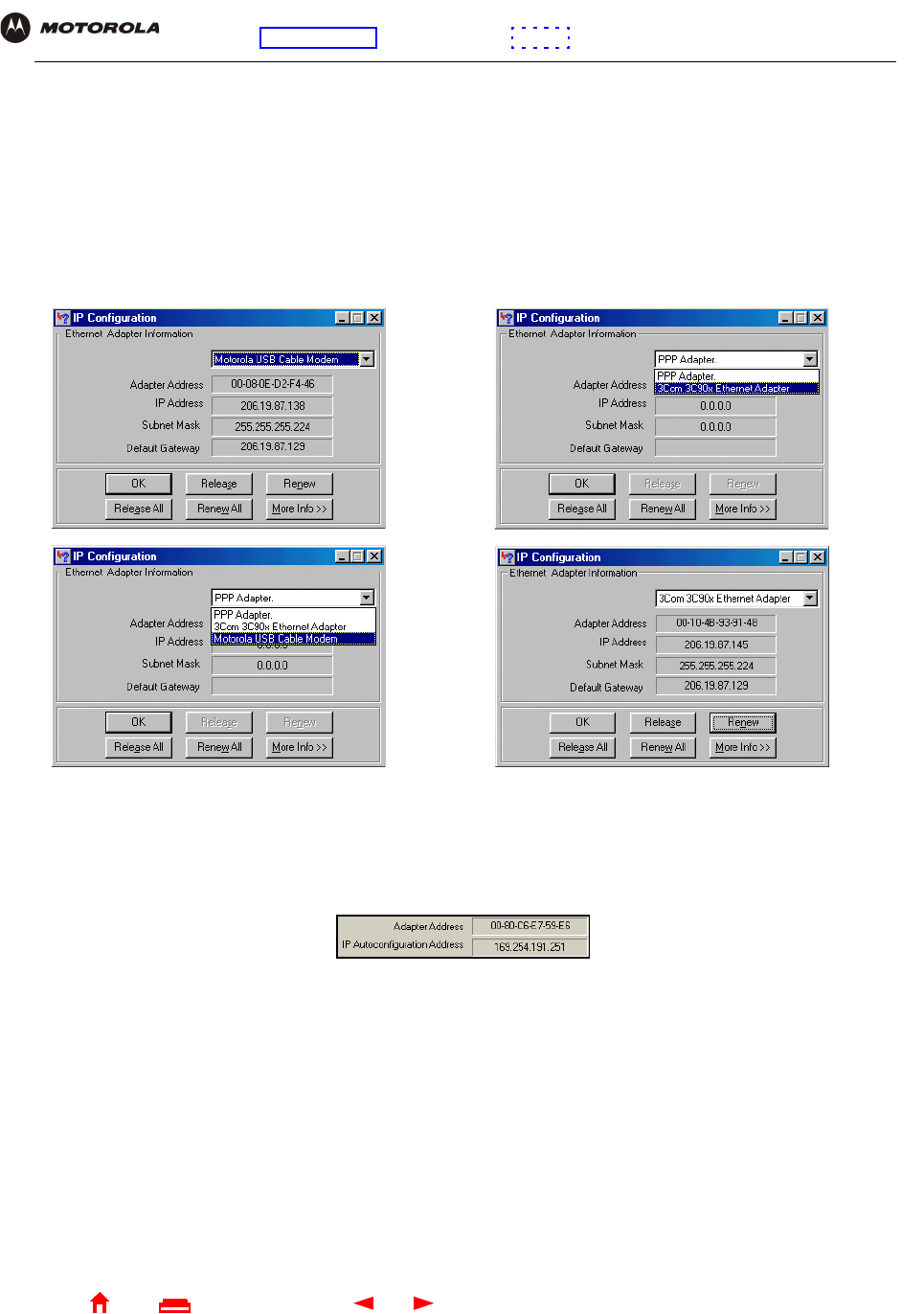
64 SBG1000 Wireless Cable Modem Gateway User Guide
Home
X
E
xitPrint
Overview Installation Troubleshooting Contact FAQ Specifications Glossary License
Configuration: Basic Gateway TCP/IP Wireless Print Server USB
Verifying the IP Address in Windows 95, Windows 98, or Windows Me
To check the IP address:
1On the Windows Desktop, click Start.
2Select Run. The Run window is displayed.
3Type winipcfg.exe and click OK. The IP Configuration window is displayed. The Ethernet Adpater
Information field will vary depending on the system, as shown in the following examples:
The values for Adapter Address, IP Address, Subnet Mask, and Default Gateway on the PC will be different
than in the image.
In Windows 98, if “Autoconfiguration” is displayed before the IP Address as in the following image, call your
service provider.
4Select the adapter name — the Ethernet card or USB device.
5Click Renew.
6Click OK after the system displays an IP address.
If after performing this procedure the computer cannot access the Internet, call your cable service provider for
help.
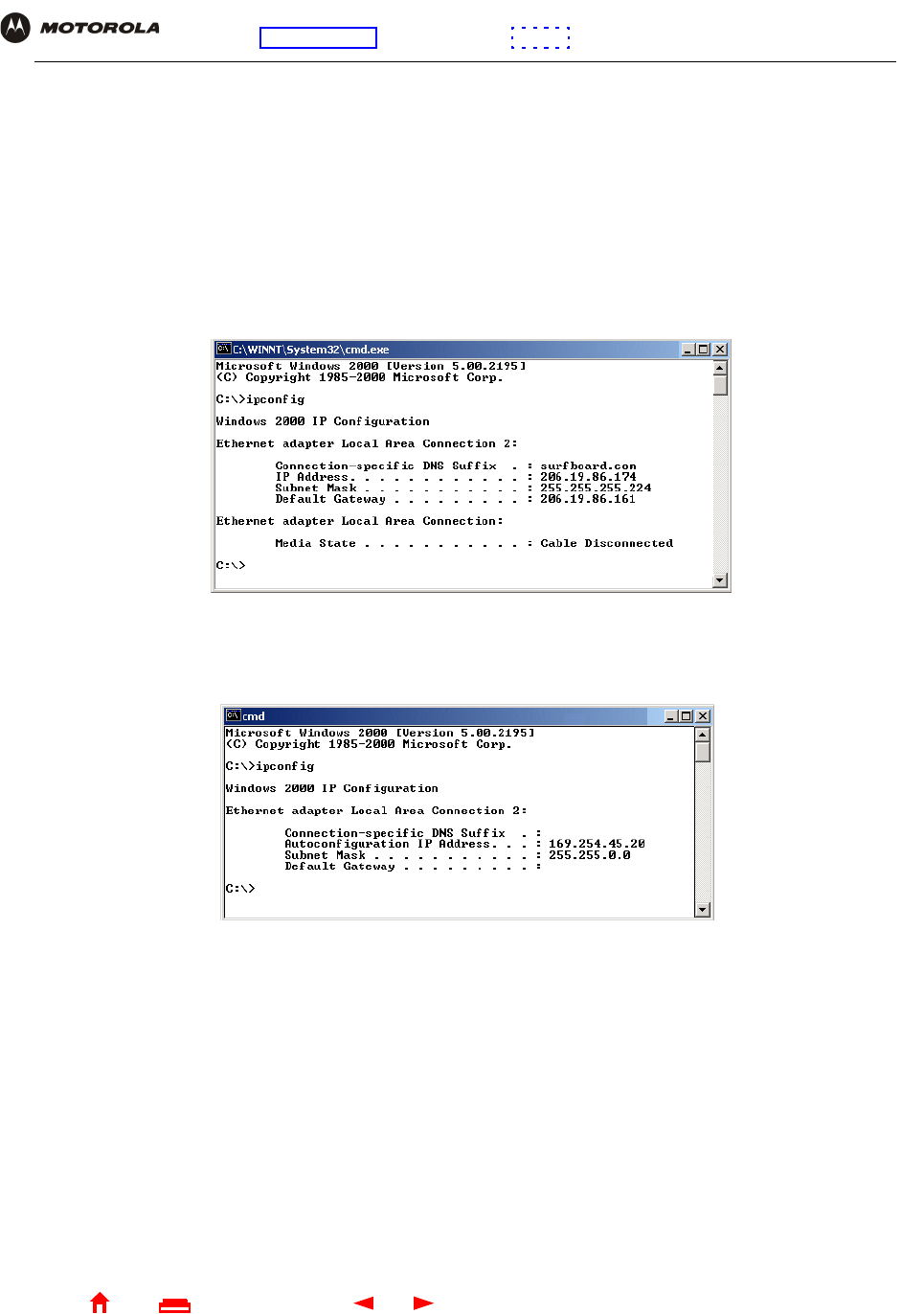
65 SBG1000 Wireless Cable Modem Gateway User Guide
Home
X
E
xitPrint
Overview Installation Troubleshooting Contact FAQ Specifications Glossary License
Configuration: Basic Gateway TCP/IP Wireless Print Server USB
Verifying the IP Address in Windows 2000 or Windows XP
To check the IP address:
1On the Windows Desktop, click Start.
2Select Run. The Run window is displayed.
3Type cmd and click OK to display a command prompt window.
4Type ipconfig and press ENTER to display the IP configuration. A display similar to the following indicates a
normal configuration:
If an Autoconfiguration IP Address is displayed as in the following window, there is an incorrect connection
between the PC and the SBG1000 or there are cable network problems. Check the cable connections and
determine if you can view cable-TV channels on your television:
After verifying the cable connections and proper cable-TV operation, renew the IP address.
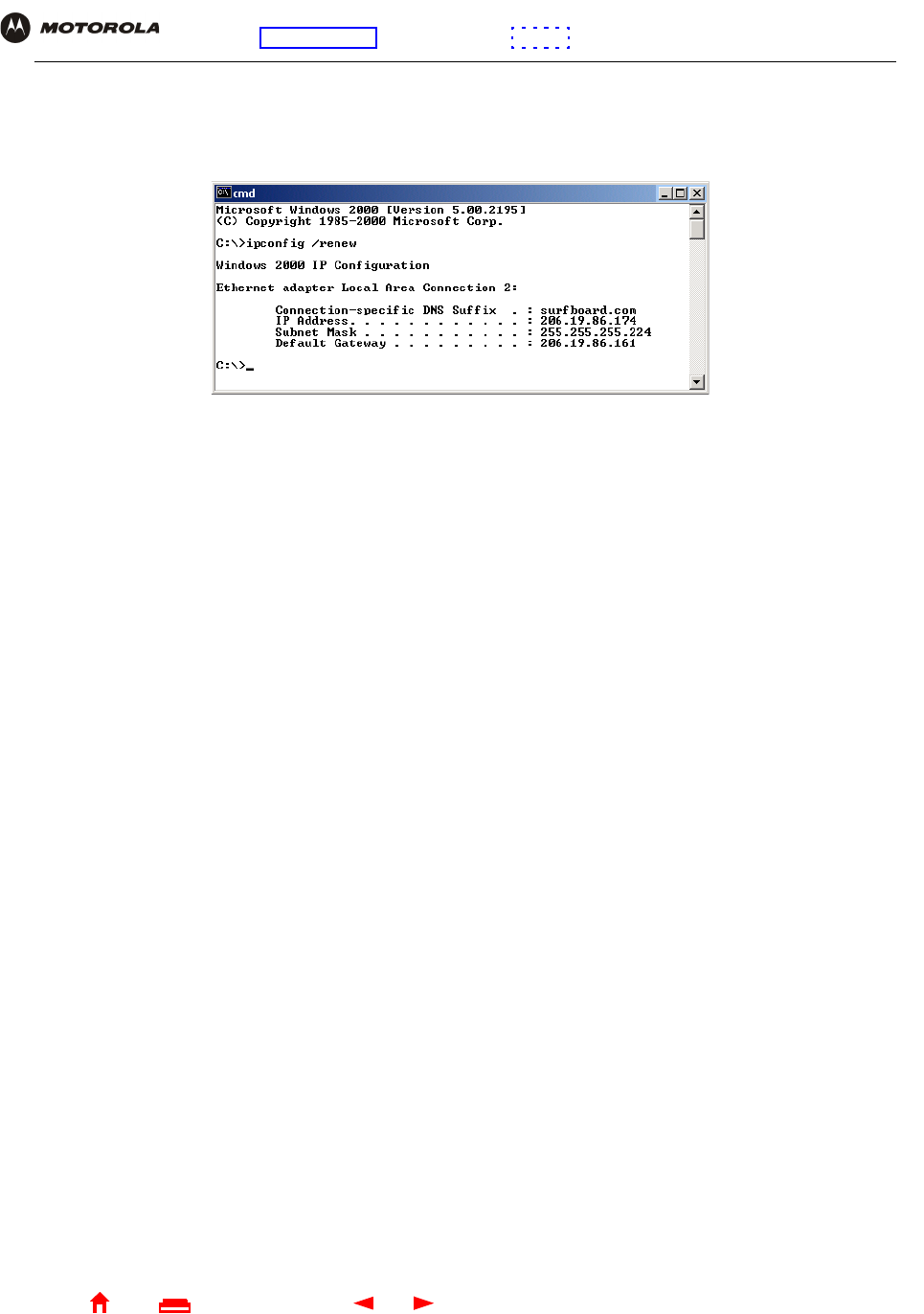
66 SBG1000 Wireless Cable Modem Gateway User Guide
Home
X
E
xitPrint
Overview Installation Troubleshooting Contact FAQ Specifications Glossary License
Configuration: Basic Gateway TCP/IP Wireless Print Server USB
To renew the IP address:
1Type ipconfig /renew and press ENTER. If a valid IP address is displayed as shown, Internet access should
be available.
2Type exit and press ENTER to return to Windows.
If after performing this procedure the computer cannot access the Internet, call your cable service provider
for help.
